




























































































































THE LOW IMPACT COASTAL SEGMENT SEEKS TO REINVENT ITSELF









































THE FISH TRADE embraces digitalisation— gradually
INTERVIEW WITH FAO’S Audun Lem as GLOBEFISH turns 40 54
UKRAINIAN trader adapts by replacing seafood products with meat




















































































































































THE LOW IMPACT COASTAL SEGMENT SEEKS TO REINVENT ITSELF









































THE FISH TRADE embraces digitalisation— gradually
INTERVIEW WITH FAO’S Audun Lem as GLOBEFISH turns 40 54
UKRAINIAN trader adapts by replacing seafood products with meat
























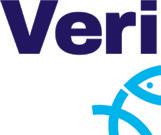


e low impact coastal shery in Denmark is characterised by vessels up to 17 m using gears such as gill nets, hooks, traps, fyke nets, and Danish seines that have minimal impact on the environment. e association cum producer organisation representing this segment promotes the interests of its members through its participation in Danish parliamentary committees, where it ghts to prevent small harbours from shutting down. At the European level the association has aligned with similar bodies in other countries to create awareness and further their agenda. Read more on page 32
e colour of salmonid esh varies from o white to deep red depending on the astaxanthin content of the feed. Astaxanthin is a plant pigment also found in phytoplankton and some crustaceans from where it makes its way up the food chain. Apart from imparting colour to salmon esh the pigment is also an antioxidant that prevents the fats in muscle meat from breaking down. In the body, some of the pigment is also converted into vitamin A which has anti in ammatory e ects. Astaxanthin may also have a bene cial e ect on the reproductive performance of salmonids. Read Dr Manfred Klinkhardt’s article about this important pigment from page 15
VeriFish, a Horizon-EU project, of which Euro sh is a partner, aims to encourage consumers to consider sustainability when they shop for sh and seafood products. To do this project partners will develop a set of veri able indicators on the health bene ts, sustainability, and climate impacts of di erent seafood products. ese indicators are expected to assist individual consumers, but also commercial enterprises, and policymakers, take decisions about consumption of sh and seafood. An app will be among the tools developed to promote use of the indicator framework. See more on page 23














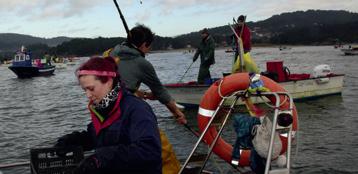
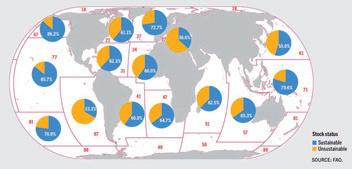
e Estonian shing sector comprises several segments including the coastal shery, Baltic eet, the distant water vessels, and the inland eet. e pelagic species, Baltic herring and sprat, are the most important in terms of volumes and ensure Estonia is self su cient in the production of sh. Unit value of catches is highest for the distant water eet which targets species like red sh, northern prawn and Greenland halibut. But falling total catches present a challenge to the industry. One way of addressing it is by adding more value to the raw material. Read more on page 37
Improving the marine environment is one of the ways of increasing the resilience of sh stocks and researchers in Denmark are therefore studying the positive impacts of arti cial reefs. ese structures create breeding grounds and nurseries for many marine species which, in a virtuous cycle, attracts more sea life to the area, thus augmenting biodiversity. However, these developments do not happen overnight—timespans of a decade or more are common when it comes to the biological maturing of a reef. e researchers are also comparing the performance of reefs made of natural material with reefs of concrete. Read more on page 44
Women account for approximately a quarter of the employment in the sheries and aquaculture sector, where data is available. Large fractions of data from the sector (38 in marine sheries, 40 in aquaculture) do not disaggregate by sex, reports the FAO. While conditions for women have improved, they still lag men in terms of the proportion in full time employment and in wages. Women in the sector are also more exposed to violence. AKTEA is a European network that is trying to remedy some of the ills that a ict women in sheries and aquaculture. Read more on page 48
Data collected by FAO on capture sheries represents a huge and complex task with inputs from 240 countries, 26 shing areas, and covering 2,200 n sh species. Analysis of the data reveals that just under two thirds of resources are being shed sustainably, down from nine tenths in 1974. However, data collection remains a challenge in many countries, an issue that was discussed at a series of FAO-organised meetings in 2022. FAO is working to mobilise the resources to improve the situation, but until then relies on estimates using approved methodologies. Read more on page 50
6 International News
12 AQUA 2024, 26-30 August 2024, Copenhagen
Copenhagen is the place to be in late August!
14 Pavilion of Denmark at AQUA24, Copenhagen, Denmark, 26-20 August 2924
Danish cooperation and innovation for a stronger global aquaculture
15 A strong red colour is considered an important feature in terms of quality
The colouring of fillet impacts salmon sales
20 Italian startup deploys biotechnology to create better aquafeeds
Improving feeds through the use of insect meal
23 VeriFish seeks to improve sustainable seafood practices
Empowering consumers to make informed choices
27 Denmark must develop even further as a producer of high-quality food
Sustainability is both environmental and economic
29 Blue Rock combines angling ponds with noble crayfish production
Crayfish for consumption and restocking
32 The Danish coastal fishery faces challenges but also opportunities
Adapting to new realities
35 A Danish vocational school exploits the climate and health benefits of macroalgae
Promoting seaweed consumption to the masses
37 The fisheries sector plays multiple roles in Estonian society
Resilient in the face of threats
41 Consumption trends of fish and seafood in Estonia
High prices are a deterrent


















































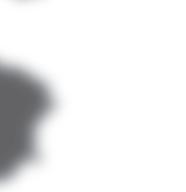




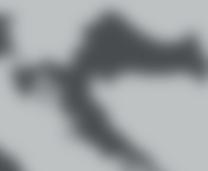




























Cover picture courtesy: Aris Adlers




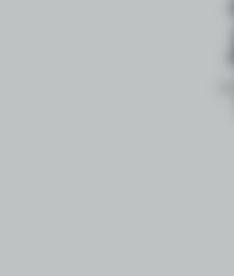







42
Dam-mapping exercise contributes to improving situation for fish fauna
Healthy fish stocks depend on accessible spawning grounds




















































44 Two projects seek to shed light on artificial reefs’ impact on biodiversity
Marine restoration in Danish coastal waters
48 AKTEA fights for the rights of women in fisheries and aquaculture
Supporting gender equality across Europe
50 More overfishing despite increasing sustainability? FAO analyses depend on estimates




































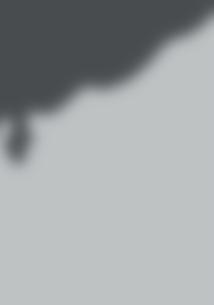

54 Are digital trading platforms for fish worth it? Internet sales expand marketing opportunities


58 Brim sees innovation as key to meeting its commitments Affecting every aspect of the company








60 Ukraine’s seafood business: Impacts of Russia’s war against Ukraine Hostilities affect ratio of meat and fish products



Four decades of analysing the global market for farmed and wild aquatic products

Invasive species of crayfish native to America have been slowly spreading in the freshwater bodies within countries bordering the Baltic Sea, but now the problem has taken a critical turn. The invasive species, starting with signal crayfish but recently joined by at least three other nonnative species, are similar in many respects to the Baltic region’s native European crayfish (Astacus astacus) except in one potentially disastrous respect: they carry a plague to which they themselves are immune but causes a nearly 100% mortality rate for the European species. Scientists in Estonia are struggling to find preventive measures to save European crayfish. The largest problem is the signal crayfish (Pacifastacus leniusculus), which first appeared in Estonia in 2008. Another invasive species, the colourful marbled crayfish, is believed to have been released by pet owners, while other species may have invaded from ship ballast discharges. They are all immune to the plague.
Researchers at Estonia’s University of Life Sciences have fought the
crayfish invaders—and the plague they carry— for years without success, using a variety of tools. Poison has been tried, but in flowing freshwaters that signal crayfish prefer, the poison is merely dissipated. Nets like those used to harvest local crayfish do not capture young invaders that escape.
“Electro-fishing,” which sends jolts of energy into the water, doesn’t reach the crevices in rocks where crayfish dwell. More promising efforts include using eels to find and eat small crayfish in tiny hiding places, while the larger ones can continue to be trapped. But the trapping must be more intensive than now, the researchers say, and more public support is required. “The problem is becoming increasingly serious each year,” says Katrin Kaldre, a junior professor of aquaculture biology at the University of Life Sciences. “We practically discover a new signal crayfish outbreak every year.”
The project at the University of Life Sciences includes a public awareness campaign. “We taught in schools and at festivals how
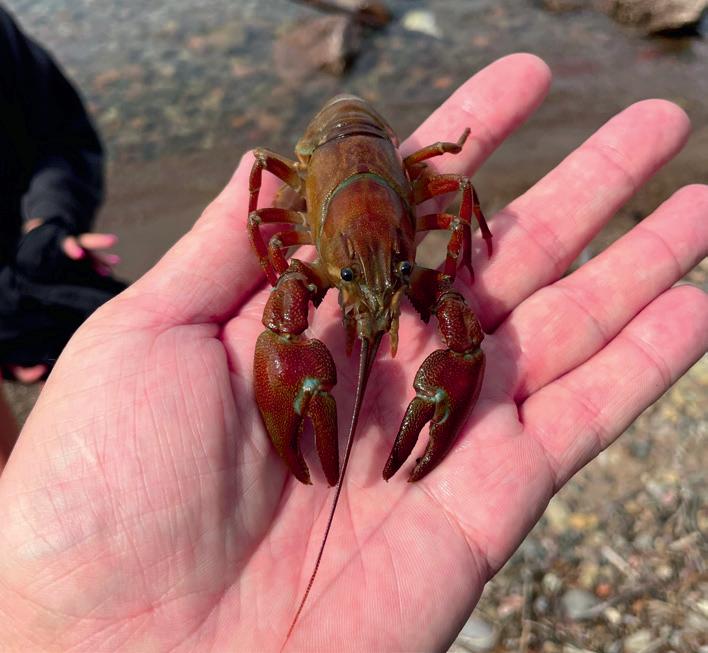

Signal crayfish were first introduced to Sweden in 1960 and quickly spread to other European countries. They were chosen because they were resistant to crayfish plague and considered a viable alternative for aquaculture. Signal crayfish are highly competitive and aggressive, leading to the displacement of native crayfish species.
to distinguish between different crayfish species,” says Kaldre. “It’s important to raise awareness that not all crayfish are the same; you cannot simply move them from one body of water to another.
Such actions have consequences.” People walking near water bodies are encouraged to photograph any crayfish they observe and report them through the national information phone line 1247.
The Fishery Research Center of MATE AKI (HAKI) hosted the 48th Fisheries Scientific Consultation in Szarvas on June 5-6, 2024. As a premier event for Hungary's aquaculture sector, this annual gathering highlighted innovative development opportunities crucial for domestic fish farming. This year's conference was particularly timely, aligning with the forthcoming MAHOP Plusz initiatives and Hungary's presidency of the Council of the European Union (1 July – 31 December 2024), which entails significant fisheries management responsibilities.





























Discussions, presentations, and speeches at this year’s Fisheries Scientific Consultation, an annual conference in Hungary, focused on innovative developments in the fish farming sector.
Reflecting the importance of these themes, the event attracted nearly 170 attendees over the two days. During the plenary lectures György Zsolt Papp, Deputy State Secretary responsible for rural development programs and head of MAHOP IH, presented the planned measures under the MAHOP Plusz program. Mónika Bojtárné Lukácsik, group leader at the Institute of Agricultural Economics, detailed the importance and background of the Data Collection Framework (DCF) for fisheries, which is being initiated as part of MAHOP Plusz. Péter Lengyel, fisheries attaché for the Ministry of Agriculture at the EU,

discussed the future development possibilities for aquaculture in relation to the upcoming EU presidency period.
A highlight of the event was the round-table discussion, where experts from HUNATiP and other participants collaboratively explored innovation opportunities and challenges in the domestic aquaculture sector. The discussion underscored HUNATiP's commitment to integrating Hungarian aquaculture into European innovation processes, particularly in precision farming, process regulation, and digitalization. These innovations
Consistent overfishing of Northeast blue whiting, a principal ingredient in salmon feed, threatens the environmental certification of the species. The loss of this certification would, in turn, risk the certification of fish production dependent on such feed and will cost consumer sales, as told by an array of firms involved in feed and salmon farming to the governments of Norway and the Faroe Islands. The European Commission has accused Norway and the Faroes of refusing to meet and agree on country-specific allocations of the overall quota on the blue whiting stock that is set based on advice by the International Council for the Exploration of the Seas (ICES), the body which the EU and other fishery management authorities rely on for sound biological advice as to resource stock conditions. Other concerned harvesting nations, including other EU Member States and the UK, follow such
are vital for enhancing the sustainability, competitiveness, and resilience of fish farming. The dialogue emphasized that innovation is crucial for the successful implementation of the MAHOP Plusz program. Following the plenary sessions and round-table discussion, domestic and international researchers presented their latest findings and innovations through scientific lectures and posters. The conference featured several sections, including technology and feeding; reproductive biology and genetics; fish health and hydrobiology; and a new focus on the societal and environmental aspects of fish
farming. This interdisciplinary approach was well-received, offering comprehensive insights into the various facets of aquaculture research.
The 48th Fisheries Scientific Consultation in Szarvas once again proved to be a significant event for the aquaculture community, fostering knowledge exchange and highlighting the critical role of innovation in the future of fish farming. The discussions and presentations at the conference have set the stage for substantial advancements in the sector, aligned with national and European strategic objectives.
quota advice on blue whiting, while the two offenders have refused to agree on their countryspecific quotas from the total fishery quota for all countries and continue to heavily fish the resource.
In such criticism, the EU has been joined by the Northeast Atlantic Pelagic Advocacy Group (NAPA), an alliance of more than 70 companies including salmon farmers Mowi and Scottish Sea Farms, retailers Asda, Marks & Spencer, Tesco, Waitrose, Morrisons, Aldi, and Co-op, and feed producers Cargill, BioMar, Skretting, and Cooke Aquaculture-owned Northeast Nutrition.
NAPA blames Norway and the Faroes for their farmers and feed producers facing the prospect of refusing blue whiting because of the fishery’s loss of sustainability certification by the Marine Stewardship Council’s “Blue Label” mark of approval. This ultimately

The history of blue whiting (Micromesistius poutassou) utilisation highlights its transition from a bycatch species to a crucial resource for both human consumption and aquaculture feed.
risks the loss of certification of salmon grown with feed from this blue whiting fishery. In turn, a loss of salmon certification will alienate a large segment of European consumers for whom environmental certification is a priority when buying seafood. NAPA is joining the EU Commission in pressuring the two violating countries to improve their fishery management
activities to align with their responsibilities: in particular, to agree to stop overfishing their blue whiting resource. Charlina Vitcheva, the EU DirectorGeneral for Maritime Affairs and Fisheries, said direct blame for the certification status of the blue whiting stock lies with Norway and the Faroe Islands, while other countries have not acted irresponsibly.

Seals everywhere are voracious competitors for the fish that humans catch and farm. They are marine mammals and are thus protected by the EU and other governments around the world, protections which date back decades to when marine mammal populations were depleted. But for seals at least, this is no longer a problem for them, it has become a problem for harvesters. Seals’ burgeoning numbers are causing serious damage to fishermen and aquaculture. In Latvia, seals eat 2-3 times as many fish as fishermen catch, often taking mortal bites out of fish that die a wasteful death or spread the resulting infection in their wounds to other fish. They also tear up nets and allow escapements. In Latvia and other Baltic countries,
fishermen are compensated for lost fish and damaged gear, “But,” says Normunds Riekstiņš, director of Latvia’s Fisheries Department at the Ministry of Agriculture, “of course this is not a solution and, in principle, more and more compensation has to be paid and less and less is caught.”
Fishermen and their representatives have worked for decades to find solutions to the seal problem, but it keeps growing. Recently, an association of 74 Latvian harvesters, Mazjūras zvejnieki, has stepped up pressure on government with a proposal to allow some harvesters the right to kill seals, enough to partly alleviate the problem and the damage that seals cause. The idea is to


limit the seal hunt to those which come in close proximity to harvesting gear and fish. Cīrulis, a representative of coastal fishermen, claims that Latvia is the only country where fishermen are not allowed to hunt seals. In Estonia, for example, protective hunting is allowed. Support from authorities responsible for the environment would be helpful to their cause, and decisions on proposals to allow seal hunting are under consideration by Latvia’s Nature Conservation Agency and other responsible authorities.
FISH4ACP has announced the Blue Food Forum in Dar es Salaam, Tanzania, to be held 12-13 September 2024. The global forum will focus on sustainable practices in aquatic food value chains. Supported by the Organisation of African, Caribbean and Pacific States (OACPS), the Food and Agriculture Organization of the United Nations (FAO), the European Union (EU), and the German Federal Ministry for Economic Cooperation and Development (BMZ), FISH4ACP pursues sustainable fisheries and aquaculture in Africa, the Caribbean, and the Pacific (ACP). The Blue Food Forum contributes to this mission by utilising momentum generated by the 2021 UN Food Systems Summit, which inspired global interest and action in transforming food systems. The forum enables FISH4ACP and related
initiatives to share their knowledge with partners, value chain experts, representatives, and supporters. Simultaneously, discussions regarding the national and global pathway to developing a sustainable aquatic food value chain will be encouraged.
FISH4ACP established three ideal outcomes of the Blue Food Forum. First, to understand how aquatic food value chain development intersects with the goals of the UN’s 2030 Agenda, the European Union’s Green Deal, FAO’s Blue Transformation agenda, and other international policies geared toward sustainability; to build on successes and learn from past experiences in aquatic food chain development in order to identify opportunities for expansion; and, lastly, to identify effective avenues for investment that

will increase aquatic food value chain development. Innovation in their value chain approach, FISH4ACP found, has carved a path toward sustainable fisheries and aquaculture in the ACP region that promotes inclusivity, food security, and minimal environmental impact. Collaboration with both local communities and stakeholders is integral to understanding how aquatic food

value chains promote economic, sustainable, and social growth across the world. At the Blue Food Forum, attendees will explore this approach through panel discussions and opportunities to engage with stakeholders.
Further updates and information on the Blue Food Forum can be found on the FISH4ACP website at www.fao.org/in-action/fish-4-acp.

Exporting feed, equipment, and solutions to the global aquaculture industry is an important part of the Danish economy. Therefore, it is crucial that the industry has the best conditions to ensure continued development towards increasingly sustainable food production based on the best and most energyefficient technologies.
To strengthen the overall voice of aquaculture and create the best possible coherence for the players in Danish aquaculture, the two member organizationsDanish Export Association and AquaCircle - have merged and now will operate under the name Danish Export - Fish Tech. This ensures that all relevant players in the industry now have a single entry point for export promotion,
commercial activities, and political advocacy.
The export network Danish Export - Fish Tech brings together Danish feed, equipment, technology, and service suppliers within aquaculture, including turnkey suppliers of systems, manufacturers of small components, feed producers, and suppliers of processing equipment. In addition to strengthening exports among companies by organizing export promotions and networking activities, the Danish Export Association will now also play a more prominent role in political advocacy with the merger with AquaCircle.
It is important that we can ensure the best possible conditions for industry players by creating a stronger voice together.
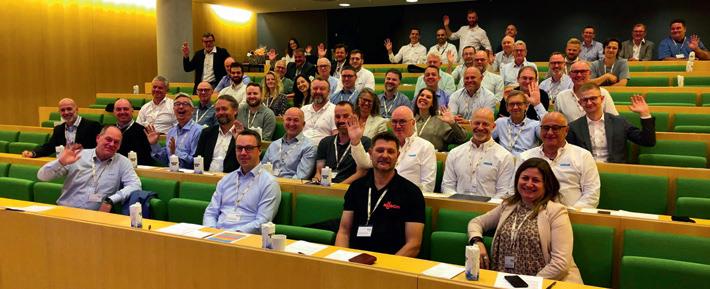
The merger between AquaCircle and Danish Export – Fish Tech was announced at an aquaculture networking meeting in Copenhagen and organized by Danish Export – Fish Tech.
Our members in Danish Export – Fish Tech are dependent on a strong aquaculture industry in Denmark to be able to develop in the export markets. Therefore, I am pleased that through the merger with AquaCircle we can also create a stronger political voice, says Martin Winkel Lilleøre, Head of Fish Tech at Danish Export Association.
Martin Winkel Lilleøre, Head of Fish Tech, Danish Export Association, maw@danishexport. dk, +45 60 20 85 57
Mette Kristensen, PR & Communications Consultant, Danish Export Association, mek @danishexport.dk, +45 28856430
The exclusive economic zone (EEZ) of a country is a maritime boundary it sets, under the auspices of the UN Convention on the Law of the Sea (UNCLOS), seaward from its land border to 200 nautical miles from shore or to the EEZ of a neighbouring state, whichever is less distant. Rights provided within an EEZ include management of fisheries. There are many disputed EEZs around the world where multiple countries claim a single overlapping area—which often results in fishery mismanagement when two countries’ rules conflict. Fortunately, there is one less problematic EEZ dispute thanks to a recent agreement between the Adriatic nations of Italy and Croatia. After years of noncooperation, ending in 2022 with an agreement
on paper (to be ratified by governments), the two countries agreed at a bilateral summit to each ratify the EEZ agreement, putting it into law in their land and at UNCLOS.
The long mismanagement and overfishing had brought key fisheries such as hake and nephrops in the northern Adriatic to the point of collapse. By the mid2000’s, the crisis drew in the General Fisheries Commission for the Mediterranean (GFCM) and the Food and Agriculture Organization (FAO) to assist with sustainable fisheries and aquaculture practices. The crisis had turned Croatia into a net fish importer from an exporter. “By defining this [EEZ] line,” said Croatian Minister of Foreign and European Affairs Gordan Grlić-Radman, “Croatia
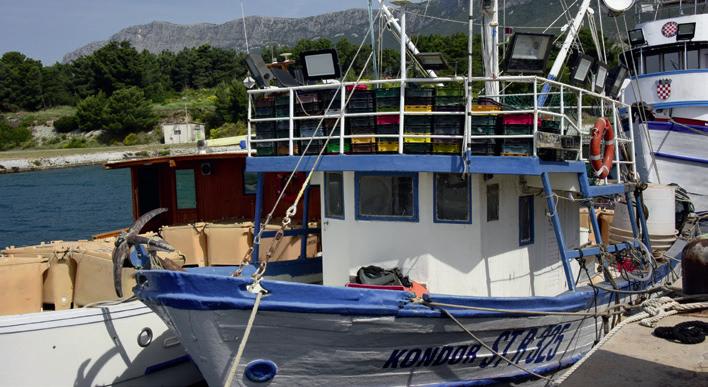
In 2022, Croatia had 7,501 vessels in its commercial fishing fleet, where small-scale coastal fishing boats less than 12 metres represented over 95%. However, the largest percentage of catches (up to 90%) are made by purse-seines that target small pelagic fish (sardine and anchovy), representing 3% of total fishing vessels. Pictured, a Croatian fishing vessel.
and Italy will reinforce their cooperation in the Adriatic Sea, as well as our common cultural, historical, geopolitical heritage.” The

arrangement includes a fisheriesrestricted area (FRA) called the Jabuka/Pomo Pit. “The Jabuka/ Pomo FRA has been promoted
as an example of best practice in fisheries management and an example that needs to be followed in all steps, noting that its

effectiveness also rests on the fact that all stakeholders supported its proclamation as a joint initiative in the region,” GFCM
The 17th edition of Polfish —the only trade fair in Poland and one of the largest in Central and Eastern Europe focused on the fish industry—is coming up. Among the exhibitors at the fair, are Polish leaders in imports and processing of fish and seafood from fresh, smoked, salted, and frozen to ready-to-eat. Manufacturers of processing equipment—cutting, filleting, smoking, packaging, and refrigeration—producers of systems for maintaining cleanliness at processing plants, catering facilities, and shops, manufacturers of flooring and drainage systems, providers of consultancy services, processing plant designers, producers of fish shop equipment, and distributors of health and safety
products will also be in attendance. The full list of exhibitors is available at: www.polfishfair.pl.
Polfish draws thousands of local and international visitors, including owners and managers of retail and wholesale stores, supermarket chains, discount stores, HoReCa sector, and more. The event brings together key players in the fish industry to create an arena for sharing experiences, showcasing innovations, and establishing strategic partnerships. An important part of the exhibition is the business programme. Participants can take part in conferences, debates, and discussions, as well as award ceremonies for the Mercurius
Fishery Officer and Subregional Coordinator for the Adriatic Sea Marin Mihanović explained. Officials hope that ratification of this agreement will inspire other Mediterranean countries entangled in similar disputes to follow suit.
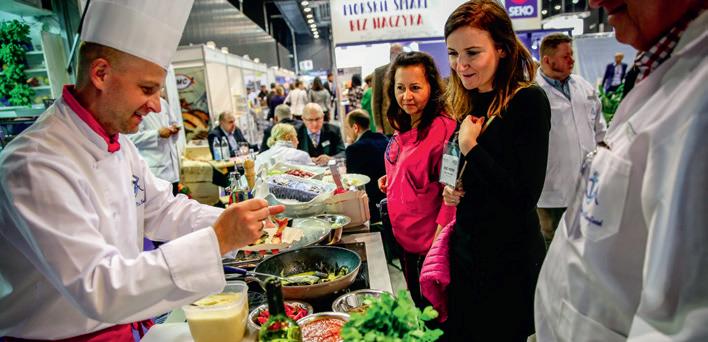
As at previous editions, the best Polish chefs will surprise the audience with innovative and trendy fish dishes.
Gedanesis competition, where the best products in the categories Fish Product and Technology will be awarded. Polfish is an important event for the industry and a meeting place for professionals from Europe and beyond.
The deadline for booking the exhibition space is 2 August 2024. More information at: www.

polfishtargi.pl/en/applicationfor-participation/
About Polfish 2024: Dates: 11-13.09.2024
Opening hours: Wednesday and Thursday 10:00-17:00, Friday 10:00-16:00
Venue: AMBEREXPO, Żaglowa Street 11, Gdańsk, Poland
Further information: polfishtargi.pl
The small but energetic trade show Future Fish Eurasia—Turkey’s one and only seafood industry trade show—always attracts hundreds of buyers and sellers of fish, shellfish and the machinery and equipment needed to produce and process them for market. The 11th edition of this biennial event returns to its home at a 10,000 sq. m hall in the seafood city of Izmir, Turkey, on 10-12 October 2024.
The show attracts key players in both Turkey’s seafood industry and in fish-related businesses throughout the region, along the shores of mighty rivers, and across the four seas surrounding
Turkey: the Mediterranean, Black, Aegean, and Marmara. Besides globally-known fish farming companies producing the country’s famous seabream, seabass, rainbow trout, and sea trout, exhibitors in past events have included manufacturers of farming and harvesting machinery. The event features various types of equipment, industrial products, and business services needed to prepare and sell fish on the marketplace.
For European business people wishing to develop contacts for marketing Turkish seafood abroad, or to expand their own business in Turkey and the region, the 2024 edition of Future Fish


As Turkey’s only trade fair for the industry and the leading event in the region, Future Fish Eurasia is the gateway to emerging markets.
Eurasia is an ideal opportunity. Already, more than 200 exhibitors are signed up—the time to reserve a good booth is now, and to do that
(or to experience Future Fish Eurasia as an interested visitor), fill out the paperwork on the event’s website at www.future-fish.com.
TO Smárinn Kópavogur Iceland 2024 SEP
We look forward to welcoming you in September
The Icelandic Fisheries. Seafood & Aqua Exhibition hosts the latest developments from the industry showcasing new and innovative products and services, covering every aspect of the commercial fishing industry from catching and locating to processing and packaging, right through to marketing and distribution of the final product.

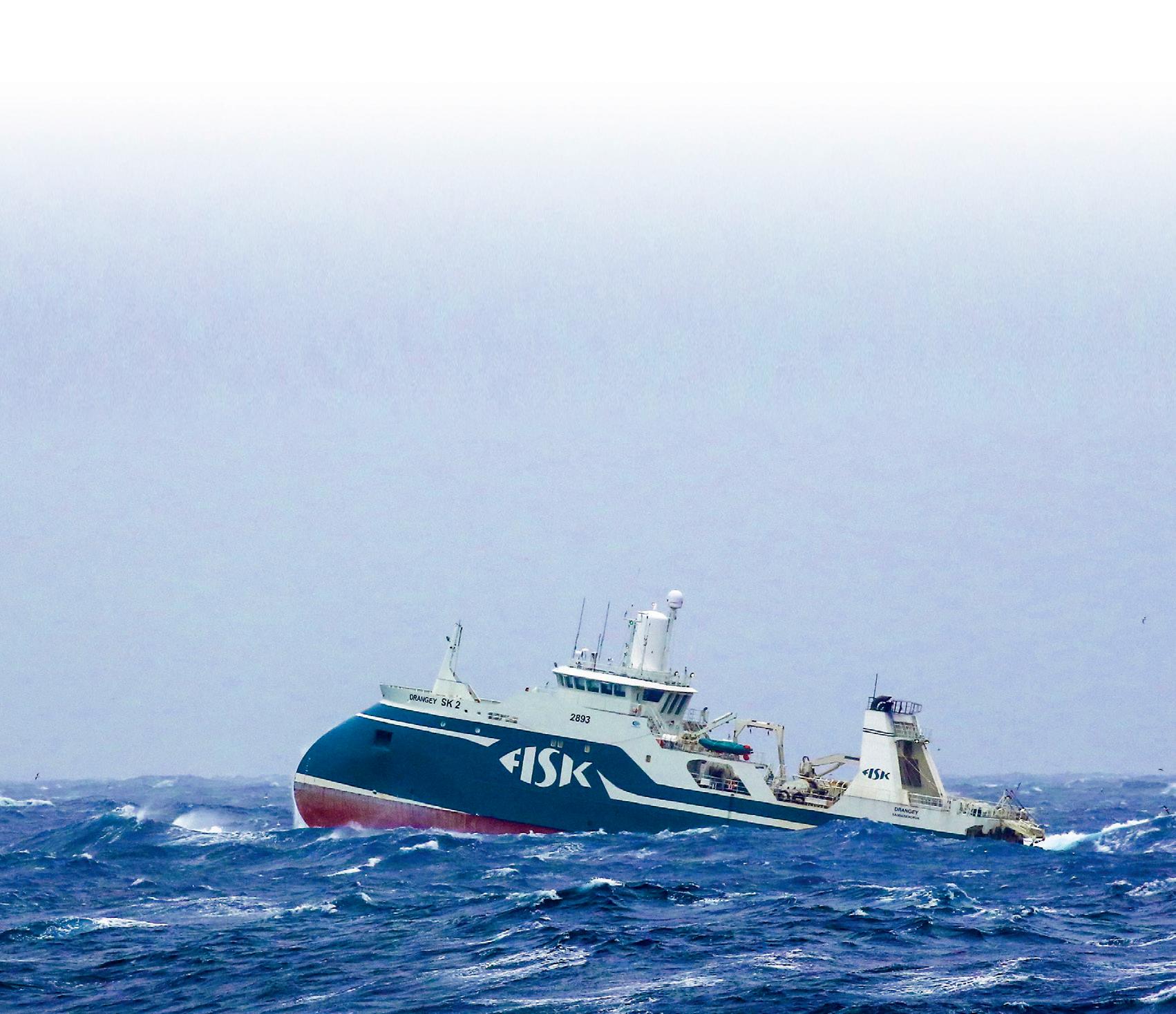




For more information about exhibiting, visiting or sponsoring, contact the events team
Visit: Icefish.is
Contact: +44 1329 825 335 or Email: info@icefish.is
AQUA 2024, 26-30 August 2024, Copenhagen
AQUA 2024 is co-organised by the European Aquaculture Society (EAS) and the World Aquaculture Society (WAS) and is held every six years. AQUA 2024 has been organised with the support of our local partners, the Danish Export Association Fish Tech, ICES, DTU AQUA, the University of Copenhagen, Eurofish International Organisation, and the Copenhagen Convention Bureau.
This year’s edition includes a scientific conference, trade exhibition, industry forums, workshops, student events, and receptions. The event will highlight the latest aquaculture research and innovation to underpin the continued growth of this sector. It will be a showcase for Denmark and its innovation leadership in several key technologies crucial for future aquaculture, but also a meeting and exchange platform
Dag Sletmo is a Senior Vice President of the Seafood Division at DNB - the leading bank in Norway and the largest bank globally in salmon farming with clients in Norway, the Faroe Islands, Iceland, Scotland, Canada, Chile, and Australia.
Prior to joining DNB, Mr Sletmo worked in Cermaq, the global salmon farmer, and ABG Sundal Collier, a Nordic investment bank. He holds an MBA from Columbia Business School in New York and has studied economics and philosophy at NHH and UiB in Bergen.
for experts from around the world. The total expected participation is 2500 attendees from 90 countries.
is the overarching theme
The scientific conference will include more than 60 sessions covering all aspects of aquaculture research. To put some

general highlights to the conference theme, the organisers included two special plenary sessions in the schedule.
On August 27th, Dag Sletmo from DNB will give an opening speech “Analysing the Future.” According to FAO, sustainable aquaculture must increase by 75% by 2040 to help limit global warming to 1.5 degrees C. Mr Sletmo will discuss the financial investments needed, focusing on new
Signe Riemer-Sørensen is Senior Researcher and Research Manager for Analytics and AI in SINTEF. Her research evolves around overcoming challenges for implementing machine learning and artificial intelligence in a broad range of industrial settings where physics plays a role and data is often sparse and noisy. The solutions integrate domain knowledge into the AI, in so-called hybrid AI, fostering robust, explainable and trustworthy models.
technology, improved practices, and regulations to boost production while reducing environmental impact. He will also address the industry’s reliance on government regulations and social license, and how to finance these initiatives, with a focus on salmon and general aquaculture.
On August 30th, the second plenary will be given by Signe RiemerSørensen from SINTEF, offering

her views on “AI with Knowledge.” Large language models have democratized AI. Co-pilots and chat-bots are changing most office jobs, but despite their impact, they will not revolutionize aquaculture. For that, we need completely different types of AI. Through examples from aquaculture and beyond, Ms Riemer-Sørensen will explain the challenges, provide intuitive insights into AI, and introduce the latest developments on industrial AI and their potential in aquaculture.
A regular feature of EAS events is the Industry Forum and the Innovation Forum, and these will take place during AQUA 2024.
The Industry Forum will be held all day on August 27 and will address the main event’s theme, with key questions about the status and future of the sector with regards to adaptation to climate change, mitigation of its effects, circular approaches, and other externalities.
The Innovation Forum, “Exploring Inter-Regional Collaboration & Innovation Transfer Vehicles for Aquaculture.” will be run all day on August 28. It will examine inter-regional collaboration for innovation transfer within EU policy and globally, featuring four sessions with presentations and discussions about the development of sustainable European aquaculture, practical implementation of innovation
transfer, the role of academic and research networks in such transfer, and strategies for its funding and facilitation.
AQUA 2024 will feature special sessions bridging science and industry, covering topics such as Atlantic salmon health assessment, the EUROshrimp Forum, future aquafeed supply chains, host resistance to sea lice, light effects on fish and other organisms, and IMTA with low-trophic aquaculture.
The AQUA 2024 exhibition will host more than 240 booths from suppliers and operators covering all aspects of aquaculture
production at the global level. All coffee breaks and happy hours will be held in the exhibition hall to maximise interaction between experts and visitors, of which some 1,400 are expected.
The organisers have arranged several tours on 26 August: to high-tech facilities at the Danish Technical University (DTU) National Food Institute, OxyGuard International’s Danish Headquarters, Marel Progress Point Global Demo Center, and to the Danish National Aquarium.
To find more information about AQUA 2024 and to register, please follow the link: https://www. aquaeas.org/





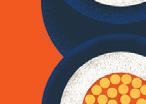







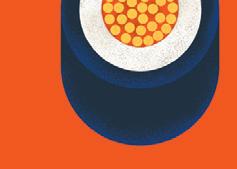


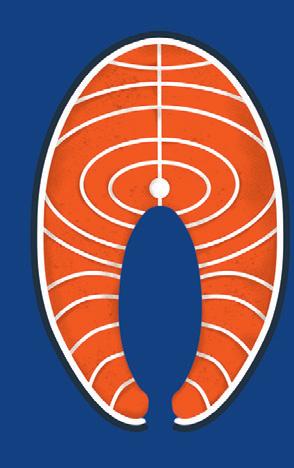


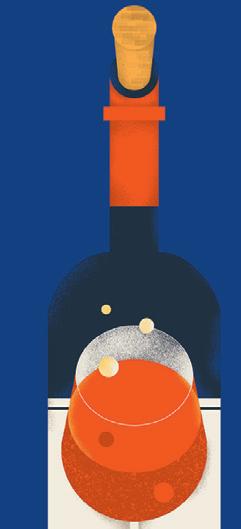


Pavilion of Denmark at AQUA24, Copenhagen, Denmark, 26-20 August 2924
Striving to provide the most efficient and sustainable solutions for global aquaculture, Danish companies have strong cooperation throughout the entire value chain and innovate continuously to meet the needs of fish farmers worldwide.
Each year the 200 Danish farms produce about 56,000 tons of farmed fish and shellfish. Since the domestic market is small, Danish companies supplying the aquaculture industry have been forced to compete internationally— something they have managed very successfully. From turnkey providers and feed producers to suppliers of pumps, filters, and fish processing equipment, Danish suppliers are highly recognized worldwide and have a strong position in markets abroad thanks to their energyefficient, sustainable, and highend solutions.
Sustainability and efficiency through decades of innovation and cooperation
Danish strengths such as sustainable solutions, energy efficiency, and high-end products are seen across industries and apply to aquaculture as well. And Danish suppliers strive for solutions that increase the sustainability of aquaculture. This takes knowledge and experience, strengths built upon years of close cooperation within the industry. Equipment manufacturers work closely with fish farmers and the turnkey providers, just as the feed producers collaborate with fish farmers to optimise their products for


The strengths of Danish suppliers lie in providing sustainable, efficient, flexible, durable, and innovative solutions for various industries, and for aquaculture in particular.
more efficient, sustainable, and disease-free farming.
As research and development require resources as well as skilled employees, Danish products might not be the cheapest on the face of it. But in the long run, Danish solutions might be the most cost-effective.
For instance, fish feed producers have developed feeds supporting higher seafood production. Technology providers bring the most energy-efficient and long-lasting solutions to the table, securing
lower energy consumption, less maintenance, and a longer life span, resulting in a lower total cost of ownership. Furthermore, processing equipment providers have developed machinery that not only handles the processing, packaging, and freezing of the product fast and efficiently, but also maximises the yield from the raw material.
As aquaculture output increases all over the world, Danish companies need to stay updated on markets and upcoming projects. Also in this process, the companies benefit from close cooperation throughout the value chain. For example, turnkey providers can introduce sub-suppliers to new
markets. But to stay relevant to the industry, Denmark needs to keep pushing to remain a leader in greener and more efficient solutions to benefit the whole aquaculture industry.
Danish companies will literally stand together at the AQUA 2024 exhibition in Copenhagen in August. The Danish Export Association organises the Pavilion of Denmark, gathering 27 companies from the whole value chain to meet new and old international business partners and to show the exhibition visitors what Denmark is all about.
A strong red colour is considered an important feature in terms of quality
Recently, I witnessed a strange incident while visiting the fish counter of my favourite supermarket when a customer was loudly complaining about the intense vermilion colour of a salmon fillet on display: “The salmon farmer has once again gone way too far and used far too much colour! The fillet looks completely unnatural!” The sales staff were overwhelmed by this situation. It would have been easy to take the wind out of the angry lady’s sails, as the fillet in question came from sockeye salmon, a wild Pacific salmon species that is not produced in aquaculture and is certainly not artificially coloured, but develops that deep red fillet colour solely through its natural diet.
However, this grotesque scene draws attention to a topic that is widely discussed and unfortunately often misunderstood by large parts of the public. Fuelled by social media and self-proclaimed experts, new claims and myths about the red colouring of salmon meat are constantly emerging. It is not uncommon for this to involve deliberate manipulation with food colouring and consumer deception. In the US, packaged farmed salmon must even be officially labelled with the phrase ‘added colour’ under FDA disclaimer guidelines, leading many consumers to believe that farmed salmon is somehow artificially coloured. In fact, both wild and farmed salmon get their colour in the same manner, i.e. exclusively from their diet. The red colouring of muscle meat is not caused by artificial colouring, but by carotenoid molecules, which also occur in nature. Of the more than twenty carotenoids found in salmon fillets, astaxanthin is by far the most important, as it accounts for over 70 per cent of the total pigment content in Atlantic salmon. Astaxanthin (the name is derived from the former Latin name of the lobster Astacus gammarus) is actually a plant pigment that
also finds its way into numerous animals through the food chain. It is found in yeasts, microalgae and other phytoplankton, carrots, many crustaceans such as krill, shrimp, lobsters and crabs, and even in the plumage of flamingos.
Colour sells when buying salmon
The red colouring of the salmon fillet is a typical visual feature of this fish, which is perceived by many consumers as a criterion of value and quality and is preferred when shopping. Intense red is often even considered an indication of naturalness. The preference for strong red is particularly strong in Asia, where it influences both the acceptance and the price of salmon products. The average astaxanthin content of Atlantic farmed salmon varies between 6 and 8 mg/kg of fillet meat. The Japanese market tends to favour wild Pacific coho and sockeye salmon, which have astaxanthin contents of up to 25 mg per kg of fillet.
Salmon and other salmonidae are among the few fish species that can store astaxanthin in its pure form. They store the pigments not only in their muscle meat, but also in their skin and
in their eggs, which then acquire a yellowish to orange-red colour and protect the embryos from overly intense UV light. The second important colouring pigment besides astaxanthin is canthaxanthin, which is also fat-soluble and comes either from natural sources (e.g. plants, fungi and crustaceans) or is produced synthetically, for example, as food
Kroma promotes a zero-waste policy







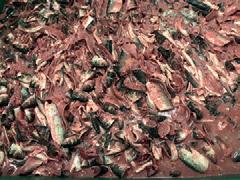
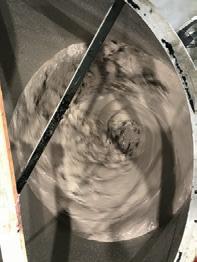

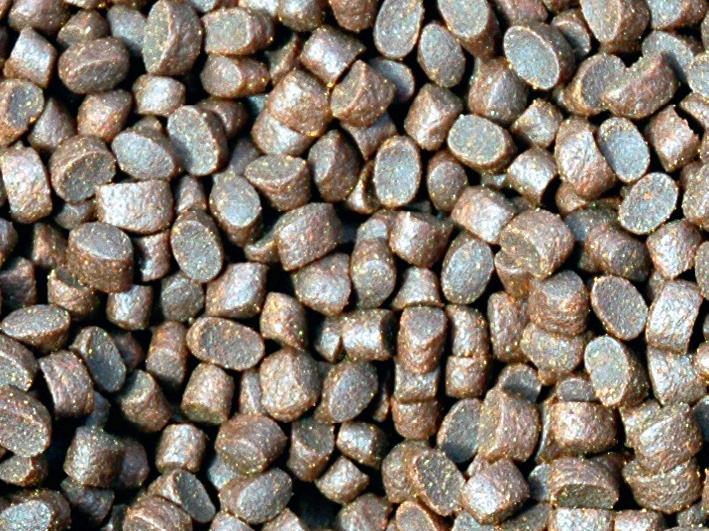
Astaxanthin, which is added to salmon feed to pigment the fillet, is now often synthetically produced.
additive E 161g. Canthaxanthin is a controversial substance that is suspected of having pathogenic effects and is therefore subject to strict limits. In natural products such as crustaceans, however, the amounts are so small that there is no risk to health. Furthermore, canthaxanthin may continue to be used in animal feed albeit in limited quantities. The Scientific Committee on Animal Nutrition of the European Commission has set the maximum concentration at 25 mg canthaxanthin/kg feed for salmonidae.
Astaxanthin and other pigments not only give salmon its red colour, but are also essential nutrients that ensure health and growth. For example, astaxanthin acts as a powerful antioxidant that protects the fats in muscle meat from breaking down, stimulates the immune system, and protects body tissue from oxidative damage. The antioxidant effect of pure astaxanthin is said to be 100 times stronger than that of vitamin E, which is contained in some human food supplements. Part of the ingested
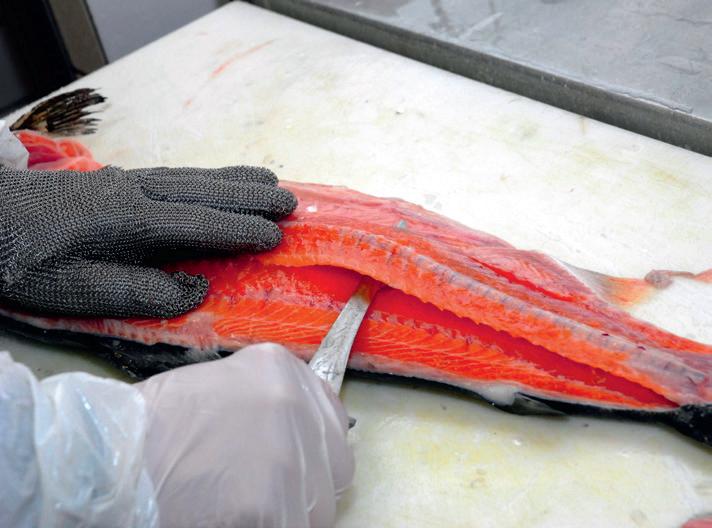
astaxanthin is converted in the body into vitamin A, which supports cellular respiration and has antimicrobial and anti-inflammatory effects. For example, tests on Atlantic salmon have shown that intestinal inflammation, which often occurs when soy bean meal is fed, can be prevented by adding the astaxanthin-containing microalgae Chlorella vulgaris to the feed. Astaxanthin is also believed to have a significant effect on the reproductive performance of many fish species, such as egg production and sperm quality, as well as the fertilization and survival rates of the eggs. Pigments are therefore much more than just simple colouring agents because they also have important biological functions.
The salmon cannot produce the red pigments themselves, only absorbing them through their food. In aquaculture today, most fish are fed formulated feed, which is a mixture of various components tailored to the needs of the fish. Many of these contain insufficient or partially destroyed carotenoids, as these pigments are extremely sensitive. They can lose their functionality due to high temperatures and
pressure during the preparation of the raw materials or incorrect storage of the feed pellets and must therefore be added from suitable sources when mixing the feed. This can perhaps be compared to the intake of nutritional supplements that some people use to supplement their diet. Astaxanthin, which is available over-the-counter at the chemists and elsewhere, brings health benefits not only to salmon, but also to humans. It has an antiinflammatory effect, increases the production of antibodies and the proliferation of immune cells. It is fairly well established that astaxanthin protects against stressrelated cardiovascular diseases, certain types of cancer and diabetes and helps prevent obesity. Preclinical studies suggest that astaxanthin can also regulate the gut microbiome. However, anyone who regularly eats salmon or other red-fleshed salmonidae can easily do without dietary supplements containing astaxanthin, as the fillet of these fish contains enough of these pigments. In addition to omega-3 fatty acids and highly digestible protein with all essential amino acids, this is an additional argument in favour of regularly eating these fish.
In principle, the carotenoids used in salmon feed can be produced from natural sources such as bacteria, fungi, algae and plants or from shrimp shell waste. However, this is complex and expensive (naturally-sourced astaxanthin is four times more expensive than the synthetically produced pigment). In addition, it would be very difficult to meet the immense demand of aquaculture from natural sources alone. This is why feed producers mainly rely on synthetically produced astaxanthin, which is nature-identical, fully biologically effective and very easy to dose. Carophyll Pink is particularly often used in salmon aquaculture as a colourenhancing feed additive, which has been on the market since 1988. It contains antioxidants and a colour-enhancing canthaxanthin carotenoid supplement that significantly increases the colour of the fillets and fish skin. At a dosage of 50 grams per ton of feed, a noticeable improvement in colour can be seen after just two weeks.
In recent years, the desire of many consumers for salmon

to be raised in a more natural, quasi-organic way has led to an increased search for natural sources of astaxanthin. The focus here is on microalgae, which produce pigments in addition to polysaccharides, sulfolipids and polyunsaturated fatty acids. Green algae such as Chlorella sp. and Tetraselmis sp., for example, are rich in chlorophylls and carotenoids. Although relatively little is currently known about how microalgae, many of which have high antioxidant capacity, affect salmon health, some species are already being used with good success in salmonidae feed. For example, the green freshwater microalgae Haematococcus pluvialis (blood rain algae), which is considered an excellent source of astaxanthin for salmon and trout.
In the organic salmon sector, yeasts of the genus Phaffia have been used as natural sources of astaxanthin for some time. The species Phaffia rhodozyma and Xanthophyllomyces dendrorhou s are particularly noteworthy. Both produce astaxanthin as the main pigment, although only
in relatively small quantities, which makes the natural Phaffia pigment still quite expensive. Therefore, biotechnological methods are being used to increase the yield in order to make the production process cheaper. Several yeast mutants that are involved in carotenogenesis and give the colonies a strong red pigmentation have already been isolated.
Some types of bacteria are also potential sources of natural pigments. Species of the genus Paracoccus from the Rhodobacter group, which are eaten by some crustaceans and contribute to their red colouring, appear to be particularly productive. These micro-organisms play a central role in the production of the industrial product Panaferd, which contains not only natural astaxanthin but also other carotenoids such as adonirubin and canthaxanthin. According to the manufacturer, Panaferd contributes to a more natural diet for salmon because it replicates carotenoid sources that these fish would also consume in the wild.
Despite the same pigment content in the feed, salmon often show differences in the colour of their flesh. The red colour is not only influenced by pigments, but also by a variety of other factors. For example, environmental influences, the activities of the fish, the nutrient composition of the feed, its genetic constitution and more. Not all salmon can process and store the pigment molecules equally well, which means that some animals even develop white or slightly grey flesh. In the wild, one in 20 chinook salmon (also known as king salmon) in the Northwest Pacific has white or white-marbled flesh. This is due to a recessive genetic trait (presumably the beta-carotene oxygenase
1 gene), which plays an important role in the carotenoid metabolism of this type of salmon. In the past, such colour aberrations were usually discarded after the fish were caught, but today white king salmon are considered a special attraction and delicacy.
The flesh of Atlantic salmon (Salmo salar), which is naturally lighter than that of the Pacific Oncorhynchus species, often shows individual differences in colour. The reasons for this usually remain unknown because the colouration processes are complex. We know little about how external factors and biological mechanisms interact to influence the pigmentation of salmon fillets. Science has difficulty tracking carotenoid metabolism because various non-pigmented metabolites occur
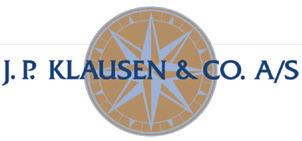

Your one stop supplier for:
New Zealand: Hoki, Hake, SBW, Dory, Ling, Mackerel, Squid, Orange Roughy, Warehou... and many more.
Chile:
Hoki, Hake, SBW, Ling, Warehou... and many more


Argentina: Red Shrimp, Hake, Hoki, Squid, Warehou, Savorin... and many more.
Faroe Islan ds: Mackerel, Herring, Northern Blue Whiting.
USA:
Alaskan Pollack, Cod, Surimi base, Hake, Roe, Yellow Fin Sole... and many more.
NEW: MSC Pink Salmon



in its course. It is undeniable that some salmon are simply better at processing the pigments and developing intensely red flesh. It appears that breeding conditions and stress can affect astaxanthin levels. It is also known that highfat feed generally promotes the red colouration of the fillet (fish with a lower fat content tend to have white flesh). With rapid growth, the colouration is usually weaker. Even within a fillet, noticeable colour differences can be seen. The explanation is often given as discrepancies between the role of astaxanthin in protecting against oxidative stress and its deposition in the muscle cells. Whether this is really true is as difficult to prove as it is to disprove. In aquaculture, salmon are indeed exposed to numerous stress factors such as sorting, handling, transport, high stocking densities, diseases, vaccinations, occasional food deprivation and intraspecific aggression, which lead to acute or chronic stress, which in turn increases the release of hormones such as adrenaline, noradrenaline and dopamine into the bloodstream and can potentially cause colour changes.
Changes in the feed could also affect pigmentation. Less fish meal and fish oil reduce the salmon’s appetite and promote fat accumulation in the intestine. However, phospholipids are particularly important for the transport of nutrients through the intestine and affect the utilization of pigments. The amount of phospholipids in the feed influenced the salmon’s astaxanthin and fat digestibility. In experiments, salmon feed enriched with phospholipids from soy beans led to redder-coloured fillets. Such studies suggest that intestinal absorption could be a bottleneck in the utilization of astaxanthin, which ultimately determines how

much pigment actually ends up in the salmon muscle meat.
Over the last decade, farmed salmon fillets have tended to become paler, despite more pigments being added to the feed. To clarify the causes and extent of this development, the Norwegian Seafood Research Fund has funded the Knowledge Mapping Pigmentation project. As part of the study, data will be collected through questionnaires, interviews and seminars with salmon farmers and feed manufacturers to provide information on changes in production methods and feed composition. Another focus will be on diseases and increasing stress, especially due to frequent delousing, which have a negative impact on astaxanthin levels. Land-based production in RAS with its usually high stocking densities, the
accumulation of waste products in the water and its constant disinfection will also be examined in the course of the study. These are all exciting scientific questions that also have great practical significance and create added value because fillet pigmentation influences salmon sales.
Pigmentation problems could even increase in the future, because it is fairly certain that climate change with rising temperatures contributes to the increased breakdown of pigments in the fillet in summer. This can lead to the formation of stripes or, in extreme cases, even to a complete loss of pigment in the fillet. In the future, pigmentation and astaxanthin utilization could also become selection criteria in breeding programs. Near-infrared spectroscopy (NIRS) is a fast and reliable screening tool for predicting the expected amounts of fat and pigment in the meat. In addition, some researchers are already

seriously considering specifically switching off those genes in the salmon’s genetic material that may have a negative effect on pigmentation. The biological mechanisms involved in the storage of astaxanthin in muscle cells have not yet been sufficiently explained, but the first ‘candidate genes’ have already been identified. With new, powerful gene editing methods (CRISPR/Cas9), it should not take too long to clarify the role of these genes in the absorption, conversion and storage of astaxanthin in various tissues and organs.
Of course, with all these studies and projects, it is important to keep consumers and their wishes in mind. Perhaps some customer groups will soon prefer fillets that are less coloured but still look natural. Consumer preferences may change faster than salmon change their colour. Manfred Klinkhardt
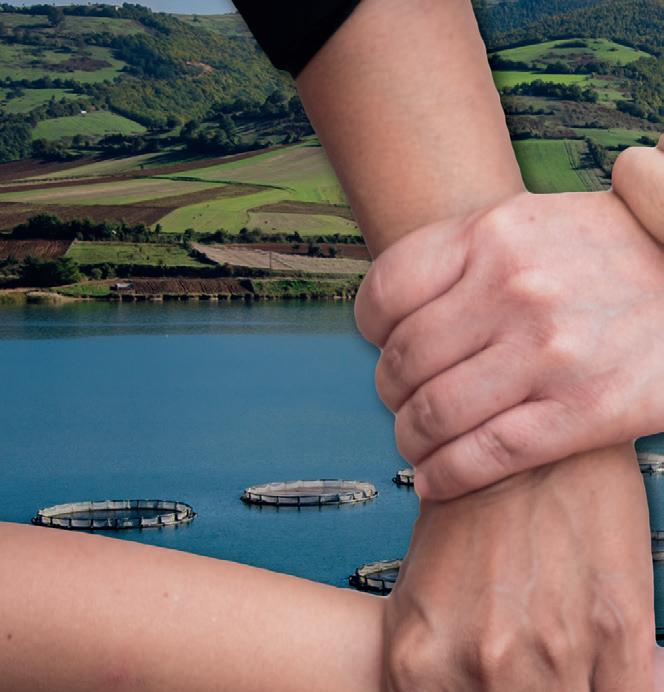



Visit us at AQUA24 in Copenhagen on August 26-30 at stand 33-35 to see how six EU projects seek to improve European aquaculture.
Italian startup deploys biotechnology to create better aquafeeds
Ittinsect, a three-year-old company based in Rome, isolates amino acids from insect meal to create an ingredient for fish feed that improves fish performance.
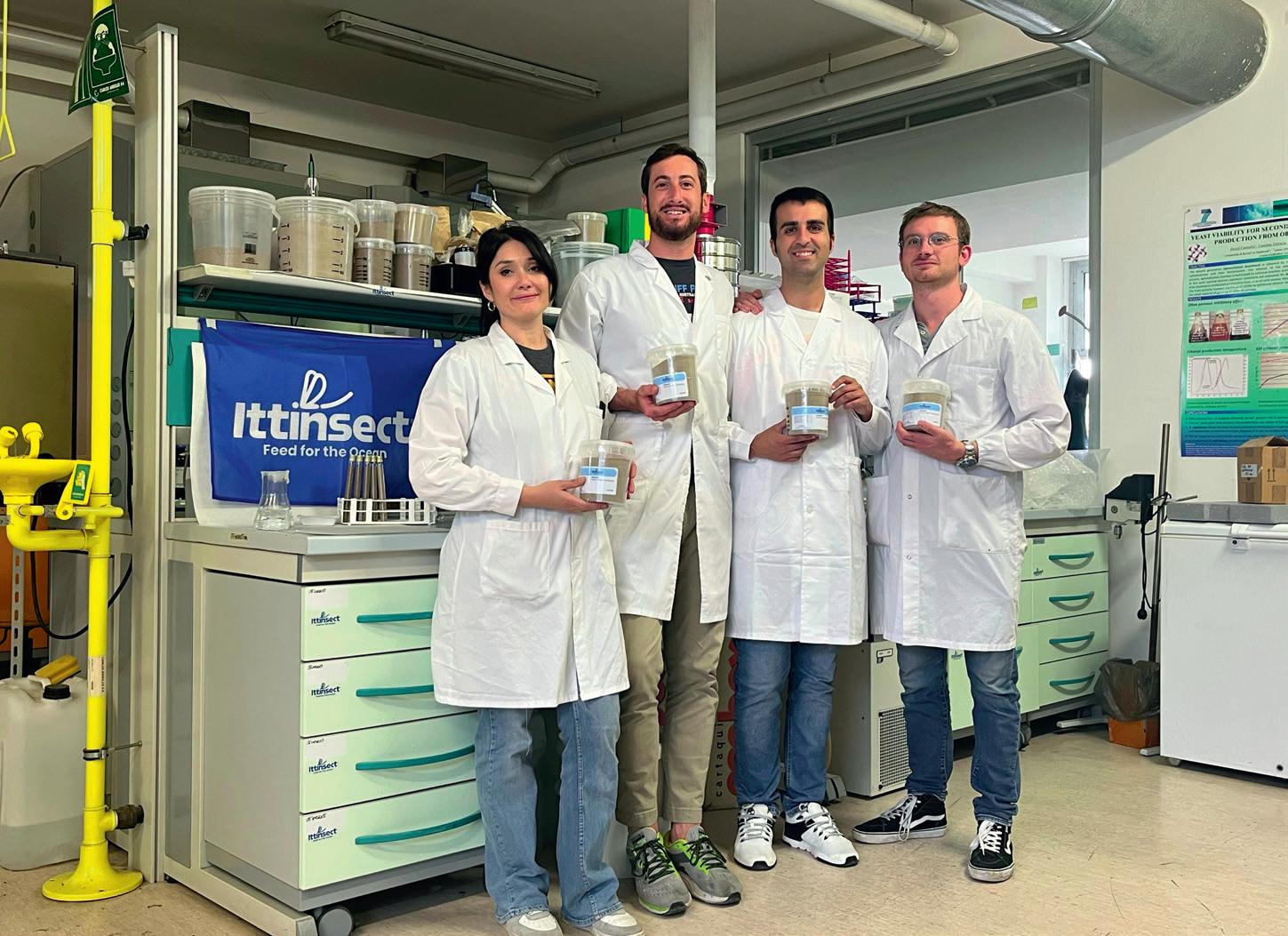
Farmed finfish can generally either be fed or nonfed and, of the total, the share of non-fed species has shown a declining trend since 2000, according to FAO. Many fed species are carnivorous and are traditionally fed with feeds
based on fishmeal and fish oil that mimic the diet they would obtain in the wild. Fishmeal and fish oil are produced from stocks of small pelagic species and the volumes produced fluctuate in line with catches of those species, however the overall trend
shows a decline in the volume of fish used to produce fishmeal and fish oil. This peaked at 30m tonnes in 1994 and fell to 16m tonnes in 2020, reports FAO. The aquaculture feed industry was the single largest user of fishmeal (86%) and fish oil (73%) in 2020.
Aquaculture farmers are under pressure to use feeds with alternate ingredients both to cut costs, to increase aquaculture’s sustainability, and to avoid accusations of preventing the human consumption of some of these small pelagic species.
Fishmeal and fish oil are increasingly being derived from fish by-products from the processing sector. In 2020 that share amounted to 27% for fishmeal and 48% for fish oil. Rather than being given to fish throughout their growth, feeds using fishmeal and fish oil are increasingly deployed at specific stages of the fish lifecycle such as hatchery, broodstock, or shortly prior to harvesting. Feeds for the growth phase have a smaller and smaller proportion of these two ingredients as they are substituted with plant- or insect-based products. Grower diets for Atlantic salmon or seabass and seabream are often less

than 10% fishmeal and fish oil. Capitalising on the opportunity this development offers, several companies in Europe and other parts of the world are growing insects to produce meal. Ittinsect, an Italian biotech company, uses proteins extracted from insects of different species and from vegetable by-products to produce a protein meal that can substitute fishmeal in fish feed. Alessandro Romano, the CEO, says the process starts with fermentation and the use of enzymes to identify the amino acid needed. This is then extracted and combined with other amino acids to deliver a highly nutritious product. Ittinsect uses the ingredient in its feeds. These are adapted to the needs of the specific farmers who can decide the proportion of the product that should be included
in the feed. Farmers can choose either to replace or supplement the fish meal content of the feed with the protein meal. The product, according to Mr Romano, has a positive impact on fish health, growth rate, and taste of the fish.
The company is currently in the process of expanding the line of feeds it produces for the famers and by the end of the year expects to sell its ingredient off the shelf to salmon feed producers to incorporate in their products. While production amounts to 800 tonnes this year, in 2025 Mr Romano expects to reach 5,000 tonnes. Expansion has been accelerated thanks to public and private investments and he is aware that large volumes bring down the unit costs and make


the company more interesting as a partner for players in the feed business. Production is based in Italy and Spain and is carried out mostly by contract manufacturing to enable large volumes without huge capital investments. Ittinsect has its own laboratories which are responsible for development and validation of the product and which include bioreactors and small extruders for trials. Initially the company sought to consolidate its market in Italy, developing a good customer base and collecting the feedback necessary to further develop and improve the product. Today, three years since it was founded, the target markets have expanded to France and Norway. In the former, the focus is on the feed, while in Norway it is on the ingredient.





Black soldier fly larvae (pictured) and mealworms are among the commonly used insects for meal, but the potential of other species is also being explored.
Interestingly, Mr Romano finds the product is chosen for different attributes in the different countries. For example, in Italy it is the promise of better performance that drives interest, while in France it is the product’s sustainability. The country has made an effort to promote insect protein as a natural protein in fish diets and consumer acceptance is therefore much higher than in Italy, where insect protein is still regarded with some suspicion. In Norway the company contemplates producing locally as that would reduce the environmental impact and would be regarded positively, but the main selling point, he claims, is the higher growth rate, better weight distribution— meaning an improved ratio of fillet weight to belly weight—and lower mortality. These outcomes are due to the processes the raw materials undergo that significantly increase the digestibility of the ingredient Ittinsect manufactures. In addition, the processes
reduce the proportion of antinutritional factors like chitin in the product which lessens the risk of gut inflammation in the fish. By contributing to the overall health of the fish the product enhances the animal’s resilience to factors like stress and disease.
The environmental advantages of the product stem mainly from the use of insect-based raw materials rather than fishmeal and fish oil. By this measure our feeds do significantly better than conventional feeds while also improving fish performance, says Mr Romano, though our carbon footprint is only marginally better. The fish in : fish out (FIFO), a metric showing the volume of wild fish that goes into the production of one kilo of farmed fish, has steadily improved over the years. According to the Marine Ingredients Organisation, a trade body, the FIFO for all finfish species groups except for eels is less than 1. That is, less than a kilo of forage fish is used to produce a kilo of farmed fish. For salmonids the ratio was 0.93 in 2020 (down from 3.03 in 2000) while for eels
it was 1.34. For all fed aquaculture species taken together, the ratio was 0.19 in 2020 (0.47 in 2000). How much of this improvement can be attributed to the substitution of fishmeal and fish oil with insect products is not clear. A study1 in Reviews in Aquaculture that looked at the environmental impact of insect meals in fish feed found that the carbon footprint of insect production was actually greater than that of fishmeal and fish oil, while land use efficiency was about the same. The researchers found that insect production was a relatively recent enterprise and, unlike in the mature marine ingredients industry, the potential
for improvement was vast. They concluded that switching to the industrial-scale farming of insects using energy efficient facilities could reduce the carbon footprint of the activity. Moreover, developing suitable substrates, with low environmental impacts and which improve the nutritional characteristics of the insects, is necessary for insect proteins to become an environmentally viable alternative to marine ingredients.
Ittinsect does not farm the insects themselves. These are now bred all over Europe and are on their way to becoming a commodity, so the company sources the insects from suppliers in five or six European countries. They must have been raised on agricultural waste and have all the necessary health certifications to meet the statutory requirements for their use in feed. This year will see the first French and Norwegian customers and the launch of the first ingredient as an off-the-shelf product. Having successfully formulated and sold feeds based on the ingredient Ittinsect has developed, Mr Romano hopes now to emulate that achievement where the ingredient itself is the product.
Via Giacomo Peroni 386, 00131 Rome Italy
info@ittinsect.com ittinsect.com
CEO: Alessandro Romano
Activity: Bioprocessed ingredients based on insect meal and
agricultural by-products for aquafeeds
Species catered to: Trout, sturgeon, seabass, seabream, salmon
Volumes: 800 tonnes in 2024, 5,000 tonnes in 2025
1 Quang Tran H, Van Doan H, Stejskal V. Environmental consequences of using insect meal as an ingredient in aquafeeds: A systematic view. Rev Aquac. 2021; 14: 237–251. https://doi. org/10.1111/raq.12595
The Horizon Europe project, Verifish, will supply consumers with the tools to make objective decisions about the seafood they buy. The objective is to encourage them to consume sustainably.
In the information age, making informed decisions should be straightforward. Consumers need information about sustainability and nutrient values, as well as provenance, and potential risks and benefits of the products they consume. However, when it comes to seafood consumption, the complexities of health benefits, sustainability, and climate impacts create a daunting landscape for consumers. VeriFish, a Horizon Europe funded project, steps in to address this challenge, aiming to streamline the decision-making process by offering a robust framework of verifiable indicators in Europe. By providing clear, standardised information, VeriFish enables consumers, retailers, producers,



fishers, policymakers, and citizens to make choices that promote sustainable living. VeriFish will also focus on children as they are the consumers of the future, and their choices matter. This article delves into the intricacies of the VeriFish project, exploring its objectives, innovations, and potential impact on the seafood industry and beyond.
Seafood is a vital component of a balanced diet, offering numerous health benefits, including highquality protein, omega-3 fatty acids, and essential vitamins and minerals. Despite its advantages,
seafood is often ignored or incorrectly categorised as meat, leading to a lack of recognition of its lower climate impact compared to other protein sources. This misclassification contributes to lower seafood consumption in Europe compared to meat products. Additionally, locally produced seafood often struggles to compete with imported products because consumers are either unaware of or do not sufficiently value the benefits of local seafood.
The solution to this problem is not to simply convince consumers to purchase more seafood. Indeed, both fishing and aquaculture industries generate issues that complicate consumer
choices. Overfishing, bycatch, habitat destruction, and climate change are just a few of the problems that the fishing sector faces. Overfishing, driven by high demand and inefficient fishing practices, depletes fish stocks and disrupts marine ecosystems. Bycatch further exacerbates biodiversity loss and threatens the stability of marine ecosystems. Habitat destruction, resulting from activities such as bottom trawling and coastal development, undermines the resilience of marine habitats and compromises their ability to support biodiversity. While aquaculture has the potential to relieve pressure on wild fish stocks, it is also not without its drawbacks. Issues such as habitat degradation,


With 60 years of dedication in the aquaculture industry, Aller Aqua continues to deliver feed solutions rooted in long-standing expertise and excellence.

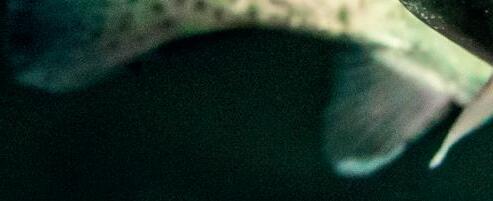




























































water pollution, disease outbreaks, and the use of antibiotics and other chemicals pose significant environmental and health risks.
Consumers deserve to know the impact of their seafood purchases, but the issues within this industry—notably, the lack of standardised information about its sustainability and environmental impact—continues to hinder consumers from making truly informed decisions. Without clear, harmonised indicators, consumers are left in the dark about the impact of their seafood purchases. Labels and certifications often vary widely in terms of criteria and transparency, leading to confusion and mistrust. This information gap not only affects individual purchasing decisions but also undermines broader efforts to promote sustainable consumption patterns. The absence of standardised metrics complicates the creation and enforcement of regulations by policymakers, and without clear guidelines and incentives, the industry will struggle to transition towards more sustainable production methods. Addressing these challenges requires a coordinated effort from all stakeholders, including governments, industry players, NGOs, and consumers.
The VeriFish project was conceived to tackle these challenges head-on over a two-year period starting in May 2024. Funded by the European Union (EU) and following the objectives of the HORIZON-MISS-2023-OCEAN-01-10
“Choose your fish: a campaign for responsible consumption of products from the sea” call, the project aims to develop a comprehensive framework of verifiable indicators that provide clear, reliable information on the health benefits, climate impacts, and sustainability of various seafood products. These indicators will be based on existing EU global FAIR (Findable, Accessible, Interoperable, and Reusable) data repositories and indicator lists. These will include indicators for environmental sustainability, social sustainability, provenance, processes (including organic production and seasonality), human health, and nutrition. The project will not define new indicators, as it will select existing ones from reliable sources and integrate them in a new and innovative framework. The project is designed to serve consumers, retailers, seafood producers, the HoReCa (hotels, restaurants, and catering) sector, and policymakers alike,
simplifying the complex landscape of seafood consumption. Based on the integrated framework of indicators, the project will develop a prototype of a web-based app, design, develop, and disseminate several types of media products, and develop and publish European Good Practice recommendations. The web-based app and the media products will be promoted through social media channels attractive to targeted groups.
of the project
At the heart of VeriFish is the development of a robust indicator framework. This framework includes a set of verifiable indicators that can be used to make transparent claims about seafood products. These indicators cover a range of aspects, including environmental sustainability, social responsibility, and nutritional value. By standardising these metrics, VeriFish ensures that consumers receive consistent and reliable information, regardless of the source. The framework will be open access and tested via enduser engagement campaigns.
The structure of the VeriFish indicator framework will be closely aligned with the Global Record of Stocks and Fisheries (GRSF) that is based on Ecosystem Approach





to Fisheries (EAF) principles. This database is not only supported by the ongoing Horizon-Blue-Cloud 2026 project, but also is unique because it not only provides a list of sustainability indicators for fisheries, but it also the current state of each indicator. In the case of aquaculture, even though there is no central database like GRSF, there are many other different types compatible with what the project aims to achieve, such as AquaGRIS (FAO) and ISO 12877. In addition to these data sources of environmental sustainability, the indicator framework will contain and link together data sources and indicator lists for social sustainability, provenance, health, and nutrition from different databases, including FishBase, SeaLifeBase, ISO12875, SEAFOODTOMORROW, and FoodEXplorer.
The VeriFish framework will integrate information from different databases and rank them according to the level of reliability. Alongside this ranking, VeriFish will also provide a definition, rationale, method of computation, links to sources, periodicity, (dis)aggregation options, limitations, and comments about the compiled information. The framework will showcase the




























most important data about a product using standardised definitions. For many products, indicators can be collected once and used many times.
To avoid skimming 100+ pages of indicators, users and stakeholders will be able to view them in a spider/radar chart that supports connections between ideas, exploration of possible solutions, and visualisation of concepts that would otherwise be difficult to understand. This will allow users to assign a specific scope to an indicator and integrate local, seasonal, or health concerns regarding fisheries and aquaculture sustainability with wider sectoral environmental impact mitigation plans, sustainability of the fisheries, and EU-wide nutritional data.
To fully utilise the indicator framework, VeriFish provides comprehensive guidelines on how to use and visualise these indicators. These guidelines are designed to help retailers and producers effectively communicate the sustainability credentials of their products. Clear visualisation techniques, such as infographics and easy-tounderstand labels, are promoted to ensure that the information is accessible and engaging for all consumers.





The VeriFish project has been designed with high impact in mind, both the expected direct impact outlined in the topic and the wider societal impact following EU policies and UN Sustainable Development Goals. The project pathway towards impact will be through outreach campaigns, factsheets, magazine articles, recipes, games, videos, and SoMe content for different types of seafood, targeting different consumer groups, cultures, and languages.
One of the most exciting aspects of the VeriFish project is the development of a prototype mobilefriendly application. This app is designed to provide consumers with easy access to the indicator framework. Users can search for specific seafood products to see detailed factsheets, including the verifiable indicators, health benefits, and sustainability credentials. The app also offers recommendations on how to make informed and responsible seafood choices based on individual preferences and dietary needs.
The user interface will be convenient and will reproduce the VeriFish indicator framework in an easy-to-navigate format. The app
will provide information describing the status of stocks, activities, food composition information, biological characteristics of species and environmental information, guiding users towards informed choices. Because VeriFish will be available in this portable, accessible form, sustainability can be more easily considered by consumers when they make choices about their seafood.
In addition to the app, VeriFish is creating a series of media products promoting informed consumption. These products include videos, social media content, and educational materials that highlight the importance of sustainable seafood practices. By leveraging multiple media channels, VeriFish aims to reach a broad audience and foster a community of informed and engaged consumers.
One of the key deliverables of the VeriFish project is the development of a European Good Practice (EGP) recommendation. This recommendation will be published as a CEN (French abbreviation for European Committee for Standardization) Workshop Agreement (CWA), providing a standardised approach for communicating about sustainable




















seafood. The CWA will offer practical guidelines on how to effectively organise and run campaigns that promote sustainable seafood consumption. By providing a harmonised framework, the CWA aims to improve the clarity and consistency of sustainability messages across Europe.
The CWA will play a critical role in enhancing the communication of sustainability credentials to different end-user groups. For consumers, it will provide clear and trustworthy information that helps them make informed choices. For retailers and producers, it will offer a standardised method for showcasing the sustainability of their products, helping to build consumer trust and loyalty. For policymakers, the CWA will serve as a valuable tool for designing and implementing effective regulations and initiatives.
Feedback from stakeholders will shape Community of Practice (CoP)
Central to the success of VeriFish is the establishment of a Community of Practice (CoP). This CoP will be established for stakeholders committed to





















promoting sustainable seafood, which will have a significant impact both during and after the project. The CoP will engage and attract experts, stakeholders, and multipliers to provide information about the VeriFish indicator framework, the media products, and the web app and to engage them in the final project conference in February-March 2025. By fostering collaboration and knowledgesharing, the CoP ensures that the best practices and insights are integrated into the VeriFish framework. The community will offer invaluable opportunities for knowledge sharing, collaboration, and skill development among members by fostering a sense of belonging and shared purpose, as well as enhancing learning and problem-solving within specific domains and professions. The VeriFish CoP will engage actors in the relevant fish supply chains, other experts, and multipliers by providing independent, validated information about fish in the European market. At the same time, the CoP will also contribute to the VeriFish indicator framework and other tools.
Engaging a diverse range of stakeholders is crucial for the VeriFish project. By involving different perspectives and expertise, VeriFish ensures that its solutions are comprehensive and effective. Regular workshops, webinars, and consultations will be held to gather feedback and refine the project’s outputs. This collaborative approach not only enhances the quality of the indicator framework but also builds a sense of ownership and commitment among stakeholders.
The project will offer expert advice and promote good practices on how to collect, collate, aggregate, and present data on indicators. However, for VeriFish to be an effective project, it will follow a validation process with stakeholders and actors along seafood supply chains. This will allow for gathering feedback, ensuring alignment with objectives, and validating fitness for purpose. The goal of this validation phase, which will be conducted more than once to ensure ongoing alignment with stakeholders needs and expectations, is to demonstrate that VeriFish will provide an overview of a seafood product that is accessible in terms of the GRSF (Global Record of Stocks and Fisheries data protocol).
An essential component of VeriFish’s stakeholder engagement is the inclusion of children. Educating children through social media, influencers, and by engaging in “understanding games” about sustainable seafood is crucial. By cultivating today’s youth, VeriFish aims to shape the minds of the future and ensure sustainable production and consumption behaviours. Children, as the next generation of consumers, play a vital role in the long-term success of sustainability initiatives. Educating them about the importance of sustainable seafood practices helps to instil values and habits that will contribute to a more sustainable future.
The mobile app and all media products of VeriFish will be designed with many types of consumers in mind, including children. These tools will provide interactive and fun ways for
The VeriFish consortium comprises ten European partners (eight beneficiaries and two affiliated entities) from nine countries bringing complementary skills and expertise. The project is led by the Italian company Trust-IT that will also contribute to outreach and awareness campaigns. The development of the indicator framework will be led by EUROFIR (Belgium) in collaboration with FORTH (Foundation for Research and Technology Hellas) (Greece), PREMOTEC (Switzerland), and with the support of FishBase and SeaLifeBase (affiliated entities). Eurofish International Organisation (Denmark) will oversee the development of guidelines and will lead communication, outreach, and dissemination campaigns. COMMpla (Italy) and PREMOTEC-PL (Poland) will oversee the development of the web app. NOFIMA (Norway) will be the main partner on the development of the CWA, and CLUPEA (Netherlands) will manage the policy liaison and sustainability of the project. A new partner will come soon in the future to help with outreach and awareness campaigns.
children to learn about the benefits of sustainable seafood, making complex information more accessible and understandable. By involving children, VeriFish not only broadens its reach but also ensures that the message of sustainability is passed on to future generations, fostering a culture of informed and responsible consumption.
Project outputs could enable consumers to boost demand for sustainable seafood
While the initial focus of VeriFish is on developing the indicator framework and related tools, the project has a long-term vision that extends beyond these immediate goals. Future developments may include expanding the indicator framework to cover a wider range of seafood products and other food categories. Additionally, VeriFish aims to continue building and strengthening the CoP that will live on after the project, ensuring that the project remains responsive to emerging challenges and opportunities.
The success of VeriFish depends on both the efforts of the project team and stakeholders, and on the active participation of consumers. By embracing the tools and information provided by VeriFish, consumers can play a crucial role in driving demand for sustainable seafood. The project encourages readers to download the app, engage with the media products, and become part of the movement towards a more sustainable future.
For that, the indicator framework will be promoted across consumer, fisheries, and aquaculture associations to boost usage by their networks. The VeriFish app helps to solve the transition issues inside the fisheries and aquaculture sectors by allowing easy access to biological and environmental data. The guidelines on how to communicate sustainability will be used by different stakeholders as future ways to verify seafood indicators, and the Good Practice standard recommendations can become a reference for scientists and policymakers.
Ixai Salvo, ixai@eurofish.dk


Denmark must develop even further as a producer of high-quality food
Jacob Jensen, the Danish minister of Food, Agriculture and Fisheries, represents Venstre (the Liberal Party of Denmark), a party with roots in defending the interests of the primary production sector, in the governing coalition.
Since 1995 the number of vessels in the Danish shing eet has fallen in both the categories commercial and non-commercial by 76 and 44 respectively, states a report1 from the Fisheries Commission. e di erence between the two groups relates to the value of landings: with a minimum landing value of DKK270,000 (EUR36,200) per year since 2012 a vessel falls into the commercial category, while a vessel with a landing value below that threshold falls into the non-commercial category. e two categories are further subdivided into vessels below 17 m, demersal vessels above 17 m, pelagic vessels above 17 m, and special sheries that encompass vessels that target brown shrimp, mussels, and northern prawn in the waters around Greenland. e eet thus exhibits a high degree of diversity compounded further by the variety of gears used, the quota distribution system governing the vessel, and whether shing is close to the coast.
Attracting a new generation of fishers is crucial for the sector’s future
For Mr Jensen the priority is clear— to have a shery that is competitive in relation to eets in EU and nonEU countries, yet one that is also environmentally sustainable. e
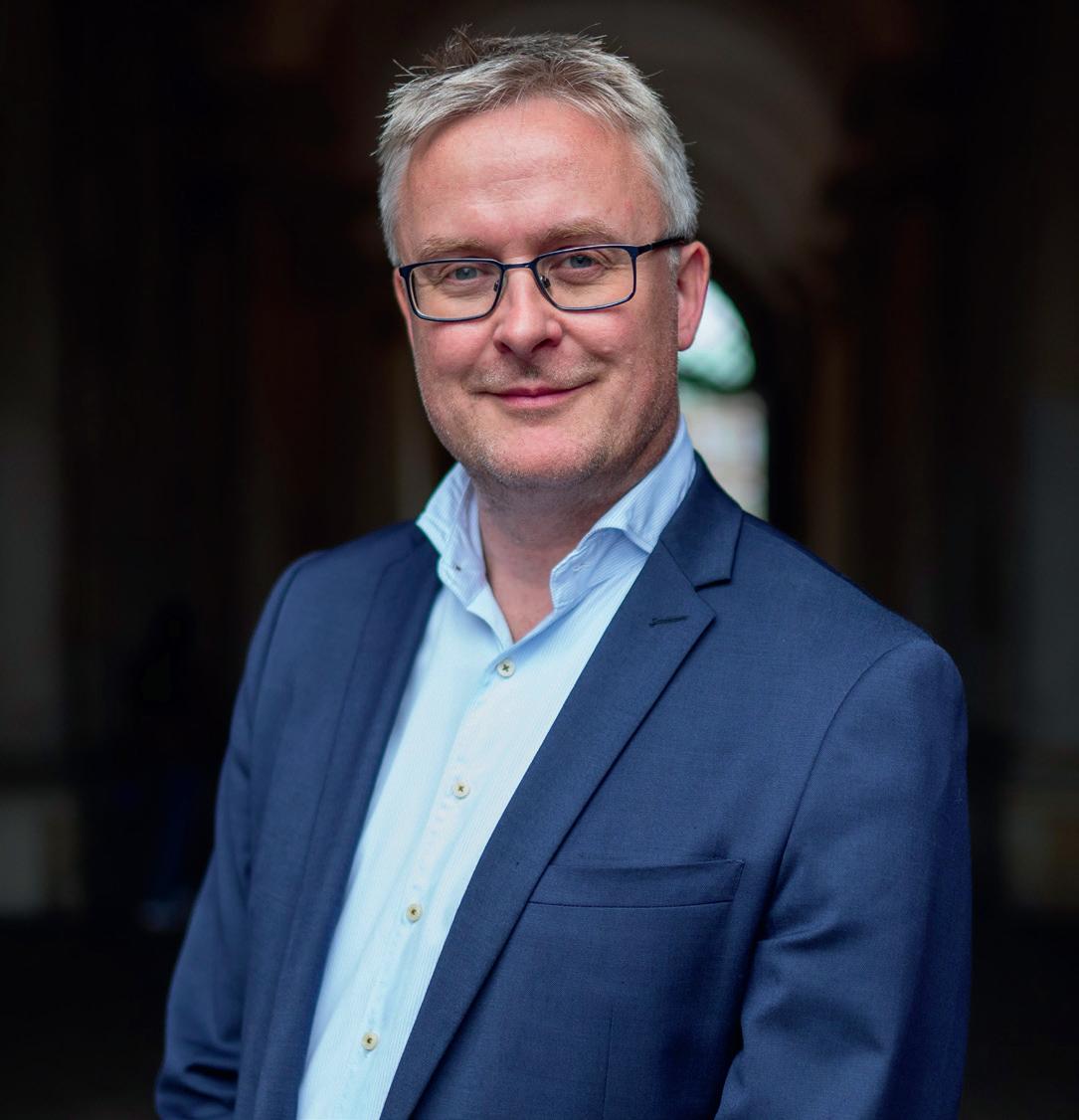
diversity of the eet, with its large, medium, and small vessels, benets coastal communities and shing harbours around the country.
1 Fiskerikommissionen, december 2023, ISBN: 978-87-88363-30-2
Danish sheries policy seeks to maintain this diversity and prevent the consolidation of the eet into fewer hands, he says, as we are interested in the development of the industry. Since 2008 the number of vessels in the categories over 17 demersal, over 17 m pelagic, and
the special sheries, have been more or less stable, while vessels in the under 17 m group have continued to decline. Mr Jensen has no illusions—some vessels must exit the sector, while others need modernising. One target is to get more young people into the industry, a challenge facing many EU countries as youngsters are discouraged by the expense of starting out as a sher, the bureaucracy at every level, and the demanding nature of the work. e Minister believes rmly that a younger generation will bring new ways of doing things and fresh insights to the industry especially if supported with new capital and will contribute to the revitalisation of the sector.
Bottom trawling forbidden on five Danish reefs
Danish coastal vessels have been ghting the deployment of beam trawls by vessels from other nations as they have a signi cant negative impact on the seabed, marine habitats, and sh stocks. Danish shers no longer use this gear. For Mr Jensen the Common Fisheries Policy means common rules across the EU; shers from other countries must abide by the rules that bind Danish shers when shing in Danish waters. He has therefore proposed a ban on shing with bottom trawls on ve Danish reefs in the North Sea and Skagerrak, a measure aimed squarely at foreign shing vessels. Forbidding the use of beam trawls will have positive impacts on the marine environment and contribute to a more sustainable shery. is is critical when sh stocks are already under pressure from the impacts of climate change as it will increase the resilience of stocks. Mr Jensen agrees that the biological advice underlying decisions on quotas should be followed as far as possible but


feels that it is justi ed when the numbers are adjusted for political reasons. At the same time, he sees one of the ways to move the sheries in a more sustainable direction is by supporting the design and deployment of new and more selective shing gear.
Electri cation of the eet is another possibility, but currently not all eet segments lend themselves equally to being electri ed, but for those that can switch from diesel that is the way forward, as diesel is both expensive and polluting. To encourage the shift to cleaner fuels the government has introduced a duty on diesel that will enter into force in 2025 and is aimed at helping the country reach its climate commitments. But the government also supports the development of ways to reach these targets. e duty is set to rise gradually to DKK750 (EUR100) per tonne of emitted carbon dioxide by 2030, although the Fisheries Commission recommends that it continues to rise after 2030 till it reaches a level that encourages the switch to green fuels with a view to achieving a climate-neutral shing sector by 2050. Mr Jensen will not demand that the shing industry mitigates its impact on the climate if the ways to achieve this simply do not exist. If suitable electric motors have not been developed, we cannot insist that shing vessels start using batteries. Similarly, if battery-charging infrastructure has not been rolled out at harbours, we cannot expect vessels to electrify. e solutions for shing vessels must be commercially, technically, and nancially viable before they can be deployed and Mr Jensen is willing to o er the political and nancial means to enable this. He uses the example
of the coastal shery which must accept certain conditions but which in return is supported by the ministry in the shery’s e orts to promote its image as a supporter of small coastal communities and locally caught products. For the Minister sheries have historical and cultural traditions which are worth preserving even if there are only a few areas where the shery has any real economic value. He feels sheries contribute to binding the di erent parts of the country together in a way that cannot be measured in kroner and ører, and which he also takes into consideration when discussing how sheries should develop. He sees the role of the control instances as both to monitor and inspect but also to assist the industry understand and comply with the rules.
Aquaculture production in Denmark is based primarily on rainbow trout and mussels with minor volumes of other n sh species. e industry is subject to strict regulations regarding the release of nutrients into the environment which has contributed to the development of sophisticated technical solutions for farming sh in recirculation systems with low water consumption and minimal release of nutrients. Today these systems are exported the world over. Support for the further development of these technologies through research is a priority of the ministry where both economic and sustainability considerations are taken into account. He draws a connection between the war in Ukraine and the need to focus on food security not just in Denmark but in the wider region and sees aquaculture playing
an important role in this regard. Denmark has not experienced famine in decades, but the war and other geopolitical developments have brought closer the threat of disrupted supply chains and of food shortages necessitating the emphasis on resilience. at said, however, the importance of food security cannot be seen in the aquaculture production statistics which have been stagnating for years in Denmark (and the EU). One of the reasons cited by the industry for this is the red tape that is tying the sector in knots. In response Mr Jensen points to an initiative taken by his ministry inviting suggestions to remove or simplify rules without compromising on environmental, animal welfare, or climate requirements. Support from the ministry has been used in Viet Nam to replace the use of antibiotics with vaccines for farmed sh, an example of cooperation that Mr Jensen is justi ably proud of as it shows Danish expertise both technical and administrative being used to sustainably improve food safety and quality.
In summary, Denmark’s continued role as a producer of food from sheries and aquaculture is a priority for the Minister given the projected growth in global population as well as the threat from geopolitical events. Fishing, in addition, binds the di erent parts of the country closer together, something that cannot be measured in purely monetary terms, but that is a valuable attribute and one that is recognised across the political spectrum. Denmark has long been a producer of highquality food and with the ministry’s support this ability will be nurtured and adapted to today’s demands for production that has little or no impact on the climate or the environment.


Blue Rock combines angling ponds with noble crayfish production
Crayfishes are a ten-legged crustacean found in freshwater bodies throughout the world. There are some 650 species altogether of which five are native to Europe. A further ten species are also found in Europe, but they are invasive. Among them is the signal crayfish (Pacifastacus leniusculus) that today can be found all over Denmark.
The signal crayfish is a challenge in Denmark (and in Sweden, Norway, and Finland) because it outcompetes the native noble crayfish ( Astacus astacus ) thanks to a shorter time to maturity (two years vs three to six years) and higher fecundity (~400 eggs vs ~100). In streams that hold both species, the noble crayfish will therefore die out with time. Some varieties of signal crayfish also carry a disease, the crayfish plague ( Aphanomyces astaci ), a highly infectious fungus that is lethal for noble crayfish. The signal crayfish also have other undesirable impacts as they feed on the eggs and larvae of trout and other fish and can change the features of a pond or lake due to their tunnelling activity. To slow the spread of signal crayfish the Danish Environmental Protection Agency recommends slaughtering signal crayfish when they are caught and not keeping them alive in outdoor ponds or basins as they can escape over land. The sole variety that may be released in the wild is the noble crayfish and only after obtaining permission from the authorities. The agency also recommends disinfecting clothes and equipment (traps, nets, etc.) before using them in another pond to prevent the spread of the fungus.
Noble cray sh are farmed in Denmark in ponds and lakes. e broodstock are either caught in the wild or are taken from cultured stocks and are paired typically in a ratio of one male to two females. ere are some 60 producers of cray sh scattered across the country and they are represented by the Danish Craysh Breeders’ Association. e association was established in 1988 to develop and promote the breeding of noble craysh. Moreover, it is committed to the protection and spread of this species. In addition to being good eating, noble craysh help to maintain the water body in which they are located. As juveniles the cray sh feed on insects and zooplankton in the water, but as they mature their diet changes to one consisting mainly of plant matter. By removing the remnants of plants, dead algae, and other organic material they contribute to the health of the lake environment. Cray sh prefer clear water with a high oxygen content and pond owners need to periodically clear their ponds of reeds and other organic debris. e depth of the ponds should vary up to a maximum of four to ve metres and the bed should be rm and
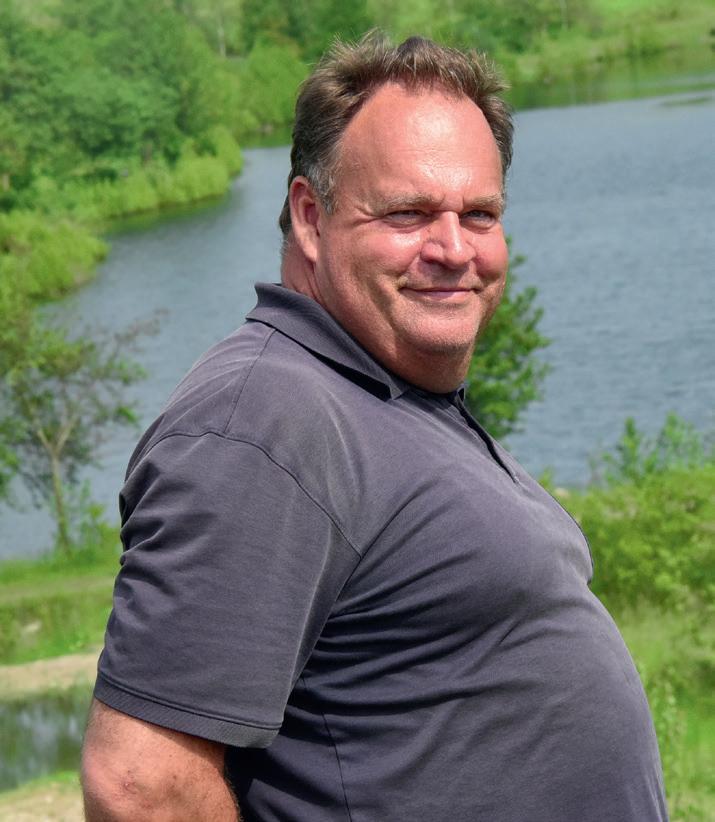
populated with stones or tree roots that a ord hiding places for the creatures. According to the association’s website (www. odkrebs.dk), cray sh can only tolerate freshwater with a pH of between 7 and 8 and an oxygen content of at least 5mg/l. Even a low level of salt in the water or a pH below 6 can prevent the cray sh from moulting or breeding. In summer the average temperature over three months
should be higher than 15 degrees for normal growth while higher growth rates can be achieved at temperatures between 17 and 22 degrees, though not higher.
Mixing and circulating the water has positive effects on fish and crayfish
Søren Wiggers is the president of the association and a noble


cray sh breeder himself. At his company, Blue Rock, 20 minutes drive from Svendborg on Funen, a Danish island, Mr Wiggers combines farming cray sh in ponds that he stocks with sh for anglers. e sh species include several species of trout, and no less than 20 varieties of pure-bred and hybrid sturgeons. In addition, there are several carp species, perch, burbot, cat sh, tench, and pike-perch, among others. e two lakes on the 38-hectare site were originally formed as a result of the activities of the previous owner who was excavating stone for the construction industry. e site changed hands in 2007 when Mr Wiggers took over, and the rst angling lake opened in May 2008. Following an unusually warm summer in 2018 when the temperature stayed at 30 degrees for six weeks and the water temperature in the ponds reached 28 degrees killing all the cray sh, Mr Wiggers introduced a system that would circulate and mix the water in the shallower ponds. He was inspired by the fact that the temperature in an arti cial stream did not reach the same level as in the ponds thanks to the movement and mixing of the water which allowed the
cray sh present there to survive. With a pipe diameter of 1.4 m and a water velocity of 1.5 m/s, the pump is a powerful machine that runs 12 hours a day in the summer period when there is a risk of the temperature increasing to intolerable levels. e ponds double as angling ponds and carry di erent species of trout (brook, golden, rainbow) so the action of the pump bene ts them too. Moreover, mixing the water not only reduces the temperature of the upper layers, but also increases it at the bottom which encourages the sh (and the cray sh) to feed and grow. e sh and the cray sh coexist as the sh are introduced from sh farms and are used to feeding on pellets rather than foraging for themselves. e cost of running the pump can therefore be split between the cray sh and the sh. Pumps are also used to move water from the big lake to the smaller ones when there is not enough rainfall. e last ve years the rainfall has been inadequate, but in winter 2023/24 there was so much precipitation that Mr Wiggers foresees there will be enough water for at least the next ve years even if the rains should fail.

does not require major investments in money or time.

circulates and
Vegetation, clay bottom, clear water, and high oxygen levels are good for crayfish
In autumn this year Mr Wiggers plans to release 1,500 to 2,000 cray sh individuals into these ponds. Of these, two thirds will be females and one third males. e creatures will be taken from his own stock from which he will select the biggest individuals or those with the biggest claws. Cray sh farmers will typically harvest the biggest specimens for sale or personal consumption leaving the smaller one to continue growing. e problem is that small-sized cray sh may be genetically programmed never to grow large. If they are used as broodstock the entire stock may over time comprise only small individuals. Mr Wiggers therefore recommends returning at least 10 of the biggest specimens back into the water to breed. is way the farmer can harvest cray sh that weigh at least 100 g, rather than 50-70 g. e yield from small cray sh is virtually nothing, while for both big and small individuals the work that goes into extracting the meat is the same. Cray sh meat comes both
from the tails and the claws and in a large specimen the claws can yield as much meat as the tail. Cray sh like ponds with vegetation as it provides both feed and shelter. Søren Wiggers has sowed wheat in the ponds on which the cray sh can graze and which also protects them from predatory sh. A clay bottom too is preferred by the animals as that ensures a favourable pH and enables them to dig holes where they can shelter and breed. Mr Wiggers predicts that the pond where he plans to introduce the cray sh will allow him to harvest an additional 250 to 300 kg a year in a couple of years. A cray sh’s diet changes from juvenile, when it preys on small insects, larvae, and other foods suited to a carnivore, to adult, when it prefers a more vegetarian diet. But craysh also feed on snails and even dead sh if freshly dead—once it starts to decay they tend to move away as the decomposition process absorbs oxygen from the surrounding water.
e ponds at the site amount to some 18 ha of water surface in total. Farming cray sh is a useful additional source of income in August and September, the only months



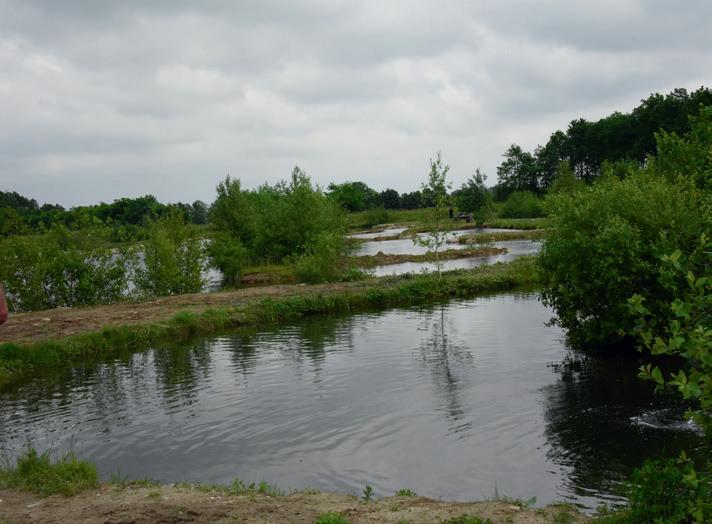
A Charophyceae algae that grows naturally in the ponds releases oxygen into the water benefiting the life present there.
when cray sh may be harvested. From his Specimen Lake which is stocked with carp, cat sh, and sturgeons, Mr Wiggers harvests 2,000 to 3,000 young (two-yearold) cray sh each year, while the Put and Take Lake, which contains mostly trout, yields some 100 kg of large cray sh. In addition, there is a small children’s lake and two more ponds which all contain cray sh. e ponds are naturally populated with a variety of Charophyceae algae which releases signi cant quantities of oxygen into the water as well as o ering the cray sh feed and shelter. To maintain the pH at the desired level of between 7 and 8 calcium carbonate is introduced into the ponds occasionally to counteract the acidi cation that arises from leaves and other debris falling into the water. is is, however, not a necessity.
Crayfish production is still largely a small-scale activity
e Danish market for cray sh is larger than the production and the association tries to encourage members and others to grow the animal. Mr Wiggers says he could easily sell ten times the volume he does currently. Cray sh is even
more popular in Sweden where summer cray sh parties are common. Most Danish cray sh farmers, perhaps 90, only produce for their own consumption and treat the production more as a hobby than anything else. Every now and then they may have a setback that wipes out their stock, but then they buy some more juveniles and start over. At Blue Rock, most customers for the cray sh for consumption are individuals throwing a private party. e cray sh are sold live, so they are completely fresh when prepared. ere is also a market for smaller cray sh that buyers use to stock their lakes. is can vary from 10 cray sh for a small private pond to 3,000 pieces for a large lake. So far, at Blue Rock the annual harvest of cray sh for consumption has amounted to about 120 kg of which 20 kg is for self-consumption. ese must be a minimum of 9 cm in length or 10 to 12 pieces a kilo and are around three years old. If these were allowed to grow for a further two years, they would be more than twice as big. Cray sh are caught in traps which Mr Wiggers baits with pieces of white sh. Other farmers swear by pig liver or dog biscuits, but he nds that nothing beats fresh white sh. e traps are placed
The sand banks in the pond aid in the circulation of the water and provide shelter and feed for fish and crayfish.
in the water in the evening and the next morning the cray sh are removed.
Cray sh harvests in Denmark have been stable at about 500 kg a year. According to Mr Wiggers, there is scope to increase this as there are ponds and lakes on private properties where the owners could stock noble cray sh. e beauty is that they require no maintenance; they can be
Ravnegårdsvej 12 5762 Vester Skerninge
Denmark Tel.: +45 2991 8191
kontakt@bluerock.dk www.bluerock.dk
Owner: Søren Wiggers
Activities: Ponds for anglers; noble crayfish production
Total pond area: 18 ha
Number of water bodies: 12 ha specimen lake (catch and release), 4 ha trout lake (put & take), two fly streams of total 2,350 m (put & take), children’s lake, and two smaller crayfish ponds
stocked, ignored for three years, and then harvested, and they currently command a price of EUR50 per kilo. Moreover, it would help the spread of this native species which is highly desirable in the face of the threat from the signal cray sh. By expanding production at Blue Rock, Mr Wiggers is doing his bit for the Danish stock of noble cray sh and hopes that it will inspire others to follow suit.
Fish for angling: Trout (rainbow, brook, golden), 20 varieties of pure-bred and hybrid sturgeons, carp (common, grass), perch, burbot, catfish, tench, and pike-perch, among others
Annual crayfish production (restocking): 2,000-3,000 individuals
Annual crayfish production (consumption): 100-150 kg (500-800 kg in 2026)
Size: Minimum 9 cm by law, but consumers prefer larger crayfish of 12-15 cm approximately 10-12 pieces/kg)
Product form: Live Season: August, September


The Danish coastal fishery faces challenges but also opportunities
David Lange is director of the Association of Low-Impact Coastal Fishers Producer Organisation (Foreningen for Skånsomt Kystfiskeri Producentorganisation (FSK-PO)), a body that celebrates its 10th anniversary later this year. Established in 2014 the association represents fishers who use low impact gears such as gill nets, Danish seines, fyke nets, traps, and hooks.
Ahealthy ocean and vigorous sh stocks are the only way to secure the coastal shery for future generations of shers. FSK-PO is only too aware of this and campaigns for increasing biodiversity in the marine environment and against predatory behaviour at sea. e coastal shery should be an important part of the commercial shing sector and through its work in parliamentary committees that advise the government on sheries issues, FSK-PO ghts the shuttering of small harbours along the Danish coast which disproportionately a ects the coastal shery. Instead, this segment should be driving the green transition of Danish sheries.
Classification as a coastal fisher brings certain benefits
e Danish coastal shery regulation dates to 2007 and was introduced to support sheries with small vessels that are active close to the coast. Under the regulation a proportion of the Danish sh quotas (for cod, plaice, and some high value at sh, among other species) are reserved for this group of shers. e regulation also demands that vessels do not exceed 17 m in length and that at least 80 of shing trips are no longer than 48 hours. Terms designed to encourage the coastal shery sector include the allocation of additional quota if certain conditions are ful lled.
e coastal shery su ers from many of the issues a ecting other segments of the Danish sheries sector including global warming, invasive species, ageing shers, and a younger generation with little interest in the profession. FSK-PO, however, has managed to become one of the biggest coastal shery POs when measured against its counterparts in other EU countries. It took six years, from 2014 when we were founded to 2019 when we achieved the status of a PO, says David Lange. e founding of the organisation in 2014 was in itself a signi cant achievement that was accomplished largely thanks to Søren Jacobsen, now the chairman of FSK-PO, Reinhardt Schmidt, a sher from yborøn and Max Christensen, a sher from Vedbæk. ey had the contacts and were urged by Danish politicians to establish the association.
Among the objectives of the organisation were to try and improve the political framework for low-impact shermen, but it was also involved in market issues, such as sh sales and marketing, as well as recruitment of the next generation to the industry. At its founding, the organisation faced resistance from other parts of the sector that probably felt that it split the shermen’s voice. As Mr Lange says, our members certainly did not advertise that they belonged to FSK-PO. But the organisation did get some of its manifesto through
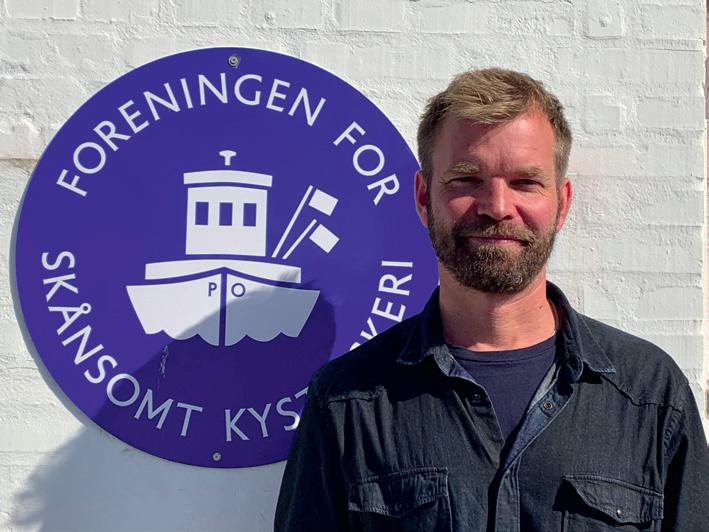
including a state-authorised label for sh caught with low-impact gear, Naturskånsom. To use this label the sh and the sher must ful l certain requirements: the sh must be caught with lowimpact gear; the species may not be threatened; the sh should come from healthy stocks; the vessel must fall under the coastal shery regulation; and the sher must have completed a course in food quality.
Another challenge was to secure a future for the coastal eet as the restructuring of Danish sheries some years earlier had resulted in a consolidation of quotas in the hands of a few large vessel
owners. FSK-PO therefore negotiated a fraction of the quotas to be earmarked for the coastal shery. Since the PO was established in 2019 FSK-PO has contributed to another piece of political work, the Fisheries Commission, a body established to consider the future of Danish sheries. In some ways this was an outcome of being declared a PO. is new status entitled FSK-PO to membership of certain committees where it could not participate before. As a PO the organisation was taken more seriously and its opinion carried more weight than it did prior to becoming a PO. But the process of becoming a PO was not easy and there was little or no support from either the other local sheries organisations or the administration. Since attaining PO status, however, Mr Lange


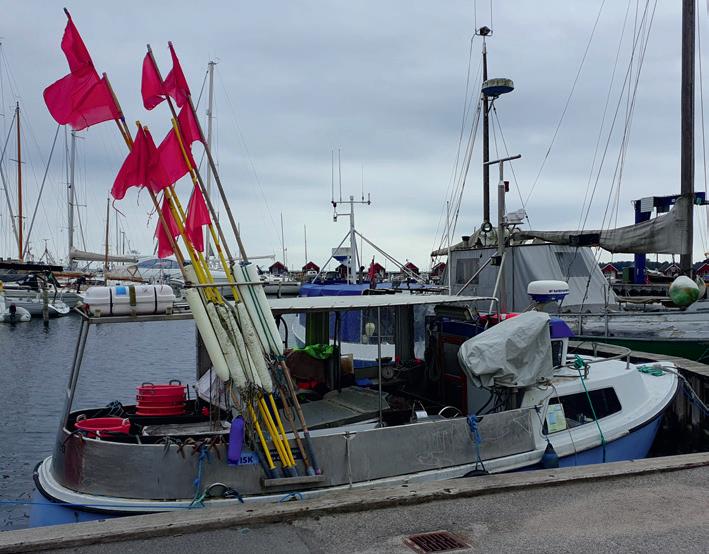
has been contacted by several European organisations that are trying to form a common front for the segment they represent. He attributes the interest in FSK-PO partly to its status as a PO, but also because the experience of dealing with European and Danish institutions is valuable and can be used in other contexts as well as by other shing organisations seeking this status.
We want to secure shing rights for the low-impact coastal shery, Mr Lange says. e state still has some rights and these can be used to incentivise the coastal shing industry. e coastal sheries regulation comprises an open, time-limited agreement and a closed (unlimited) agreement. Fishers signing up to the open agreement can leave it after three years if they want. Fishers joining the closed agreement get a higher quota than those in the open agreement but can only sell their quota to vessels that are also part of the closed agreement. Vessels in the closed agreement shing with low-impact gear get an additional quota allocation in contrast to those shing with conventional gear. Mr Lange would like to

value-added. To increase the volume of sh sold under the label the Fisheries Commission recommends that eligible vessels should also include those longer than 17 m and with shing trips of above 48 hours—if they use low-impact gear and catch from fully documented sheries. e commission also recommends launching new campaigns to increase awareness of the label and to expand the market as the volume of sh under the label increases. Also, more species should be added to the regulation periodically to increase the attractiveness of the label.
see the open agreement, which was introduced as a temporary measure though since renewed, terminated permanently as he feels it undermines the sustainability principles underlying the coastal shery regulation. It was an attractive measure for shers when it was introduced, but for the next generation and for the future of the shery in general, it is now time to close it.
e Naturskånsom label has not yet taken o among consumers as was envisaged when it was launched. is is partly because volumes are limited since only few vessels have signed up to the regulation. Product under the label, that coastal shers may use if using low impact gear, has been sold mainly to wholesalers who distribute it to their customers. e fact that it is a state authorised label is an advantage as it increases credibility among Danish consumers. However, experience from other sectors has shown that a label such as Naturskånsom can lead to better prices and greater
According to Mr Lange, there is signi cant potential for more shers to join the coastal shery regulation despite the falling numbers that characterise this segment. But across the EU one of the biggest challenges is the mounting age of shers. In Denmark the average age increased from 46 to 58 between 2000 and 2022, according to the Fisheries Agency. Other countries are worse a ected—in Toscana the average age is 62. is is one of the biggest challenges we face, Mr Lange concedes. He recently concluded a project in a Fisheries Local Action Group that looked at barriers to becoming a sher and can o er some explanations for the low level of interest in the profession—the negative image associated with shing, lack of exibility, and for some, the absence of knowledge about how to become a sher. Young people may not know that they can become coastal shers with a small boat and short trips, or they can work on board a large pelagic trawler with all the conveniences of a modern o ce. Despite the challenge of getting young people to take over, an issue that could
prove an existential threat for the sector in the long term, Mr Lange thinks that Denmark could play a leading role in the EU shing sector’s green transition. He has a vision of a diverse shing sector with a strong coastal shing segment comprising smaller vessels (perhaps some of them electric or with hybrid powertrains) that can sh close to or in wind farms at sea to exploit the sh that accumulate there. He sees this as a way of strengthening coastal communities both economically and socially and of mitigating sheries’ impact on the climate. Lowimpact shing in large contiguous areas such as the Sound between Denmark and Sweden fosters biodiversity. is in turn makes sh stocks more resilient in the face of other impacts such as pollution and predation.
Instead of volumes fishers should aim to increase value
He is also keenly aware that shers must live up to their obligations under EU legislation such as reducing discards. For coastal shers using low-impact gear

Coastal fishers can use low impact gears such as gill nets. These are suspended in the water and are typically emptied within 12 to 24 hours.


discards are not an issue, so there is a certain self interest in calling for compliance with rules concerning discards. at said, more selective shing is in the interest of the stocks and of the marine environment, and in Mr Lange’s view, shing needs to move away from thinking in volumes towards focusing on creating greater value. At the same time, he feels strongly that eating sh should not just be the prerogative of the rich. To reconcile the con ict between greater value and a ordability Mr Lange’s solution is to have a varied shery with species in different price ranges. Other issues that he feels need to be addressed include shing rights, where a quota owner’s income comes from renting out the quota rather than shing it themself. is puts a very di erent perspective on the activity compared to when oneself is on the water. But Mr Lange admits that the sector itself could have been more pro-active about adjusting to new circumstances, taking initiatives, and being less xated upon doing things the way they have always been done. He sees a potential future for shers in mixed activities, where they sh for part of the year, while for the rest they harvest seaweed and farm oysters, for example. is
form of primary production may also prove attractive to a new generation of shers, if they experience that they are not only taking something from the sea but also giving something back in the form of seaweed or bivalves which contribute to the health of the marine environment. In addition, at least some future shers may not work full time catching sh, but instead combine their shing activity with another job, perhaps one that is paid well enough that they have no real economic need to sh, but do it more as a welcome diversion from their main work. However, the rules structuring this are not exible enough to facilitate this kind of combination of activities. Mr Lange would like to see greater exibility in the rules not only to attract a new generation of shers, but also because by attracting younger people and enabling different models of employment it would promote innovation. Older folk are by nature less inclined to run the risks innovation demands.
e new sheries control regulation envisages the complete digitalisation of the control system

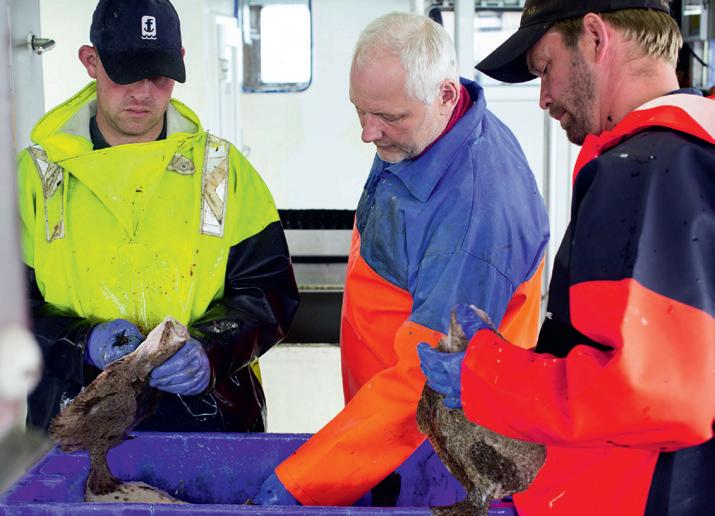
The coastal fishery targets flat fish of various kinds including flounder, plaice, brill, turbot, and sole but also cod (when it was allowed), and mackerel usually in summer.
by gradually expanding the geo-localisation and electronic reporting to all shing vessels, irrespective of their size. All vessels will be tracked by a vessel monitoring system and all catches will be recorded electronically. In general, the coastal shers are resigned to the increased control. Most can accept that when exploiting a common resource, a degree of control is inevitable, Mr Lange explains, but they also feel that when there are already so many restrictions on their work further control is unnecessary.
e coastal shery has the advantage of a short supply chain and therefore a very fresh product. In addition, there are potential opportunities in the exploitation of new species such as crabs and
squid. But Danes need to get better at eating sh—weekly per capita consumption at 259 g is 100 g below the o cial recommendation, according to the Fisheries Commission’s report. To increase this the commission recommends increasing the visibility of high quality sh by highlighting its favourable environmental credentials in contrast to other sources of animal protein. Other suggestions include focusing on species such as squid, ounder, and mussels, that are not fully exploited, and making further improvements regarding treatment of the catch (use of ice, gentle handling) to increase quality. Over the medium term these initiatives are likely to increase local consumption of Danish sh to the bene t of the coastal shing sector.
Foreningen for Skånsomt Kystfiskeri Producentorganisation (FSK-PO)
Nordhavnsvej 6A
3000 Helsingør
Denmark
skaansomtkystfiskeri.dk
Chairman: Søren Jacobsen soeren@fskpo.dk
Director: David Lange david@fskpo.dk


A Danish vocational school exploits the climate and health benefits of macroalgae
ZBC, Denmark’s largest vocational school, introduces seaweed into its courses for chefs, nutritionists, and other food-related careers. The enthusiasm for these organisms stems from staff who recognise its healthful and carbon-mitigating properties.
The Roskilde Agriculture and Livestock fair (Roskilde Dyrskue) is Denmark’s largest event of its kind and dates to 1884 when the rst edition was held. Although dedicated to the agriculture sector it also caters to pet owners and o ers stands selling everything from wooden clogs to combine harvesters. e fair aims at promoting Danish agriculture and livestock and is a venue where experts and laymen can meet and exchange knowledge and experience related to farming and animal husbandry.
A programme of activities for each of the three days of the event covers topics broadly related to agriculture, food, and animals. Dissemination and outreach activities are focused particularly on school children to inform them about agriculture and livestock in Denmark, and what they mean for the country’s economy, culture, and traditions. e subject matter and the presence of a large audience attracts exhibitors involved in the production and marketing of food and drink, raw materials, and ingredients, among others with connections to food and food processing.
ZBC, one of Denmark’s largest vocational training schools with

branches in nine Danish towns, o ers several programmes related to food and agriculture. Some of these students and their teachers had a booth at the Roskilde fair where they prepared and served hotdogs with a twist. Instead of buying a traditional hot dog with toppings of ketchup, mustard, pickled cucumbers, and fried onions, visitors could opt for a topping based on seaweed. e idea came from Pelle Nylander Petersen-Sonn, a sta member
at the school with an interest in sustainability. e school started working with macroalgae (seaweed) seven or eight years ago when Mr Petersen-Sonn and a colleague visited Dansk Tang, a company that harvests and ships fresh seaweed from its location in Nykoebing Sjaelland on the west coast of Zealand. During a seaweed safari at the company, Claus Marcusson, the CEO, explained to Mr Petersen-Sonn and his colleague about seaweeds and the
health and environmental bene ts they o er.
Algae initiative seeks to boost EU seaweed sector
ese characteristics prompted the EU to adopt an algae initiative in 2022 that would increase the cultivation of algae and promote its use as food for human consumption. In other parts of the world, and especially in Asia, which accounts



for about half the global algae production, algae consumption has a long tradition. In addition to their use as food, algae have several potential commercial applications including in the pharmaceutical, nutraceutical, and cosmetics industries, as biofuels and plant bio-stimulants, and in bio-packaging. eir positive environmental impacts are attracting a lot of attention too. Algae contribute to regenerating coastal ecosystems thanks to their ability to dissipate wave action thus helping to prevent coastal erosion. ey can also x carbon dioxide and nutrients, and generate oxygen thereby combating water pollution, mitigating coastal eutrophication, and reducing ocean acidi cation.
ZBC has been serving hotdogs at the agriculture show for several years. It is a collaboration between

ZBC they dislike the idea or because they consider it dangerous, so the purpose of serving seaweed with the hotdogs at the fair was to introduce it to people and show them how it could be used. Seaweed is available on the market, says Mr Petersen-Sonn, usually dried, and it can be purchased online, but consumers do not know what to do with it. Educating them is going to be a long process even if it started some years ago when smart restaurants started serving seaweed in di erent forms. Now it is being sneaked in here and there, at the agriculture show, for example, so people discover it doesn’t kill them and in fact can be quite tasty.
ourselves, butchers, and bakers, Mr Petersen-Sonn explains. e idea of using seaweed came from the teachers who found it an interesting ingredient and one they felt students studying to become chefs or nutritionists should learn about given the advantages it o ers. e leadership at the school supported the initiative and proposed that seaweed be served along with the hotdogs at the agriculture fair. With guidance from their teachers the students created a ketchup using serrated wrack (Fucus serratus) that could be eaten with the hotdogs. ey also invented a seaweed substitute for the pickled cucumbers using Irish moss (Chondrus crispus), and as a substitute for the fried onions they prepared dulse (Palmaria palmata) by drying it in the oven and then crisping it with a coating of oil. Many people are wary of eating seaweed because
e school’s objective is to try and bring seaweed to the average consumer—get them to consider substituting the pasta in a pasta salad with seaweed, for example. ere is in fact a variety of seaweed, sea spaghetti or thong weed (Himanthalia elongata), that can be used for the purpose. All the seaweed used in the school comes from Danish or at least Scandinavian waters, according to Mr PetersenSonn. ZBC’s students that are studying in one of the food-related programmes are taught about seaweed. When they graduate and nd work in restaurants, canteens,
or institutional kitchens, they function as multipliers for the promotion of seaweed. ey can introduce it into the food they serve thereby exposing their guests to the product or, if working as nutritionists, they can advice their clients about the bene ts of seaweed. e initial reaction from the students themselves to the seaweed varies depending on the age, sex, and how open they are to new tastes and textures. But most of them are convinced by the time they conclude their programme. Although the school has been working with seaweed for some years, the sta learn something new each year, for example, how di erent varieties react to being prepared in diverse ways. e knowledge gained from each batch of students is then passed on to the next batch. European seaweed production and consumption is still a fraction of that seen in other parts of the world, so every initiative to increase this is welcome. e greater the development in this direction, the more the bene ts accruing to the planet— and to the individual.
For more information, contact Pelle Nylander Petersen-Sonn, ps@zbc.dk
Ahorn Alle 3-5 4100 Ringsted
Denmark
Tel.: +45 5578 8888
zbc@zbc.dk zbc.dk
2 dl vinegar
2 dl sugar
1 dl water
5 cardamom pods
1 tsp mustard seeds
1 tsp coriander seeds
2 handfuls of Irish moss (Chondrus crispus)
Combine the ingredients except the seaweed and boil. Put the freshly washed seaweed in an airtight container and pour over the boiling mixture. Cool and then refrigerate for four to five days. It can be used in place of pickled cucumber.

Estonian fishers are active in the Baltic, in coastal waters, inland waters, and also maintain a distant water fleet. The diversity of waters, vessels, and gears is a strength at a time when raw materials are becoming difficult to source.
Estonia is a natural maritime and shing country on the Baltic Sea coast, where the coastal people have been dependent on the changing sea that has shaped their daily culture and spirituality, beliefs and customs, and their traditional way of life. Historically, whole villages of men and women have gone shing. Apart from shing, the coastal villages were also engaged in shipbuilding, seafaring, and the training of sailors. e in uence of the sea can be observed in all cultural spheres, whether material or spiritual. What has been inherited from past generations, created on their own, or adopted from elsewhere, has—throughout the ages—shaped Estonian culture as a whole.1
e sh supply chain starts with raw material which is caught or farmed; processing adds value to the fresh raw material and increases the shelf life apart from creating a tasty product for either human or animal consumption on the domestic or foreign market.
More than 73 thousand tonnes of sh were caught in 2023 (Figure 1), a magnitude similar to the previous year. Distant-water shing in 2023 amounted to 13 thousand tonnes. e main species caught were northern prawn, cod, red sh, and Greenland halibut. In a yearon-year comparison, the catch
was down 13. Trawling in the Baltic Sea amounted to 45 thousand tonnes, down 2 compared to the previous year. e main sh species caught were Baltic sprat and Baltic herring. Due to the poor state of the stock, cod shing has essentially not occurred in the last ve years. Coastal shing in 2023 amounted to 12 thousand tonnes. Economically, the most important species are Baltic sprat, perch, smelt, gar sh, zander, roach, and vimba bream. In addition to sh, the harvesting of furcellaria seaweed also plays an important role in commercial coastal shing. ere is a signi cant amount of commercial shing in inland waters in the lakes Peipus and Võrtsjärv. In 2023 this amounted to 2,500 tonnes. e main sh species caught were perch, zander, common bream, roach, pike, river lamprey, burbot, and eel.
e Agriculture and Food Board currently supervises 108 licensed processing facilities, whose main activity is the processing of shery and aquaculture products and the manufacture of various products. e number of sh treatment sites has remained stable over the years. e main activities include the freezing and lleting of sh, production of tinned and preserved sh, and prepared meals.
Estonia catches many times more sh than it consumes, mainly Baltic sprat and Baltic herring, so we are self-su cient in sh from a food security perspective.

Estonian sh processors have long traditions, know-how, and experience in producing sh products. Entrepreneurs, in cooperation with researchers, are investigating and developing methods to use local untapped or underused living aquatic resources—such as molluscs or seaweed—for food, feed, reducing environmental impacts, optimising energy use, and nding solutions for more sustainable or circular use of other resources important to processing. Finances from the European Maritime, Fisheries and Aquaculture Fund (EMFAF) are available to support raising awareness and develop export opportunities and investments.
fishing contributed a fifth to commercial catches
e Estonian distant-water shing eet is active in the Atlantic: in the
North-East Atlantic, mainly in the waters of the North-East Atlantic Fisheries Commission (NEAFC) (in the Barents Sea) and in the Svalbard region; in the NorthWest Atlantic, in the waters of the Northwest Atlantic Fisheries Organization (NAFO). ey also sh in the waters of Greenland. Compared to the 12 vessels it had 20 years ago, the distant-water shing eet has been reduced to 6 active vessels. e main species caught are northern prawn, cod, red sh, and Greenland halibut, with the total catch amounting to 13 thousand tonnes and accounting for almost 19 of Estonia’s commercial shing. In 2023, the total value of distant-water shing was approximately EUR49 million.
Trawlers in the Baltic Sea target mainly small pelagics
Fishing in the Baltic Sea is divided into o shore shing and coastal
shing. e target species for oshore shing are the Baltic sprat, Baltic herring, and cod. Trawls are the main shing gear. e trawling sector of the Baltic Sea has undergone a signi cant reduction in shing capacity over the last decade, bringing stocks into line with shing capacity. Seventeen companies operate in the trawling sector, with a total of 24 vessels. Baltic sprat and Baltic herring amounted to almost 100 of trawl catch in 2023. Trawling (with a catch of 45 thousand tonnes) accounts for nearly 62 of the total commercial catch, and the total value of trawling in 2023 was over EUR15 million.
A wide variety of sh species are caught in coastal shing. Economically, the most important species are the Baltic sprat, perch, smelt, gar sh, zander, roach and vimba bream. In addition to sh, the harvesting of furcellaria seaweed also plays an important role in commercial coastal shing. Fishing is regulated by the number of shing gears, and in part by the block quota (total allowable catch). e block quota governs shing for cod, Baltic herring, salmon, and Baltic sprat. ese shing arrangements are based on

recommendations from researchers on the number of shing gear and allowable catches. Fish traps, nets, and longlines are the main shing gear. A total of 16, or 12 thousand tonnes, of Estonia’s commercial catch is caught in coastal shing, where 1935 licenced shermen operate. Saare County has the most shermen, followed by Pärnu County, Hiiu County, and Harju County. For a large proportion of shermen, shing is only a seasonal source of income, and it is estimated that only 10 of coastal shermen get their main income from shing. ey use shing vessels up to 12 m in length, 2,016 of which have been entered into the register. e number of shing vessels has increased steadily over the last ve years. Based on rst-sale prices, the value of coastal shing catch amounted to EUR 6 million, with perch accounting for EUR 2.3 million and Baltic sprat for EUR 2.2 million.
For local communities inland fishing is a small but important activity
ere is a signi cant amount of commercial shing taking place in the inland waters of Lake Peipus and Lake Võrtsjärv. e main sh species caught are perch, zander, common bream, roach, pike, river
lamprey, burbot, and eel. Fishing is regulated by the number of shing gear, and in part by the block quota. Fishing opportunities are allocated to commercial shermen based on historical shing rights, in the form of gear limits. e block quota governs shing on Lake Peipus, Lake Lämmijärv, and Lake Pihkva. As is the case with the coastal eet management is based on researchers’ recommendations regarding the number of shing gear and allowable catches. Fishing gear includes nets, shing traps, pound nets, and Danish seines. Fishing arrangements and catch volumes for Lake Peipus, Lake Lämmijärv, and Lake Pihkva are agreed annually with the Russian Federation. A total of 2,505 tonnes of sh were caught in inland waters in 2023, with a total value of EUR 5.7 million at rstsale prices. In 2023, 512 vessels were used for shing, and there were 592 professional shermen operating on inland waters, with 345 permit holders.
exports account for over a tenth of total agricultural exports
e shing industry is exportoriented, with a total of 48 export destinations in 2023. e export turnover of sh and shery products
produced or processed in Estonia amounted to EUR 153 million (Figure 2), accounting for 11 of the export turnover of agricultural and food products of Estonian origin. e largest share of exports in 2023 was made up of crustaceans (27), frozen sh (21), and sh products and canned sh (17). e share of crustaceans in turnover increased by 2 percentage points. e most important export destinations for the sheries sector were Ukraine (15 of the export turnover), China (14), Sweden (12), Finland (8), and Iceland (7). Sweden, Finland, Norway, Latvia, Ukraine, Switzerland, Iceland, and China have been the most stable export partners for the sheries sector over the years.
As challenges multiply they must be converted to opportunities
Investments and export growth can be expected by an entrepreneur with a clear long-term strategy, a multi-year business development plan, the ability to generate turnover, and to prove that their product is the best to meet customer demand in their target market. ere are several challenges that also have a direct impact on the international sh market: the general contradictory economic indicators, the war zones near the

borders of Europe, the onslaught of protectionism, climate change, migration, and the technological revolution linked to arti cial intelligence. Current international conditions have not been as daunting in decades. One of the issues that will certainly need to be addressed in the future is the exploitation of challenges as opportunities. e innovative products and strategies we have utilised to get to where we are today may not help us in the future.
Globally, production growth is currently being driven by aquaculture products—a trend that is likely to continue but is likely stabilising. At the same time, productivity growth in aquaculture production will be lower than in the previous decade. World shmeal production is on a slight upward trend. At the same time, shmeal production is growing at a slower pace than global aquaculture products, so the use of oilseed-based feed in the aquaculture sector is likely to increase. e consumption of sh per capita is on the rise in almost all regions except Africa, where a minor decline is forecast. For sh products, nominal prices are expected to increase, but real prices to decrease. e price of sh oil peaked between 2022 and 2023 and is expected to normalise and grow more steadily over the next decade.2
In Estonia, shing, the production of aquaculture products, and the processing and distribution of shery and aquaculture products are part of food production, a strategic sector from a security perspective. e total value of exports of Estonian shery and
aquaculture products in 2022 was over EUR 153.8 million, of which frozen sh, for example, accounted for over 60 of exports in terms of volume, so it is possible to move towards product diversi cation and product development in the processing sector (Figure 3). “In 2023, the total value of exports of shery and aquaculture products of Estonian origin declined somewhat, to around EUR 153 million. At the same time, the quantities of shery and aquaculture products of Estonian origin have fallen from 83,000 tonnes to 68,000 tonnes over the year. us, ensuring the competitiveness of existing processing units is becoming increasingly important in a situation where raw materials are decreasing globally,” explains Madis Pärtel, Deputy Secretary General for Bioeconomy at the Ministry of Regional A airs and Agriculture, who is also responsible for sheries policy since 2024. Ultimately, the Estonian sheries sector has weathered the difcult situations of recent years relatively well, but the shortage of raw materials is forcing it to move in new directions. “By moving towards nal food products with higher added value and making better use of available resources, we can ensure the pro tability of companies operating in the sector,” he predicts.
e implementation of EMFAF in the coming years will continue, for example, with market 2
development support, which will provide additional leverage for three types of activities. Firstly, it will enable market surveys to be conducted, to better understand both local and foreign processes and consumer expectations. Secondly, it will enable participation in local and international thematic trade fairs as an exhibitor or a business delegation. irdly, it will encourage obtaining higher certi cations and labels of compliance with sustainability or quality requirements for one’s products, to meet consumer expectations and remain competitive in target markets.
e Agriculture and Food Board is the supervisory authority for food systems in Estonia, and one of its areas of activity is also ensuring that international trade, including
Source: Statistics Estonia
trade in sh, is compliant with regulations. e EMFAF funds will be used to promote activities for opening external markets and keeping them open. For example, requirements of external markets can be speci c to countries as well as product groups. ey can include various certi cates, registry entries, laboratory tests, import and/or transit authorisations, etc. An entrepreneur can start exporting their products to the target market only when the terms of trade have been agreed upon between the foreign country and Estonia.
Support during the energy crisis kept the industry on its feet
Since the middle of 2022, Estonian companies have felt
Source: Statistics Estonia


the setbacks in competitiveness in both European and global markets. At the end of 2022, the assessment of industrial companies on their competitiveness in external markets fell to a lower level than it had been during the financial crisis.3 The geopolitical crisis in Europe, triggered by the changed security situation, led to a sharp increase in the prices of energy carriers. Together, these effects caused serious disruptions to the EU economy as a whole. In this situation, it was essential that the sector was supported through compensation for the surge in fuel and electricity prices, which made it possible to offset the increase in input costs and maintain the profitability and competitiveness of the fisheries sector. The support enabled Estonian companies to overcome economic difficulties and continue their activities, i.e., to supply fish products, generate income, keep existing jobs in rural areas, export their products where possible, and to invest in making their activities
more energy- and resource-efficient. The partial compensation of additional costs caused by the increase of fuel and electricity prices was a short-term mitigating measure, but it helped the sector cope with the negative economic effects.
Price rises in recent years have changed attitudes towards energy sources, and society has become more interested in greener options, which in turn has also led to the planning of offshore wind farms. The debate on wind energy must not overlook the impact of major innovations on sectors other than energy, including fisheries.
“As of today, businesses have already made, or are in the process of making, investments in energy- and resource-efficiency. This transition across the whole sector will take time and financial resources, and, in some cases, its implementation will depend on technological advancement,” says Mr Pärtel.
Estonian coastal shing has long traditions; commercial shing in inland waters is also a unique characteristic. Fishermen must often contend with natural competitors, especially seals and cormorants.
ere must be enough sh for all—a balance between sh stocks and shing opportunities is essential. If a boat were to dock and lift only empty boxes ashore, no seabird would bother to take to the air to greet the shermen. Fishermen in Estonia have managed to avoid this bleak scenario. Challenging times bring out hidden potential, adds Mr Pärtel.
Estonia is one of the smallest countries in Europe, in terms of both territory and its population of 1.3 million people. Limited resources have required us to be more e cient and innovative in managing both the economy and social processes. We have built up an e-state to facilitate all kinds of daily transactions, for

example PERK (a digital declaration system developed by the Estonian sheries), states Piret Hartman, the Minister of Regional A airs since April 2024. “Fisheries is very important when it comes to food security. Estonia is self-su cient but also exports signi cant amounts to foreign markets. For us, it is important that we keep the shing sector sustainable, maintain the biodiversity of our nature, and at the same time contribute to Europe’s unitary sheries policy,” Mr Hartman adds.
Services play an increasingly important role in today’s economy. e shift from a traditional productbased economy to a services-based economy has led to signi cant changes in the strategies of companies and organisations, as well as in consumer expectations. is shift is not just a trend, but a fundamental change in the way companies create value and how that value is perceived and appreciated by society.
Eduard Koitmaa, Kairi Šljaiteris Ministry of Regional A airs and Agriculture of the Republic of Estonia

Fish and seafood consumption in Estonia has increased despite the negative impact first of the pandemic and subsequently of inflation. However, Estonians have a way to go before they are eating the same amount as the average EU citizen.
In 2022, the Ministry of Regional A airs and Agriculture commissioned a survey on the consumption of sh and shery products from the Estonian Institute of Economic Research. e study investigated how consumption habits regarding sh and shery products in Estonia have changed in the period 2020–2023 and what consumers consider when choosing sh products. e results of the survey proved to be comparable with those of similar surveys conducted previously.
Previous surveys were based on household survey data. For the period 2021–2023, consumption quantities were calculated based on resources. e calculation of resources for shery and aquaculture products was based on the quantities of sh caught, exported, and imported. Of the resources (156,700 tonnes in total), 93,600 tonnes were exported. Of the resources that remained in Estonia, 39,200 tonnes went into non-food consumption, leaving an estimated 23,910 tonnes for food consumption, or 17.5 kg of sh per capita. Resource-based calculations also showed that the consumption of sh and shery products in Estonia increased from 15.0 kg per capita (live weight) in 2021 to 17.5 kg in 2023.
Consumption per capita is in uenced by several factors:
consumption habits and preferences, nancial means, product availability, quality, and price uctuations. In 2020–2021, the restrictions of the COVID pandemic still had a signi cant impact on the consumption habits of the Estonian population, forcing people to replace eating out with ordering food to their homes. When the e ects of the pandemic subsided in 2022, the accelerating increase in prices began to a ect consumption, which continued in 2023. According to Eurostat, Estonia had the second-highest increase in prices of shery products across the EU in 2022–2023. In a comparison of all food product groups, the shery product group increased the most in price. Both in Estonia and in other European Union countries, the price of imported sh plays an important role in changes in the prices of sh and shery products, as it accounts for a signi cant share of the output consumed.
Over the last decade, consumer prices of shery and aquaculture products have risen by an average of 3.6 per year, which is only slightly more than the rate of increase for meat (3.1). Historically, however, spending on sh and shery products is signi cantly lower than on meat and meat products in all EU countries, as well as the quantities consumed. According to the most recent household survey, Estonian people consume 5.6 times more meat and meat products than sh and shery products. Accordingly, spending is four times higher.

e consumer survey conducted in autumn 2023 examined the population’s consumption habits, satisfaction with consumption, purchasing preferences, and shopping locations regarding sh and shery products. e results of the survey reveal an important generational characteristic—the older you are, the greater the tendency to eat sh. It can be concluded from this that sh producers and retailers should engage in marketing and product development targeted speci cally at young people to better match their consumption habits. Today’s young people are not inclined to buy fresh sh at the market early in the morning and prefer sh products that do not require pre-treatment.
The 2023 fish and fishery products consumer survey examined for the first time how consumers rate their consumption habits compared to the previous year. Respondents who said they ate more fish than in the previous year did so primarily because it was healthier and because fish and fishery products are tasty. The results reflect the continued love of fish dishes made from fresh and chilled fish among Estonians. Salmon and trout dishes, salted and spiced fish, and fish dishes made from fresh Baltic herring and Baltic sprat are considered the most tasty.
Although the Estonian dietary recommendations suggest that fish and fishery products should be consumed at least three times a week, the high price of fish products is seen as a major barrier. It is therefore necessary for retailers to find ways

to offer consumers a consistently good price. In addition, the origin of the raw materials, the cleanliness of the point of sale, and the freshness of the produce are decisive factors for the consumer in the purchasing decision process. Consumers have become increasingly adept at reading the information on product labels, and while the origin of raw produce and the cleanliness of the point of sale are considered important, the
freshest fish can still only be bought directly from local fishermen.
e volume of sh consumed by the Estonian population remains below the European average (23.7 kg per capita), and there is still a long way to reach this level. To encourage this, a
sh promotion campaign is run every few years, which serves as a positive reminder for people to dust o their sh dish recipes and put them to use. In 2022, the European Commission approved the European Maritime, Fisheries and Aquaculture Fund (EMFAF) 2021–2027 Operational Programme for Estonia, which includes a future sh promotion campaign among its information and consumption promotion activities.
Dam-mapping exercise contributes to improving situation for fish fauna
For more information in Estonian https://agri.ee/ministeeriumuudised-kontakt/uuringud?view_ instance=5¤t_ page=1#turu-ja-tarbimisuur and in English https://eumofa.eu/ documents/20124/35668/EFM2023_ EN.pdf/95612366-79d2-a4d1-218b8089c8e7508c?t=1699541180521
Laura Freivald-Heapost Ministry of Regional A airs and Agriculture of the Republic of Estonia
Estonia has abundant supplies of water. Around 70% of Estonia’s border is water, most of which is the Baltic Sea with Lake Peipus, the fifth largest lake in Europe, creating the remainder. All this water together with the many other lakes and rivers mean that Estonia is generally well endowed with fish resources.
Fish and shing have been an important source of income for Estonians, and sh has been central to the diets of inland shing areas. e shing sector and its regulation is therefore an important issue. e more science and technology have advanced, the more is known about the inputs and variables that determine the state of sh stocks, making it possible to optimise management. One of the most important inputs for ensuring healthy stocks is the availability and accessibility of spawning grounds.
Many dams have lost their original purpose but their impact on nature continues

fish free passage, it is not always possible.
The European Union’s Water Framework Directive requires Member States to ensure that water quality enjoys “good status”, a term that also covers fish fauna. Estonia reached a major milestone in 2009, when the state adopted the obligation to ensure the free movement of fish in salmonid rivers which included implementing solutions that enable free passage past dams in cases where the height of the dam exceeds 30 cm.
In the last century, hundreds of dams were built on rivers in Estonia to operate hydroelectric power stations and water mills, but over time they have lost their original purpose. ere are an estimated

1,100 manmade dams in Estonia, or 2.7 dams for every Estonian river. However, spawning grounds in inland bodies of water have degraded for a variety of reasons, such as sediment accumulation, land reclamation, ooding by the reservoirs created by dams, and post-glacial rebound. ese factors explain why sh stocks are not recovering. Addressing these issues could by the same token contribute to an improvement in the state of sh fauna in Estonian water bodies. To implement the obligations of the Water Framework Directive, dismantle dams, and restore spawning areas, the European Union lent a helping hand. Around EUR50m has been invested in dam removal and sh pass construction over the past 15 years, and to date 91 sh passes have been built and more than 50 dams removed in Estonia.
Although many sh passes have been built, their performance does not always meet expectations. Based on Estonia’s experience, the best solution for sh migration routes so far has been the removal of the dam, which would ensure full freedom of movement for sh. However, such a solution is not always possible. e next most appropriate solution is an arti cial rock ramp shway, which is a rather costly solution, albeit e ective. A third option is a sh pass, which entails considerable maintenance costs and could extend the impact of the reservoir on the whole river system. Since reservoirs engulf spawning grounds, even if sh migration is ensured with a sh
pass, the sh would still lack a place to spawn. A reservoir can also signi cantly raise the temperature of river water often making the river unsuitable for sh, in which case a sh pass would be of no use. Estonia’s experience with constructing sh passes unfortunately shows that around a third of them do not work. is is primarily the case with technically complex solutions such as sh elevators and high sh locks.
One of the most important drivers of the dismantling of dams and the restoration of spawning grounds is the introduction of a national requirement to ensure salmonids’ access to suitable habitats in rivers and the
presence of accessible spawning grounds in key habitats. Specialists have mapped around 1,000 dams in Estonia and assessed their impact on nature. e exercise included proposals for different alternatives for the passage of sh. e mapping of dams created a basis and an opportunity to e ectively and systematically improve the situation for sh fauna in Estonian rivers. is set the stage for everything that followed regarding the dismantling of dams and creation of spawning grounds. Rivers are now being assessed in a holistic manner and works on dams and spawning grounds are being planned as a single package.
Tanel Ader Ministry of Regional A airs and Agriculture of the Republic of Estonia

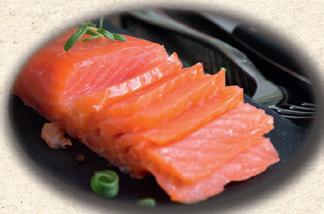
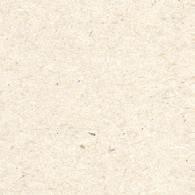

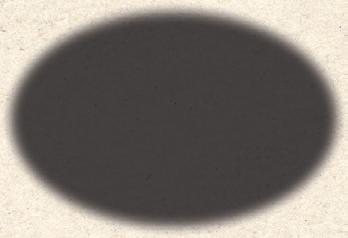











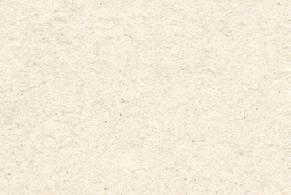


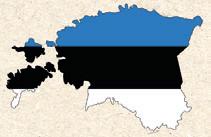





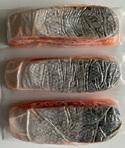



There is increasing interest in marine nature restoration projects as a tool for improving environmental condition and biodiversity in European waters. This article describes new projects that examine the benefits and drawbacks of using concrete reefs as a supplementary tool for improving the marine environment. Key activities are conducted within the projects Circle Reef and Ocean Citizen in the western Baltic Sea.
In Denmark, there is growing societal concern for the deteriorating environmental conditions in coastal waters. Groups of citizens are forming associations that actively promote and restore a healthy marine environment. One of these initiatives is the Køge Bay Boulder Reefs (Køge Bugt Stenrev) association abbreviated KBS. KBS improves the marine environment in the Køge Bay area (Figure 1) by restoring boulder reefs. One of these projects is a reef and research project called Circle Reef. The project is funded by the Velux Foundation and conducted in collaboration with the Horizon Europe project, Ocean Citizen.
The purpose of both projects is to investigate the suitability of concrete reefs for enhancing marine nature and biodiversity in Danish waters. The projects seek to reveal whether fish and other organisms thrive on concrete reefs and boulder reefs. There are six locations considered for the installations, consisting of two boulder reefs sites, two concrete reef sites, and two reference areas with sandy bottoms (Figure 2). The Circle
Reef and Ocean Citizen projects will compare the effects of concrete and boulder reefs on the marine environment, including fish abundance, biodiversity, and vegetation. This study is the first to make such systematic comparison. Baseline measurements were conducted in fall/winter 2023 on the six locations in Køge Bay. All six locations consisted of sandy bottoms. The measurements suggest that the sandy bottom supports some unstable seaweed vegetation and small fish, including a few seaweed pipefish and gobies, as well as shore crabs.
































































When constructing new marine habitats in Denmark, including the installation of reefs, it is important to discern between two strategies: nature restoration and nature improvements. In a marine context, nature restoration is the re-establishment of a habitat in an area where a certain habitat has been lost. Hence, it is necessary to know that the habitat historically existed in the area where the restoration is desired. In terms of restoration of boulder reefs in Denmark, the goal is to match, as closely as possible, the historical boulder reefs that were once present in most Danish coastal waters. Ideally, the boulders that are used should be natural boulders. It is important to note that artificial materials like concrete are not considered suitable for nature restoration projects in Denmark1
1 Petersen, et al., (2024). Center for Marin naturgenopretning. Avaibilble at: marinnatur.dk: https://marinnatur.dk/media/72602/begreber-i-relation-til-marin-naturgenopretning_2_ udgave.pdf












In addition to nature restoration, nature improvements represent a tool for improving nature conditions by creating new habitats. A key difference between nature restoration and nature improvements is that nature improvements do not require documentation of historical habitat occurrences. Based on these definitions, it is feasible to establish reefs in areas where reefs have not necessarily existed historically and/or using materials that do not naturally occur. Thus, concrete reefs may be considered a tool for nature improvement.
Both the concrete reefs and the boulder reefs in the present projects are therefore expected to function as habitat-forming nature improvements. Because there is documentation of boulder removal from the seabed in the research reef areas (Figures 1 & 2), the boulder reefs can also be classified as nature restoration. On the other hand, the projected concrete reefs cannot be categorised as nature restoration because concrete is not a natural reef material.












Boulder reefs are collections of boulders on the seabed that are large enough to remain in place. Boulder reefs can be divided into “scattered boulder reefs” and “cavity-forming boulder reefs”. Scattered boulder reefs consist of a single layer of boulders distributed on the seabed, while the boulders in cavity-forming reefs are stacked on top of each other, creating space between the layers of stones. These caves
provide essential hiding places and foraging opportunities for animals, including fish, crabs, and lobsters. Both the boulder and concrete reefs will function as cavity-forming reefs.
The hard surfaces of boulder reefs provide an important habitat for many species of animals and vegetation. Sessile organisms, such as seaweed and sea anemones, adhere to the boulders, and small free-living animals, such as fish larvae and crabs, often thrive in the hiding places created by seaweed and the caves in the reef. The smaller animals function as a food source for larger animals, such as fish, seals, and porpoises. If the boulders reach the water surface, resting places for seals and birds may become available (Figure 3).
Unfortunately, many Danish boulder reefs have been extracted over centuries, typically to build harbor jetties. This practice is referred to as stone fishing (stenfiskeri). It is estimated that between 1900 and 2000 alone, 8.3 million cubic meters of boulder reef were removed in Denmark2 Historically, marine boulders
have also been extracted before 1900 for diverse purposes, but unfortunately, documentation of the origin of these boulders is limited. Due to the significant loss of boulder reefs, and the recognition of the need for them, efforts have sprouted to restore boulder reefs in the marine environment. This is, however, often costly, and prices exceeding one million euros for a reef project are common3.
Concrete reefs are artificial reefs created using concrete. Studies show that concrete is the most used material worldwide for marine construction. In the Circle Reef and Ocean Citizen projects, concrete reefs are intended to fulfill the same role as boulder reefs, and the relative effects of those installations will be compared. Indeed, concrete reefs should provide habitats suitable for animals and vegetation adapted to life on hard surfaces. At present, we have limited knowledge about the potential benefits and drawbacks of using concrete reefs in Denmark.




Figure 2: Three different areas are included in the Circle Reef and Ocean Citizen projects. There are two areas of each type and over 200 meters between each area.
2 Stubgaard, (2020). 100 års stenfiskeri har fjernet rev på størrelse med Fanø. Acquired from: DTU Aqua: https://www.aqua.dtu.dk/nyheder/2020/06/100-aars-stenfiskeri-har-fjernet-rev
3 Svendsen et al., (2019). Udtjente fundamenter i havet – menneskeskabte oaser eller marint affald?. Vand & Jord
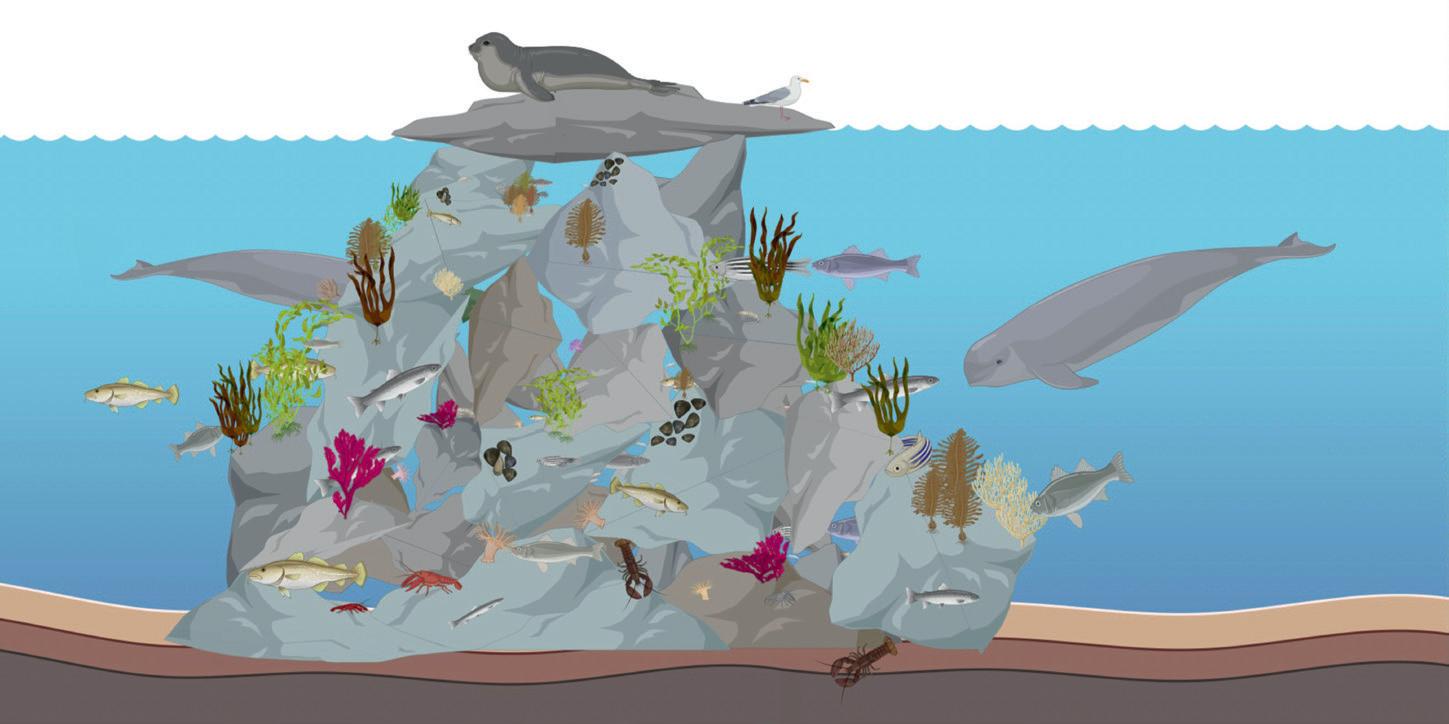
Figure 3: Depiction of a cavity-forming boulder reef. The reef creates growth areas, foraging areas, and shelter for various species of animals and vegetation.
The concrete elements have a rough surface as well as indentations and holes, which can serve as hiding places (Figure 4). Concrete can also absorb and store CO2 from the atmosphere4. This occurs when concrete absorbs CO2 from the air or water, which then binds with calcium hydroxide (Ca(OH)2) in the concrete, forming calcium carbonate (CaCO3) and water with a reduced pH value. This carbonation process is typically undesired in the construction industry because the low pH may corrode the reinforcing steel inside the concrete. However, concrete for the reefs will not contain reinforcing steel, so carbonation may prove
advantageous—calcium carbonate makes the structure more stable, resulting in a longer lifespan of the reef5.
The way life develops in the presence of artificial reefs from the initial establishment and in subsequent years depends on many factors, including reef location, composition, and environmental conditions. Generally, one can expect various species to continuously colonise the reef and contribute to its growth and abundance of life6. In Denmark, boulder reef
research suggests that it takes approximately 10 years to reach a mature stage of biological development on the reef 7 .
In Køge Bay, where the reefs will be deployed, the salinity is normally around 10 ppt. This is low compared to seawater in general, where salinities typically range between 33 and 37 ppt. Low salinity suggests relatively poor conditions for species such as seastars. As a result, we can expect that mussels may thrive better because fewer of them are eaten by seastars. Vegetation on the seabed can only survive if there is sufficient light. Since the reefs will be placed at 9-10 meters depth,
a significant amount of light is expected on the reefs. Therefore, it is likely that seaweed will grow in various places, and presumably grow from the top of the reefs. Sessile animals like mussels will likely colonise primarily the sides of the reefs8. Subsequently, fish such as flounder, goby, goldsinny wrasse, Atlantic cod, and European eel are expected to occur as part of this ecological succession. It is unknown whether the concrete reefs and boulder reefs will develop in the same way and at the same pace in Køge Bay, and the research associated with the Circle Reef and Ocean Citizen projects will specifically examine how marine life develops at the sites.
4 TÆKKER, (2022). Stone reefs in concrete to increase marine biodiversity. Acquired from: DTU: https://www.dtu.dk/english/newsarchive/2022/11/stone-reefs-in-concrete-toincrease-marine-biodiversity
5 Lothenbach, et al., (2019). Cemdata18: A chemical thermodynamic database for hydrated Portland cements and alkaliactivated materials. Cement and Concrete Research, 115, p. 472-506 https://doi.org/10.1016/j.cemconres.2018.04.018.
6 Bracho-Villavicencio, C.; Matthews-Cascon, H.; Rossi, S. Artificial Reefs around the World: A Review of the State of the Art and a Meta-Analysis of Its Effectiveness for the Restoration of Marine Ecosystems. Environments 2023, 10, 121. https://doi.org/10.3390/ environments10070121
7 Naturstyrelsen, (2013). Anbefalinger (“best practise”) til genopretning af stenrev i Danmark. Acquired from: Naturstyrelsen: https://naturstyrelsen.dk/media/qpyprw3u/anbefalingertilgenopretningafstenrev.pdf
8 Dahl, et al., (2003). Stenrev: Havets Oaser. København: Gads Forlag


Figure 4: Concrete elements used for the reefs were produced by HedeDanmark; Underwater Gardens International contributed to the final design. By zooming in on the concrete, the rough and uneven structure is visible.
There are several scientific, technical, and administrative aspects to consider when aiming for effective marine restoration to support nature9. In Denmark, there is no specific legislation that prohibits the use of concrete for artificial reefs. The Danish Coastal Authority, which is the authority that, amongst others, provides permits for marine nature improvement projects, generally does not approve the deployment of concrete reefs. However, permission can be issued if the deployment of concrete reefs is for time-limited research purposes. The Danish Coastal Authority believes that the environmental effects and durability of concrete reefs are inadequately studied—unlike boulder reefs, which occur naturally and have almost eternal durability. Although permits for concrete reefs are rarely granted, there are many industrial concrete structures in Danish waters.
These structures stay in the water for long periods of time, often for many decades. Over time, the structures become home to lots of different creatures, thus potentially contributing to the development of marine life and biodiversity. However, it is common practice to completely remove these structures once they have served their purpose10, as it is undesirable to impact the ocean unnecessarily or turn it into a landfill. It is typically a costly process to remove concrete structures, but it is not necessarily a legal requirement.
In 1995, Shell attempted to dump parts of an oil platform in the North Sea. The subsequent outcry led to Decision 98/3 of the OsloParis Convention (OSPAR 98/3) in 199811, according to which, all offshore installations (defined by the convention itself to be only oil and gas installations) must be removed after they have served their purpose12. Although OSPAR 98/3 only includes oil and gas platforms and therefore not wind turbines, bridges, etc., the
significant public attention in the 1990s made it a common practice to remove all decommissioned marine structures13
How concrete structures, especially concrete reefs, interact with marine life remains uncertain in Danish waters. The Danish Coastal Authority’s caution regarding concrete reef creation helps prevent ocean pollution and ensures that marine environments are not inadvertently harmed. Research projects like Circle Reef and Ocean Citizen provide the knowledge and technology for monitoring the effect of reefs to support the debate on whether we should create concrete reefs in the future for purposes other than research. Ocean Citizen will also develop a legal assessment of the challenges and opportunities for marine restoration activities in the EU legislative framework, which could provide some guidance to Danish policymakers. Findings from these projects will hopefully improve our understanding of the unknowns regarding
9 Verges, et al., (2024). Life on Shore - Effective Marine and Coastal Restoration for Nature and People, doi: 10.5281/zenodo.11191066
concrete reefs, including their short- and long-term environmental, social, and economic impacts. Specifically, the projects are expected to contribute to the development of future practices and policies for ocean conservation and restoration.
Authors:
Yasmin Sassa Victor (s191311 @student.dtu.dk) is a student at DTU.
Patrizio Mariani (pmar@dtu.dk) is a professor at DTU Aqua and works with marine technology
Allan Scheller (info@koegebugtstenrev.dk) is chairman of the association Køge Bugt Stenrev
Wolfgang Kunther (wolku @dtu.dk) is an associate professor at DTU Sustain
Lars Emil Juel Andersen (leman @aqua.dtu.dk) is a research assistant at DTU Aqua
Nertila Gojani (nergo@aqua. dtu.dk) is a Project Manager and Coordinator at DTU Aqua
Laura Busquier (busquier @underwatergardens.com) is Scientific Coordinator and Coastal Management Specialist at Underwater Gardens International
Marc García-Durán Huet (marc @underwatergardens.com) is Executive President & Founder of Underwater Gardens International
Jon C. Svendsen (jos@aqua.dtu. dk) is a senior researcher at DTU Aqua and works with fish, fisheries management, and habitat restoration
10 Fowler, et al., (2018). Environmental benefits of leaving offshore infrastructure in the Ocean. Front Ecol Environ, 16(10), p. 571–578, doi:10.1002/fee.1827.
11 Fowler, et al., (2018). Environmental benefits of leaving offshore infrastructure in the Ocean. Front Ecol Environ, 16(10), p. 571–578, doi:10.1002/fee.1827
12 Ministerial Meeting of the OSPAR Commission, (1998). Ministerial Meeting of the OSPAR Commission, Programmes and Measures. Acquired from: https://www.ospar.org/ documents?v=6875
13 Fowler, et al., (2018). Environmental benefits of leaving offshore infrastructure in the Ocean. Front Ecol Environ, 16(10), p. 571–578, doi:10.1002/fee.1827
The AKTEA network consists of organisations of women involved in fisheries in the EU countries as well as individual women from countries where such organisations do not exist. The women represented are typically either fishers or shellfish gatherers themselves, or contribute to their partners’ work as fishers, or work in the fish and shellfish processing sector.
In the past, women’s networks and organisations have contributed to the improvement of safety and working conditions at sea. Today, it lobbies at the European level for issues linked to women’s empowerment and for equal treatment between the genders in capture fisheries and aquaculture production.
AKTEA is led by Sandra Amézaga Menéndez of Spain who is also the head of the Spanish association, Asociación de Mulleres Salgadas, in Galicia, and Katia Frangoudes, a researcher from the Université de Bretagne Occidentale in France. That a Spaniard heads AKTEA is perhaps no coincidence as women have been organised in Spain for many years. Overall, participation by women in the Spanish fisheries sector is about 35%, but in some subsectors such as shellfish gathering or processing, they account for two thirds of the workforce, while in related industries such as netmaking and repairing they number over fourfifths of the total. Over the years, regional associations exclusively for women in the sector as well as a national body have been established that are dedicated to increasing women’s visibility
in the fisheries sector and have contributed to their empowerment, training, and leadership skills. In addition, a national strategy seeks to bring about parity between genders with equal pay for equal work, better working conditions, and improved work-life balance.
For Ms Amézaga managing at the European level brings its own challenges. Communication is one of them as meetings are often between people who have no common language making interpretation unavoidable and preventing the direct conversations that make for fruitful interactions. The organisation is not supported with European funds which is why Ms Amézaga would like to change its structure to make it eligible for support. This would also make it easier to develop projects that focus directly on the issues that concern AKTEA and ensure that the objectives are practical ones that can really contribute to improving women’s conditions. Too many projects only pay lip service to the values we are fighting for, feels Ms Amézaga, and are designed by people with little idea of equality. Women need training not only to acquire practical skills, but also to understand that they are disadvantaged, to create an awareness of women’s issues, and to stand up for their rights. In her view inequality reaches all
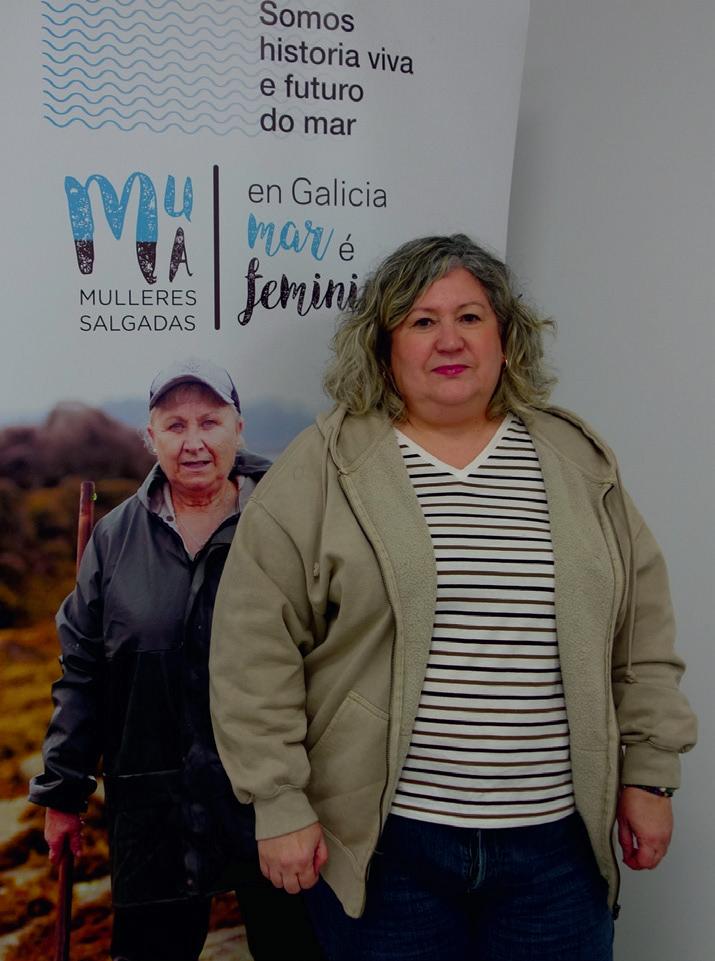
Sandra Amézaga Menéndez, Secretary of AKTEA, the Network of Women in Fisheries and Aquaculture, a European organisation, and head of the Spanish association, Asociación de Mulleres Salgadas, in Galicia.
the way to the top as women in senior professional positions are also subject to discrimination. In small cities and towns, however, the situation is much worse for women in the sector in terms of the conditions they face.
Courses offer women a space to learn and to contribute freely
One of the methods AKTEA uses to inform women is specifically designed courses adapted to
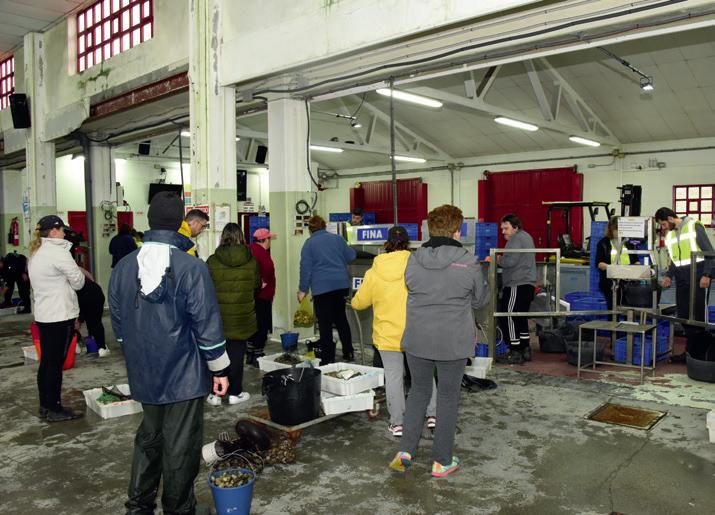
Participation by women in the Spanish fisheries sector is about 35%, but in some subsectors such as shellfish gathering, they account for two thirds of the workforce. Shown, women (and men) bring the shellfish they have harvested to be weighed before receiving payment.
their level of knowledge taking into considerations the group of women and local circumstances. The length of the courses also takes into consideration their family obligations. The courses offer women a space where they can discuss issues freely unconstrained by the presence of men. We often get questions that are completely unrelated to the issues being discussed in the course, Ms Amézaga says, as the women seek answers they can rely on. Subjects that are taboo in other fora can be freely discussed because they know that it will always stay in this space. For many it is the only time they have that is exclusively for themselves and for the issues that affect them. Concepts such as feminism are also discussed at these courses and films and television series are recommended that illustrate issues women face in other parts of the world. Often women suffer from a feeling of inferiority, Ms Amézaga points out, that needs to be addressed as part of their emancipation. Developing and conducting these courses also calls for financial support so that they can be tailored to what the women really need. Too
often courses designed by others do not meet our requirements and are in fact useless. “For example, a course where a charming man spends several hours with a group of women who can barely turn on their computers ends with the women left feeling even more clumsy and useless. That just does not work,” Ms Amézaga is emphatic. When she conducts a course, she adapts on the spot to the participants’ level of knowledge. She addresses the basic problems of demotivation, a lack of practical knowledge, and inadequate familiarity with regulations, because without these, “we are not going to see a shift in mentality.” To bring about changes in the legal framework or in other areas, women first need to feel confident and capable. She has ideas about making the systems for electing representatives to the different federations more transparent and friendly for women.
In many ways the older generation is more aware than the younger
As a European-level body, AKTEA members from the different
countries exchange information about challenges faced by members from other countries. Collaboration between members is critical if the organisation is to be truly representative. Ms Amézaga actively participates in congresses to spread information about her organisation and to expand the network of contacts. She has learned that the younger generation is in fact less aware and less committed to women’s causes than the older generation, despite the generally higher level of education. Many of the older fisher women in Spain only have a few years of basic schooling, but when speaking with them they revealed a very high level of awareness of how they were exploited and how important it was to fight for equality. The issue, says Ms Amézaga, is that these women are constrained by social circumstances and the role of AKTEA is to explain that there are mechanisms that can help remove these constraints though they may demand sacrifices.
Ms Amézaga finds that many of the day-to-day things associated with fishing do not take women with their different needs into account. Boats are not adapted to women, fishing clothes are made for men, toilet facilities favour men—these are not 21st century working conditions. Nor is the demanding work and poor working conditions compensated for by the income level which is not enough to survive on. Without other earnings life is very difficult. At the same time, a second job complicates applying for social support as someone gathering shellfish may not earn more than a certain amount. The status of women involved in the fisheries sector has evolved over the years. Progress has not been even across the EU, but there is more awareness of the issues and more women in senior positions in parts of the sector. However, much more remains to be done by both women and men before organisations like AKTEA or Asociación de Mulleres Salgadas become redundant, if ever they do.
The AKTEA network was created in May 2006 in Ancona, Italy. It is the result of a 2002 European project, FEMME, that ran for three years. The main objective of the project was to bring fisherwomen from different EU countries to exchange information about their contribution in fisheries and aquaculture enterprises, their organisations, and their participation in the decision making related to these sectors. At the project’s conclusion, the women decided to create AKTEA. The network lobbies at European level for the legal recognition of women’s contribution to the fisheries industry and for the integration of women’s organisations into the fisheries decision-making process. It is hoped that the actions of national organisations, transnational and trans-European networks will increase awareness of women’s contribution to fisheries and lead to legal recognition of this contribution. AKTEA’s members are found in Cyprus, Greece, Italy, Malta, Croatia, France, Spain, Portugal, Ireland, UK, Norway, Netherlands, Finland.
According to the FAO, the proportion of overfished fish stocks increased from 10 to 35.4 per cent between 1974 and 2019. A dramatic finding, but it does not fit in at all with the global initiatives and efforts of the fishing industry to achieve greater sustainability. They have led to demonstrable successes! This inevitably raises the question of how the FAO collects its data and how reliable its statements are.
The basis of marine fishing is clearly not in a good state. According to FAO estimates, the proportion of fish stocks that are biologically sustainably fished has fallen from 90 per cent (1974) to a pitiful 64.6 per cent (2019). Only just under two thirds of the resources are currently being used sustainably. The situation is particularly depressing in FAO Fishing Area 87 (Southeast Pacific), where only a third (33.3%) of stocks is at a sustainable level. The Mediterranean and Black Sea (FAO Area 37) follow closely behind with a shameful 36.6 per cent. However, this information does not reveal the extent of overfishing. Are the quantities taken perhaps only 5 or rather 50 per cent above the acceptable sustainability limit? Statements on this would be important, because the respective contributions to global fisheries yield differ very significantly. While the Mediterranean and Black Seas contributed only 1.19 million tonnes to the global fish stocks despite overfishing, the Southeast Pacific still contributed 8.40 million tonnes.
Overfishing of the oceans has become a much-discussed, ongoing issue in public. Countless TV reports and articles in the print media report on the issue in a more or less serious manner, and even cooking shows rarely omit warnings to critically examine the origin of the fish used. The supposedly negative developments of the last few decades have even

Global trends in the status of marine fish stocks from 1974 to 2019. led overzealous commentators to make exaggerated statements about ‘empty seas’ to be feared in the foreseeable future. As absurd as this hysterical alarmism may be, it has an effect and is ingrained in the minds of many people. The debate therefore urgently needs to be made more objective. Instead of arguing with ‘fake news’, it must be conducted with solid, verifiable facts, without glossing over or even trivialising the state of the seas.
World fisheries are based on relatively few species
In this context, the question arises as to how the FAO collects data
on fish stocks and fisheries for its analyses and how representative, reliable and secure they are. The accuracy and credibility of the subsequent assessments depends crucially on the precision of the data basis. The FAO’s catch statistics record landings of more than 2,600 species in total. 85% of these are fish species, i.e. around 2,200. The rest are crustaceans, molluscs, algae and more specific species ranging from crocodiles to turtles and frogs to echinoderms (sea urchins, sea cucumbers).
Compared to the total number of known fish species, which is estimated at least 25,000, more likely 30,000, 2,200 species may seem a small proportion, but
this impression is deceptive. In essence, global fishing is supported by only around 100 species. The 10 most productive fish species account for almost a third (31%) of the total landings!
In addition to gadidae (cod, pollock, hake, etc.), tuna and tuna-like species, particularly important are the small pelagic fish (herring, sardines, anchovies), which appear in huge shoals, but whose stocks (and thus catches) can fluctuate greatly. A typical example of this is the Peruvian anchoveta (Engraulis ringens), which in good years allows catches of 7 to 8 million tonnes, but in bad years only 2 to 3

Percentages of biologically sustainable and non-sustainable fish stocks in the individual FAO Fishing Areas (as of 2019).
million tonnes. These fluctuations are mainly caused by adverse environmental factors such as El Niño or insufficient plankton development off the South American west coast. In assessments of fisheries in FAO Area 87, it is often unclear whether the lack of sustainability is actually due to fishing or rather to unfavourable environmental conditions.
The FAO experts are therefore faced with the methodological problem of identifying such differences. But how can they be adequately taken into account? Regardless of whether the stocks are decimated by environmental influences or excessive extraction, overfishing remains overfishing. The FAO has been collecting data on the status and use of almost 600 major fish stocks or resource groups for which assessments are available since 1950. The statisticians of this UN organisation are doing a truly Sisyphean task. Every year they collect data on landings
from 240 countries, territories or land areas and 26 large fishing areas reported by the responsible national fisheries statistics offices in standardised forms. These are separated by species or higher taxonomic levels for all commercial fisheries and recreational purposes. In addition, for many products, data is also obtained from trade associations or other specialised international organizations in order to compare and supplement the statistics. Even these few facts give an idea of the gigantic mass of data that has to be managed and pieced together. A truly impressive achievement, but one that also explains why the data foundation for the subsequent analyses has some gaps and weaknesses.
Any expert who is even remotely familiar with fishing knows that it is completely impossible to monitor tens of thousands of fishing villages and local fish markets around the world without any gaps in the process. The quantities of fish landed there and sold directly can at best be roughly
estimated. Both there and often on board large fishing vessels, fish are often not strictly separated according to species. FAO statisticians include such data in the category ‘not elsewhere included’, which is a vague expression for ‘species not precisely identified’. But that is just one of the many problems with data collection. Information on the quantities landed, for example, is based on ‘nominal catches’, the live weight of the animals. In some fisheries, the quantities landed actually correspond to the quantities caught. But that is by no means always the case, as the catches are often gutted, filleted, salted, dried or processed into fish meal and fish oil on board the fishing or factory vessels. The landing quantities then have to be laboriously converted back into nominal catch quantities, i.e. live weights, using conversion and correction factors. Naturally, certain uncertainties and errors are unavoidable. Fish that are thrown back after being caught, the so-called ‘discard’, are not listed at all in the database.
For some groups of species, such as tuna, bonito, and swordfish, which make long transoceanic migrations, data collection is particularly difficult. In such cases, data provided by national correspondents are often checked by the relevant regional authorities and, if there are significant deviations, replaced by ‘best scientific estimates’. The quality and technical level of data reported by individual countries to the FAO sometimes differs significantly. One can only hope that the majority of the data is carefully collected in painstaking, meticulous detail according to international standards and is therefore trustworthy. Other data, however, may have been estimated more superficially in order to meet national reporting requirements. Not every report can be checked and corrected, if necessary, although the FAO specialists are probably trying to extract the status, trends,
and negative developments in global fisheries from the enormous jumble of heterogeneous data. Analyses can only ever be as good and accurate as the data and facts on which they are based. Despite all the criticism, the arduous work of the FAO is indispensable in giving us a rough idea of the current state of the oceans. The knowledge and information assists policymakers in making important decisions that should lead to sustainable developments.
The status of inland fisheries in various parts of the world is particularly difficult to assess. They too are of immense economic and social importance. After all, fishing in rivers, lakes, and other wetlands has contributed an average of around 13 per cent to the total global capture fishery in recent years (in 2020 it was 11.5 million tonnes of the total 90.3 million tonnes, or 12.7%). What makes assessments here so complicated is the strong

Threat status of the most important inland fisheries, differentiated by continent and region. The information is based on different data sources. For example, while 12 large hydrological water systems were considered in the assessment in Asia and 14 in Africa, only 2 were considered in Oceania.
fragmentation of many inland waters, which often cross national borders and have huge catchment areas. Regular assessments of individual fish stocks, such as in the oceans, are extremely rare, if they exist at all. In addition, their status often depends heavily on annual cyclical changes in the
waters. In many regions, annual floods have a strong influence on the productivity and performance of fish populations. To make matters worse, subtropical and tropical waters are often home to a large number of fish species and fisheries are highly diversified. In addition, particularly productive

lakes and river systems are often located in less developed and low-income countries that have only limited human and financial resources to monitor and manage their fisheries. Assessments of fish stocks often have a comparatively low priority there. All of this makes it practically impossible to assess the catches and the status of freshwater fish in inland waters using the same methods as in the marine sector.
Because reliable basic data for global inland fisheries are often lacking, FAO statisticians and analysts have to resort to other methods for their assessment of fish stocks. They use vast amounts of information from all available literature sources, combine them with the findings of local inland fisheries experts and feed all this data into computer models that calculate global threat maps for inland fisheries. Since 2016, the FAO has been working with the United States Geological Survey (USGS) and selected fisheries
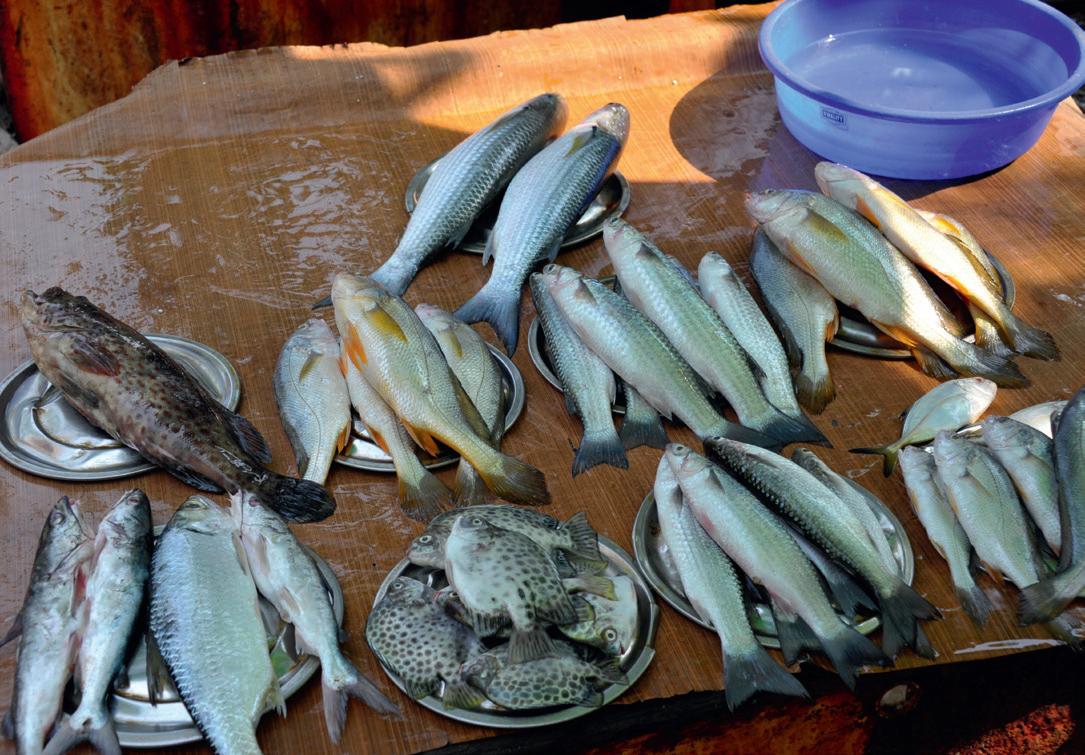
experts. Together, they have identified 20 possible anthropogenic pressures on inland waters that are suitable as meaningful indicators of emerging threats and problems in river and lake systems.
These indicators, which serve as a basis for the assessments, are combined with literature references and expert opinions. In total, more than 9,000 scientific articles were used and supplemented with statements from 536 experts from 79 countries who have detailed specialist knowledge of almost 100 inland waters. The experts determine a threat score for the water areas with which they are familiar on a numerical scale of one to ten. Scores of 1 to 3 stand for ‘low pressure’, 4 to 7 for ‘moderate’, and 8 to 10 for ‘high pressure’. Although the process is very complex, it enables a relatively objective assessment of the state of global inland fisheries.
Since 1971, the FAO has regularly assessed the state of fisheries and marine resources. The results have been published every two years since 1995 in the State of World Fisheries and Aquaculture (SOFIA) reports. However, the current evaluation methods have hardly changed since 2011, although both resources and fisheries have changed significantly. The FAO has therefore decided to thoroughly revise them and adapt them to the current developments in global fisheries. An important step in this project is the revision of the list of fish stocks in the various regions of the world. The current list does not adequately reflect the changed reality of global fishing. As part of this modernisation project, there are also plans to revise the reporting formats for data collection. They should be more granular
status of stocks can only be successful if national governments and regional fisheries organisations expand their capacities and cooperate even more closely than before.
And what does all this mean for the FAO’s statements on the state of fish resources, sustainability of fisheries and the extent of overfishing? Inadequacies in data collection and processing are undeniable and probably unavoidable. For this reason alone, one could ask whether harsh judgements on the extent of overfishing are really justified in their stringency. Meticulously precise percentage figures on the share of overfished stocks worldwide, accurate to the decimal point with tens of places behind them, give the impression of a level of accuracy that the data foundation used does not allow.
and more transparent for all parties involved. Closer cooperation with fisheries experts and management institutions in individual countries is also being sought in order to improve the assessment processes. Gaps in the assessment should be closed and the validity of the information improved.
Important elements of the new methodology, such as data collection and the subsequent workflow for processing and reporting were tested for feasibility in FAO Fishing Areas 31 and 37 in 2022. The results were then presented to the Committee on Fisheries (COFI), which advises the FAO on fisheries issues, for review at the 35th session. In order to inform the interested public about the new analysis and reporting formats, the concept is also presented in the recently released SOFIA 2024 report. However, it is already clear that the implementation of the modernised methodology for assessing the
But although some figures may be contestable in detail, the general tenor of the reports cannot be doubted: many fish stocks are not yet fished sustainably, or at least not sustainably enough. In this respect, the FAO’s statements on the status of global fish stocks should perhaps not be seen as indisputable truths, but rather as a warning and a reminder to act. They put a finger in an open wound and remind us of what must definitely change in the future, because overfishing not only endangers the biodiversity of aquatic ecosystems, but also reduces the productivity of fisheries with serious economic and social consequences. It is worth continuing efforts to rebuild the overfished stocks because their use according to MSY principles ultimately pays off for everyone. According to cautious forecasts, sustainable development could lead to an increase in catches of around 16.5 million tonnes with a total value of 32 billion US dollars. Manfred Klinkhardt
The fishing sector is a field steeped in tradition that values personal connections, where a simple handshake holds significance. Numerous players in this sector struggle to embrace digital trading platforms, which, despite their benefits, can feel impersonal. However, it seems that this mind-set is shifting: Online portals, App Stores, and e-commerce platforms are now playing a more prominent role in the fish trade.
The hustle begins very early, at 5 a.m. and often before sunrise. Everyone involved knows their tasks. The fish is ready, is inspected and, when the auctioneer begins his chant, the auction floor heaves with a combination of adrenaline and testosterone. Just a little later there is peace again. The boxes of freshly caught product have been sold and are on their way to processing plants, wholesalers, restaurants, and supermarkets. It’s been like this for decades. The fish business works in line with well-established rules and is still predominantly “offline”. Besides phone calls, emails, or the occasional WhatsApp message, the processes have barely altered. The people involved usually know each other and are part of regional networks. Despite all this functioning smoothly, the fish and seafood industry at this level remains a risky professional gamble. There are numerous product varieties available in different sizes and qualities. Those who purchase perishable goods that depreciate in value with each passing hour at fluctuating prices without secure purchase agreements and anticipate being able to resell them quickly and profitably may face significant challenges. The European fish market, with an annual trading value

surpassing 140 billion euros, consists of a network of 140,000 businesses. Each of these businesses possesses distinct preferences, specific quantity requirements, and varying price ranges.
Throughout the supply chain from catch to plate, a fish typically changes hands on average around seven times. The clock is ticking! Time is of the essence as the fish should ideally reach the customer within three days latest. Operating under this constant pressure is really no fun and that is why an increasing number of companies in the traditionally ‘ultra-conservative’ fishing industry are embracing digitalization
to streamline their routines and processes. This could definitely be seen as a revolution, especially considering the fact that while the acceptance of digital innovations is increasing in almost all areas of the economy, there has been little movement in the fish trade for a long time. Nevertheless, it is crucial to rethink our approach now. To stay relevant in the future, it is essential to keep up with the on-going global developments. Although we are still in the early stages, there is already a noticeable inclination in many parts of the world to rely on data-driven trading platforms for even fundamental business processes like purchasing and selling goods.
Business-to-business portals (B2B) that directly connect buyers and sellers are particularly impressive, often showcasing above-average growth rates.
This is by no means a passing trend. Business-to-business marketplaces are likely to become permanent fixtures due to the compelling benefits they offer. Apart from the wide variety of fish and seafood available, this also encompasses the monitoring of crucial production and trade information, as well as price fluctuations in the retail sector. Through big data platforms, these vast amounts of data can be analysed in real-time, facilitating
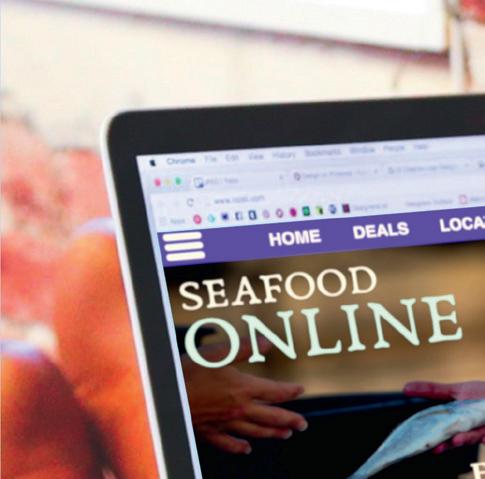


the identification of significant trends, strategic decision-making, and risk management. Seasoned fish traders who have traditionally relied on their intuition may understandably find it difficult to entrust their business to rational algorithms that do not consider established relationships and personal connections.
Digitalization is happening slowly but surely
However, digitalization has already made significant progress and gained momentum in certain sectors of the fishing industry. This particularly applies to the monitoring and control of aquaculture and fisheries, as well as the utilisation of artificial intelligence (AI) and the Internet of Things (IoT). In the realm of aquaculture, data
analysis platforms have proven instrumental in optimizing production, overseeing fish growth and health, minimizing labour requirements, and reducing production costs. For instance, e-fishery’s Smart Feeder, an automated feeding system, collects crucial data on fish growth and adjusts feeding patterns accordingly. XpertSea platform uses image recognition systems to detect shrimp growth rates and assess their health. AquaByte utilizes AI technology to monitor the infestation and growth of sea lice in salmon populations. Conversely, Aquacloud operates as a platform that harnesses high-resolution sensors from the IoT to gather vast amounts of data, which is then transmitted to other devices within closed networks. This comprehensive data collection and analysis can prove invaluable in assessing the
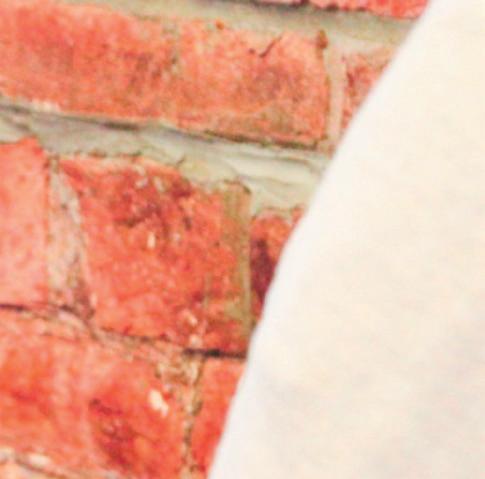

magnitude and severity of a sea lice infestation, enabling prompt implementation of necessary control measures if required.
Remote-controlled vehicles, such as aerial or submersible drones, enable inspections to be conducted without the need for individuals to be physically present on site. Within the aquaculture industry, ROVs such as the Deep Trekker underwater drone are used to manage net enclosures and their anchors at depths reaching up to 100 meters. Additionally, the Aquascape mapping tool platform assists shrimp farmers in overseeing the water quality and detecting potential disease outbreaks in their shrimp ponds.


Digital platforms play a crucial role in the fisheries sector, primarily focusing on monitoring and optimizing sustainable fishing practices and predicting oceanographic conditions. Platforms like SkyTruth and SnapIT utilize a range of technologies, including satellite data, artificial intelligence, and cloud systems, to monitor ship activities at sea. The foundation of these platforms lies in automatic identification systems (AIS) and transceiver positioning systems, which are now installed on more than 200,000 ships worldwide, providing valuable information about their whereabouts. One significant area where these platforms are instrumental is in combating illegal, unregulated, and unreported fishing (IUU). The integration of modern electronic technologies, such as GPS monitoring and video feeds, has made it increasingly challenging for illicit fishermen to conduct their operations. In some


Direct communication between suppliers and buyers allows for the delivery of fresh, frozen, or processed products directly to their final destination. This not only saves money but also ensures that the desired goods reach the customer faster and in better quality, without the need for intermediate storage.
instances, ship tracking technologies and data collection platforms are even being incorporated into supply chains. This is made possible by the accurate tracking capabilities of fishing authorities, who can monitor the locations, routes, and speeds of vessels at sea. When combined with electronic catch documentation that reveals the quantity and species of fish caught, these platforms create optimal conditions for complete traceability. Furthermore, advanced image recognition systems like FishFace, powered by artificial intelligence, have proven to be remarkably effective. They can identify individual fish species, as well as determine their size and quality. Similarly, TunaScope and GoMicro are powerful tools that classify tuna based on various quality criteria.
Digitalization has made significant advancements in various aspects of aquaculture, fishing, and fish processing, and its acceptance is steadily growing. However, when it comes to B2B trading, there is still a considerable amount of scepticism and reservations. This hesitation can be attributed to the emotional factors involved, as from a purely rational standpoint, digital platforms offer numerous advantages. Business-to-business portals in the digital realm connect buyers and sellers from all around the world, enabling transactions at any time of the day or night. Unlike traditional fish shops, these digital platforms eliminate the need for physical meetings
at specific times and locations. Previously inaccessible markets are now open, thanks to the virtual space of global online trading. This opens up unexpected opportunities to discover new products. Furthermore, direct communication between suppliers and buyers allows for the delivery of fresh, frozen, or processed products directly to their final destination, bypassing costly intermediate steps. This not only saves money but also ensures that the desired goods reach the customer faster and in better quality, without the need for intermediate storage. The use of the internet for commercial transactions also enhances transparency and simplifies the documentation requirements for traceability.
However, not everyone is convinced by these arguments. The
B2B seafood sector has faced significant challenges with almost all commercial digital projects initially struggling or failing. According to estimates from the Russian digital online marketplace Yorso, a few years ago, less than 0.7 per cent of fish sales were conducted online through business-to-business platforms. Although the market share of digital trading platforms is expected to be much higher now due to strong growth, the reluctance of buyers and sellers is still evident. This reluctance stems not only from mistrust, traditions, and conservatism within the seafood industry, but also from the diverse and confusing nature of the supply side. Each digital marketplace operates on a different model, with some charging trading commissions, others requiring service fees, and some even requiring registration as a platform member beforehand. Additionally, buyers and sellers often need to provide proof of authorization to trade seafood and demonstrate their creditworthiness. Credit and product insurance may also be necessary. The easiest transactions usually occur on platforms that offer not only products but also suitable financing options, secure payment systems, logistics services, and assistance with customs formalities and official certificates. Essentially, these platforms provide a double benefit to users. Some platforms keep the identities of the parties involved ‘secret’ during the initial stages of a transaction, only revealing their data once the deal is signed and confirmed. Others operate with transparency from the beginning, allowing participants to rely on their good reputation. E-commerce platforms and online marketing not only enhance visibility but also increase brand awareness.
B2B online trading requires a fair amount of trust from both buyers and sellers because such transactions are always accompanied by many questions. Does the quality of the goods correspond to the promises? How and where can I complain about defects? Who is liable for delivery failures and when will I get my money back? And above all: What does it really cost when the often hidden fees for service, packaging and transport are added? If these fundamental aspects are not clear or are misrepresented, achieving success becomes challenging. Buyers seek clarity and transparency in their transactions, and the presence of unrelated services like blogs or videos on online platforms does not alleviate these concerns. It doesn’t help much when online platforms try to spice up their range of services with additional offers such as blogs, cooking tips, or videos. E-commerce platforms serve as marketing tools to attract a wider customer base and boost sales through product promotions. Many traditional retailers have embraced online trading platforms to reach more customers, a strategy that has proven beneficial during the pandemic. However, conducting business online comes with risks, especially in the digital era and the influence of social media: Negative reviews can swiftly tarnish a company’s reputation.
However, the decisive key factor for the success of any online sales is and remains trust. The operators of the digital B2B platforms that dominate this business worldwide and whose sales grow from year to year have particularly understood this. The international market leaders in online
business include platforms such as eWorldTrade, SeaFoodDemand, Seafood Xchange, MadeIn-China, G-Fresh, Procsea, Meatex.Co, HKDTC, DHGate and Alibaba. Platforms like Alibaba have millions of items listed on their websites, fish being one of many. Most have specialized exclusively in seafood and offer a variety of fish and seafood products that are difficult to manage. These platforms vary in terms of specialization, product offerings, transparency of data, minimum order quantities, provider disclosure, and price negotiability.
In certain markets, B2B platforms for fish and seafood are facing challenges, while in others they are gradually gaining traction. At first glance, the situation in the direct-to-consumer sector seems to be quite similar. In this case, providers are also attempting to reach potential buyers through e-commerce offerings on the internet. However, the target audience here is not professional buyers like processors or dealers, but rather the end consumers themselves. Instead of purchasing fish and seafood products from supermarkets or speciality retailers, they can now have them conveniently and timely delivered to their homes. The conditions for this shift are favourable due to the increasing significance of the internet as a consumer sales platform. Who would have anticipated years ago that it would become commonplace to order clothing, shoes, books, or even book a vacation online? The willingness of customers to have their desires fulfilled by businessto-consumer providers (B2C) such as Amazon, Alibaba, eBay, Airbnb, Uber, Menulog, Wotif,
or Expedia is substantial and continuously expanding. Therefore, it is logical to consider purchasing fish and seafood in the same manner.
Despite the favourable conditions, the number of B2C platforms that have successfully established themselves in this complex market area remains quite limited. In Europe, notable examples include HavFriskFisk (Denmark, now defunct), Kivikala (Estonia), Fisch vom Kutter (Germany), and La Pescadería de mi Barrio (Spain). While start-ups continue to explore this business model, many of them face failure. This can be attributed to the stringent requirements for traceability, secure financial transactions, and data protection. Often, these bureaucratic hurdles are underestimated. Additionally, the intricate logistics involved pose a significant challenge. Delivering fresh and highly perishable foods like fish and seafood directly to the customer’s doorstep is akin to the advanced level of mail-order business. If the customer is not available during the delivery, the fish, and consequently the business, may be compromised. Returns, which are common for items like jackets or trousers that don’t fit or meet the buyer’s preferences, are practically irrelevant when it comes to fresh fish. Even experienced platforms like Amazon, which introduced AmazonFresh in 2007, have encountered difficulties in this regard. Consequently, many providers now limit their services to specific and well-defined areas, preferably in large cities. In Australia, for instance, online orders outside the designated core regions are only delivered to airports equipped with secure storage facilities for chilled or frozen food. Customers are then required to collect their orders from these locations themselves.
In comparison to frozen goods, the B2C business with fresh fish still poses significant challenges and requires a considerable amount of time. However, when it comes to delivering frozen smoked salmon sides or tuna fillets to customers’ homes, it has become almost routine for some. Despite the difficulties, online platforms and eCommerce continue to be appealing in the fish and seafood trade and are expected to grow further. Not only trading platforms, but also numerous processing companies are now venturing into this market to bypass intermediaries and directly reach end customers. Internet marketing provides a valuable opportunity for small craft businesses, especially those catering to niche markets and previously limited to regional operations, to gain widespread recognition and sell their products. When storage shelves are unavailable, this option often becomes the only viable choice.
The seafood online platform business model is still in its early stages. It began with platforms like Syunzai Circulation System Service (Japan, 2009), Yorso (Russia, 2014), Gfresh (China, 2015), InterFishMarket (Switzerland, 2016), ProcSea (Europe, 2016), and TunaSolutions (Australia, 2017). These were soon followed by other providers such as ShoreTrade (Australia), Seafood Souq (United Arab Emirates), Marine Fish Trade (Norway), and Seafoodportal (Norway). It is likely that more companies will join the market in the future. The long-term success and market position of these platforms is difficult to predict. However, it is evident that such sales models have a promising future. Manfred Klinkhardt
An Icelandic fishing and processing company, Brim’s mission is to increase value creation in the fisheries sector for the benefit of all its stakeholders—employees, customers, shareholders—and more generally for society as a whole, as well as for the environment. The company focuses on pelagic stocks and groundfish which it catches and then either processes on board or in factories on land. Generating the most value from the raw material calls for innovation at all levels both in processes and products, but also in collaboration with other companies, institutions and ministries. Leading these efforts is Sveinn Margeirsson who holds the title, director of innovation and climate change. Here he explains Brim’s strategy and his role in bringing it to fruition.
Your title is director of innovation and climate change. What are the responsibilities that go with this position? Does combining innovation and climate change imply that any innovation needs to consider its impact on climate change or that innovation is targeted speci cally at mitigating Brim’s impact on climate change?
My role is to contribute to increased value creation in Brim’s operations and the society we operate in and to lead our operations in the eld of innovation, product development and counteracting climate change. I work across di erent divisions of Brim and facilitate collaboration with other companies, universities and institutions in the eld of sustainable utilization of raw materials and low-carbon operations. e answer to the impact question is “both”, but we put more emphasis on using innovation as a tool to support the actions of Brim towards climate mitigation and climate change adaptation.
The UN SDGs 9 (Industry, Innovation and Infrastructure), 12 (Responsible Consumption and Production), and 14 (Life below Water) are of particular relevance to the
company. Can you provide some examples of innovations at Brim that have contributed to these goals?
ere are quite a few examples of these. Brim has been working extensively with the Icelandic Marine Research Institute, contributing to better understanding of our oceans, with shing gear developers aiming for lower energy consumption during catching, to name some examples impacting SDG 14. By increasing utilisation of our catch, which is a key goal of Brim, we strongly support responsible production of healthy, nutritious food, with very low carbon footprint (SDG 12). Investments in infrastructure, such as electrical connections of vessels are paving the way towards a green transition of Icelandic society and supporting the climate policy of the Icelandic government. ose are only a few examples that I could mention.
What in uence has the fourth industrial revolution (Industry 4.0), including the Internet of ings, blockchain, robotics, and more recently, arti cial intelligence, had on Brim’s operations including on training and capacity building among employees? How does
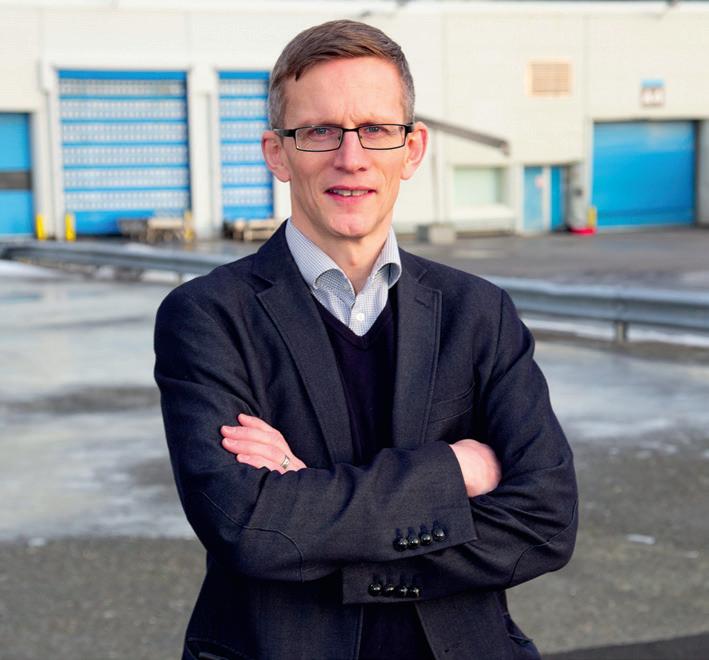
the company stay abreast of these developments, and does it also contribute to them?
In our view, the fourth industrial revolution is no revolution, but more a large step in a development process that has been going on in the Icelandic seafood industry—and worldwide and across industries of course—in past decades. Brim has worked for years with innovative companies, such as Valka, Marel, and Vélfag, with the aim of automation of processes, data collection, and

implementation of robotics and precision production. e data collection has resulted in internal innovation, for instance regarding environmental reporting, which has now led to the establishment of a spin-o company, Stika Environmental Solutions (see box), that focuses on automatic environmental data collection and reporting.
From statements by the CEO to the release of annual sustainability reports, it is apparent that Brim is committed to the
sustainable use of resources and to continuously reducing the environmental impact of its operations. With reference to the eet, have any targets been set to reduce its carbon footprint and how is this to be achieved?
We have a goal of lowering the carbon emissions of our vessels by 2 annually and lowering our greenhouse gas intensity (tCO2eq/million EUR) by 40 from 2015-2030. In many ways communication is key to achieving this. We keep an active discussion between our mechanics, captains, eet managers, and processing managers. Such discussions spin out ideas and contribute to management adjustments that help achieving our goals. Technology development and investments are also important, for instance, to improve utilisation of energy onboard our vessels.
Among the impacts of climate change on the oceans is higher water temperatures. is in turn can cause sh stocks to migrate in search of more hospitable environments potentially a ecting quotas and catches. Have Brim’s shing e orts been a ected by such developments,
and how does it adapt to changes such as these, on which it has little in uence?
It is di cult to give a decisive answer on the impact of climate change as such, since natural variability in temperature of the oceans can be quite substantial. We work with scientists regarding this and put emphasis on understanding what potential changes are impacting our operations. A part of this approach is strengthening our team, which includes Dr Kristján Þórarinsson, who has extensive experience in the eld of marine ecology and biodiversity.
e use of plastic is widespread in the seafood industry for example in shing gear (nets), logistics (tubs), and retail product packaging. While recycling is one way of reducing plastic consumption, have biodegradable materials reached the stage where they o er an economically viable alternative to plastic? What is the company's strategy with regard to plastic?
We use plastics in our packaging and I do not nd it likely that plastic will be replaced fully anytime soon, given the
Brim’s environmental management system has been the cornerstone in implementing the company’s climate policy. The system was developed internally, but the operation and further development of the system are now in the hands of Stika Environmental Solutions. Stika was spun out by Brim in 2022 to enable more companies than Brim to use the environmental management system. Shareholders today include Brim and other Icelandic food producers, as well as professional investors and employees.
Brim uses the system to keep track of greenhouse gas emissions from burning fossil fuels and refrigerants (Scope 1), water and electricity consumption (Scope 2) and emissions in the value chain, e.g. packaging, transport, and waste generation (Scope 3). Information obtained from the Stika system combined with that from other systems in use at Brim will identify opportunities for improvements through internal discussions and by facilitating decision making on matters such as long-term investments and the efficient utilisation of raw materials. The goal is to improve value creation and minimise environmental impact.
The data also enables analysis of climate-related risks and provides a better understanding of which climate-related factors have the most impact on the company’s operations. As such, the availability of data is key to implementing the CSRD (Corporate Sustainability Reporting Directive) framework and conducting a double materiality assessment.

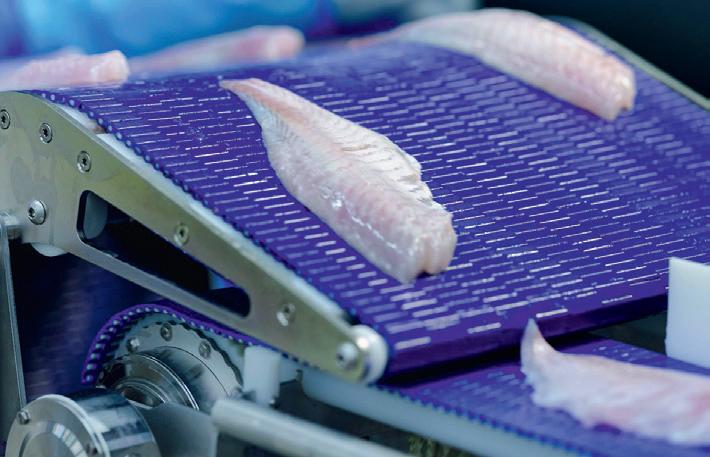
importance of good packaging when it comes to minimising food waste. Regulations on food contact materials are slowing down the uptake of recycled plastic, but Brim focuses on using recycled plastic whenever possible. Quite a few biobased solutions are being developed and Brim is following these developments closely.
Brim is mainly involved in primary production ( shing) and processing the sh into fresh and frozen products for human consumption, as well as into shmeal and sh oil. Where do you see the company in, say, ve years from now? Will it have moved into new areas, aquaculture, for example?
The goal of Brim is to increase value creation in the fisheries sector, in harmony with society and the environment. We have achieved good financial results with that goal and produce high-quality food, with very low carbon footprint, while supporting innovation and development of the society we operate within. So, in my view, the current strategy is a successful one. Yet, with the current pace of change all around us, we cannot expect that the previous strategy will be equally successful in coming years, but it is not up to me to decide upon changes in the overall strategy of Brim; such changes are up to the shareholders and the board of the company.

Ukraine has always been largely dependent on fish imports, which comprise about 85% of the seafood consumed in the country, and the importers play an important socio-economic role in securing fish and seafood supply. Eurofish spoke to Vasyl Danalaki, CEO of the UkrRiba Group of Companies—one of Ukraine’s largest importers of fish and seafood—who explained how the right balance between trading fish and meat products helps the group sustain the business.
This is the eighth in a series of articles in Eurofish Magazine dedicated to seafood businesses in Ukraine and how they work and survive during the war.
In the late 1990s and at the beginning of the 2000s, Ukrainian consumers preferred cheaper sh, and about 50 of the market comprised herring and mackerel. By 2005 the purchasing power of Ukrainian consumers had increased resulting in the growth of demand for more expensive species such as ground sh and salmonids.
UkrRiba (UkrFish) was founded in 2005, in the city of Lviv, in western Ukraine, about 70 kilometers from the Polish border. In the beginning, it was a small company that focused on imports and trade in frozen sh. Later, following consumer demand, meat and poultry were added to the range. Over the years UrkRiba has diversi ed its business adding new activities such as sh and meat processing, transportation, as well as expanding geographically by opening branch o ces in di erent parts of the country.
From a small importer UkrRiba developed into a group of companies involved in purchasing, processing, and logistics. Fish and seafood are sourced from
around the world: Argentina, Canada, China, Iceland, Norway, Spain, Uruguay, and beyond. e group focuses on products in the medium-price segments; hake, herring, mackerel, and sprat comprise about 80 of the sh imports, plus other species such as saithe, blue whiting, Alaska pollock, hoki, tilapia, and pangasius. Before the pandemic, the range also included salmonids and roe; however, these imports have stopped, as consumers switched to more a ordable “table sh” as it is called locally— sh that are traditionally cooked and consumed at home.
Meat and poultry are imported only when the import prices are better than the local, but this does not happen very often, so the segment is 90 based on domestic supplies, while the remainder is imported mainly from neighbouring Poland—cow and chicken livers, and minced meats.
e array of products includes frozen sh, frozen and fresh/ chilled meat and chicken, sh and seafood preserves, salted and smoked sh, meat sausages and canned meat, marinated chicken and chicken cuts, laminaria salad, meat and poultry by-products, Mr Vasyl Danalaki, CEO of the
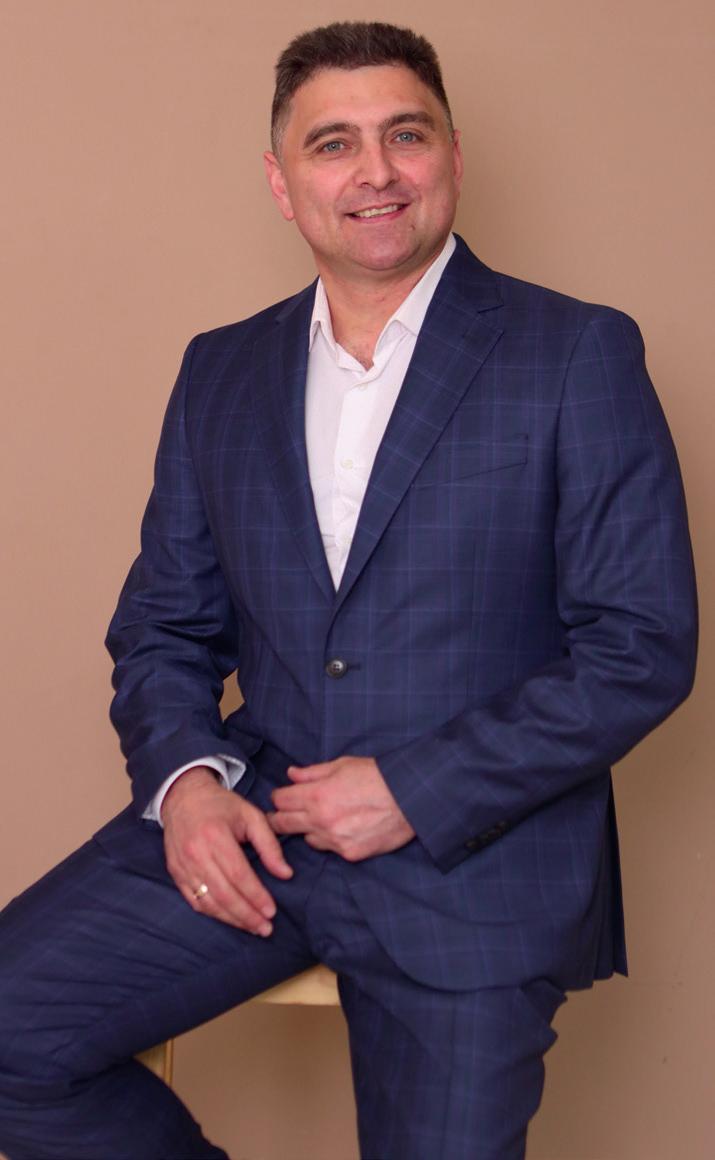
and more—over 500 items in total. e UkrRiba group is on the top-10 list of Ukraine’s seafood and meat importers, and on the top-20 list of the country’s largest processors.
By the beginning of the war, the group employed about 300 people and had nine branch o ces: Ivano-Frankivsk in the west, Kyiv in the north, Cherkasy and Kropivnitsky in the central part of the country, Odesa in the south, Dnipro, Zaporizhzhiya, and Mariupol in the east. It possessed about 100 refrigerated delivery vans and had around 10,000 m2 of o ce, production, and storage area in total.
War is nothing but a stick in the wheel
e war a ected every facet of the group’s business—imports, production, sales, markets, logistics, and employment. Five of its nine branches were shut down leaving only Lviv, Odesa, Cherkasy, and Dnipro operating. e pool of clients shrank from 1,200 to 800. Many employees ed or were drafted into the army and now the sta amounts to 250 employees where 10 are refugees and about 50 vacancies still wait to be lled. Power outages at storage facilities created a high risk for frozen products in particular. e problems included direct damage: at the beginning of the war, the blast from a Russian missile targeting a nearby airport destroyed the windows of UkrRiba’s processing unit, and in October 2023 a drone fell about 50 meters from the main o ce and burnt down the group’s warehouse—the re lasted for three days.
Foreign trade has been negatively a ected in many ways. When the port of Odesa was shelled, about 20 of the group’s imports routed through the port were streamed

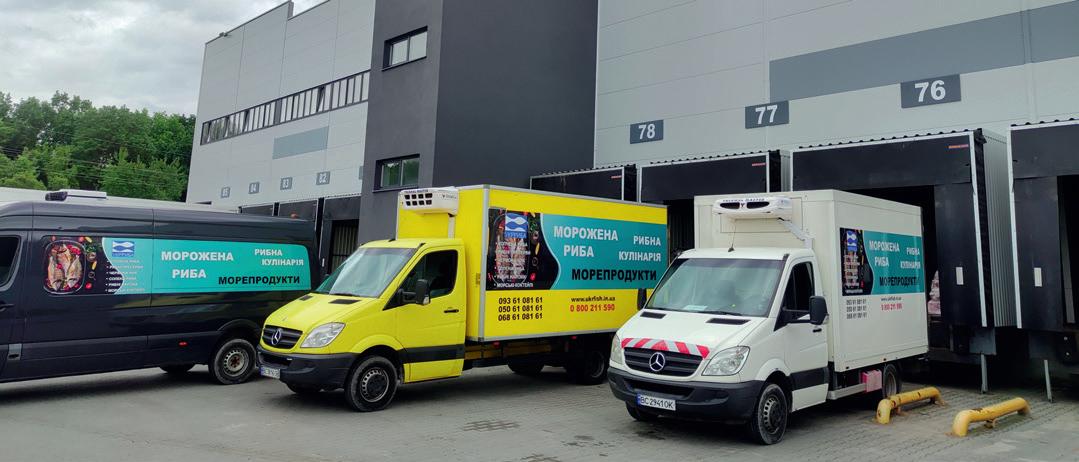
instead through the Lithuanian port of Klaipeda. is hub is now responsible for about 95 of the group’s sh import volumes. Imports were also heavily a ected by energy prices and by striking workers at the Polish border. Moreover, the group has about 40 foreign partners worldwide, explains Mr Danalaki, and about half of them are afraid to do business with Ukraine, considering it as nonsecure. None of the EU insurance companies will issue insurance certi cates for exports to Ukraine.
With the beginning of the invasion, thousands of refugees from di erent regions of Ukraine escaped to its western areas. It helped that people are very supportive, says Mr Danalaki, - I don’t know any Ukrainians who locked themselves in isolation and did nothing. For several months we supported about 12 schools where the refugees were accommodated—100 to 300 people per school. ey all needed food, and we supplied them 300 to 500 kilos of sh for free every day or every second day. Even nding enough drivers was a huge problem and it took us about a month to solve it. I cannot give the exact gures of
the total volumes supplied as we didn’t do it for the record.
Currently, UkrRiba has several contracts with the Armed Forces of Ukraine and supplies them, as well as other units involved in defence, with sh, meat, and other products.
things you can change, leave the ones you cannot, and distinguish between them
e war plunged everyone into a state of stupor and created numerous problems. Measures—sometimes tough—had to be applied to minimise the losses and to keep the business a oat. First of all, to convince people to return to their jobs or to nd new sta and secure their employment and wages. en, to ensure the power supply by purchasing power generators. But the most crucial was to change the structure of the trade. During the months of war, smiles Mr Danalaki, we have actually switched from UkrFish to UkrMeat. e 60/40 balance between sh and meat has been swapped around.
anks to such exibility, UkrRiba has not lost any of its generic sales volumes, and has even increased them slightly. Its own processing volumes are growing and the group is close to reaching a production
of 1,000 tonnes per month. Our strength, explains Mr Danalaki, is in our ability to adapt to the market, to be exible, and to balance.
Can a war teach anyone anything?
War is very stressful, and crises bring out the best and the worst in people. It is a litmus test showing who is who, says Mr Danalaki. We have learned not to keep all our eggs in one basket—as an example, we now have several smaller storage locations instead of a single large one. We became more conscious about the availability of a reserve power supply in case of an emergency, safety measures, accessibility of re extinguishers, and dozens of minor things. We were not paying enough attention to these things before the war, but they have become much more important. Such lessons are costly.
When the war ends, dreams Mr Danalaki, I hope people will start spoiling themselves with delicious products, that they will have more celebrations. And most importantly—with a festive feeling, because a celebration without a festive feeling is not a celebration.
Aleksandra Petersen, aleksandra@euro sh.dk
decades of analysing
A unit in FAO’s Fisheries and Aquaculture Division, GLOBEFISH is responsible for providing information and analysis concerning the global trade and markets in fisheries and aquaculture products.
Fish and seafood have long been the most highly traded animal protein in the world, a trade that has been increasing. According to the latest SOFIA report (State of World Fisheries and Aquaculture 2024), the international trade in aquatic products involved over 230 countries and was valued at USD195bn in 2022, almost a fifth more than the pre-pandemic level in 2019. With its market reports, trade information, and price data GLOBEFISH identifies and analyses some of the trends in the global seafood market. This year GLOBEFISH celebrates its 40th anniversary and to mark the occasion, Eurofish, which since its inception in 2002 has collaborated with GLOBEFISH, interviews Audun Lem, now deputy director of the Fisheries and Aquaculture Division, who has been associated with GLOBEFISH for much of his career at FAO.
This year GLOBEFISH celebrates its 40th anniversary in September. As one who has been involved with the organisation for many years what do you feel are its most important achievements so far, and what are the priorities going forward ?
Maybe the most important achievement of GLOBEFISH is its contribution to the now
widespread recognition that market access is important, that value-chains matter, and that a significant part of the value-creation in the sector takes place in the post-harvest sector. I have observed how this view has evolved, especially at the policy level where in the past the focus was clearly on production, in both capture fisheries and in aquaculture. Today, the ability to enter international markets and to adhere to import requirements is seen as of fundamental importance. Likewise, the role of market and trade analysis and of consumer trends is also growing, including in the outputs of GLOBEFISH.
GLOBEFISH has been the backstopping agency for the other members of the FISH INFOnetwork. While individual members of the network have created profiles for themselves in the regions they serve, there is less awareness of the network itself. How desirable is it for the network to have a distinct identity that is more than the sum of its parts and what would it take to develop this?
There is a fine balance between having strong regional members who all are independent from FAO with their own governing bodies, budgets and priorities and that of FAO and GLOBEFISH

in coordination and backstopping where and when relevant. Each region has its own characteristics but there are strong synergies in working together and economies of scale in capacity building and analysis on a global scale. And this is where GLOBEFISH has its strength.

GLOBEFISH is an acknowledged leader in the provision of information on the global fish trade, an activity that has increased by over a third in the 10 years to 2021. What are the most salient trends in this trade to have emerged in the last years? Do you see a
threat to this development as a result of a worsening geopolitical climate and an increase in trade barriers?
Trade has as you say expanded rapidly with nearly 40 percent of aquatic animal production now entering international markets. At the same time, increasing output has lifted average apparent aquatic animal food consumption to an estimated 20.7 kilos per kg at the global level although there are clear regional differences with Africa and Latin America at less than 50% of world averages. So, there is still strong potential for growth, both in terms of consumption and trade, and production, especially of farmed species, and also some recovery of stocks. It is correct that we have seen a growth in technical trade barriers, especially as relates to food safety. At the same time, several bilateral trade agreements have improved market access for many exporting countries. Overall, as long as the main markets such as the EU, Japan, and the US continue to rely on imports for the bulk of their needs, I do not expect to see any significant changes in the current trade patterns although as you have alluded to, the geopolitical situation has added new complexities.
What are the main trends you expect to see in the aquaculture sector over the next five years. Do you foresee production on land both marine and freshwater becoming a significant contributor to overall farmed fish production, at least in Europe? What are the likely consequences of such a development?
FAO just released the latest issue of SOFIA, the State of World Fisheries and Aquaculture which shows that for the first time in
history, aquaculture now generates higher volumes of aquatic animals than capture fisheries. We expect aquaculture to continue to grow not just in Asia but also in regions such as Africa and Latin America where the potential is significant. It is interesting to note that also countries in the Caribbean and in SIDS (small island developing states) now look towards aquaculture for growing their aquatic food supplies. Europe, and in particular the EU, is of course heavily dependent on imports and even though we will see growth in land-based production thanks to important investments and new production methods, the volumes are not expected to be substantial in the near future. I would also like to mention that aquaculture plays a key role in product development, in packaging and in logistics and I think we will see a strong trend in more advanced products with a basis in farmed raw aquatic food material.
Climate change affects fisheries and aquaculture across the globe to varying degrees. How do you see it influencing the trade in fish and seafood? Will that continue to grow as it has in the past or can a slowdown in trade be partially attributed to climate-related disruption?
Climate change already impacts capture fisheries in several ways with new migration patterns and displacement of stocks as well as in changes in productivity. For aquaculture rising water temperatures opens new opportunities in some geographic areas but also creates difficulties for a number of sites operating today. More unstable weather conditions with extreme weather phenomena increase the need for more robust infrastructure. Fisheries
and aquaculture continue to have a low carbon footprint overall compared to other food systems although there are of course differences between the various species fished or farmed and also depending on feed and production methods. Overall though, we expect trade of aquatic food product to continue to grow and both population and average consumption levels are projected to increase over the next couple of decades.
Despite various initiatives to increase the sustainability of fisheries (Blue Transformation, COFI declaration for sustainable fisheries and aquaculture, FAO’s strategic framework 20222031) the proportion of overfished stocks continues to rise? What explains this discrepancy?
This is correct if we look at the number of stocks, 62.3 percent are fished within biologically sustainable levels in 2021. But if we instead look at the share of landings coming from sustainably managed stocks, we get a different and much more positive picture. In fact, 77% of total landings in 2021 come from commercial stocks that are fished at sustainable levels. This shows that effective fisheries management brings concrete results and that where political will is present, countries are able to turn the situation around with long-term positive results for both the stocks themselves as well as for the communities that depend on them.
A long career at FAO is due to conclude next year when you retire from your current position as deputy director of the Fisheries and Aquaculture Division. Looking back what would you say have been the most encouraging developments
within global fisheries and aquaculture and, on the other hand, where do you think most work remains to be done?
Well, the three most important developments are to me the following: 1. The role of aquaculture which now is more than 50% of total aquatic animal production. 2. The recognition that valuechains, markets, and trade are of fundamental importance for the overall development of the sector. And 3. That sustainability also includes the social dimension and that the wellbeing and decent working conditions for the many millions of people engaged in the sector concerns us all. Finally, and this remains a challenge at the policy level in many countries, that aquatic food systems play a fundamental role in providing safe and nutritious food, generate important economic benefits and sustain hundreds of millions of livelihoods at the global level. We are only 5-6 years away from the deadlines of the UN 2030 Agenda and fisheries and aquaculture certainly play a crucial role in achieving many of them.
And, at a more personal level how does one prepare the move from highly demanding job to a retired existence? What are your plans, both professional and personal, for this next phase in your life?
I am privileged to live in Rome which offers a lot both from a professional and private side. In addition to some consulting and teaching, I will dedicate more time to my personal interests, visit those places I always wanted to see but for some reason never managed to and also pursue my interests in history and take up yoga again. In short, I plan to keep busy and stay active.



Fernando Alonso Navaridas, Vice Ambassador of Spain to Denmark, visited the Euro sh o ce on 20 June. Spain is a Euro sh member country and is represented at the Euro sh governing council by its Ministry of Agriculture, Fisheries and Food. Most o cial dealings between Euro sh and Spain run through the ministry so the guest from the embassy presented an opportunity for Euro sh to expand its links to the country. e visit, instigated by Ixai Salvo, a Spanish member of the team, allowed Marco Frederiksen, the director, to present the organisation and its activities with a focus on those with a Spanish component. ese include an international conference in Madrid on the circular economy within sheries and aquaculture in September this year that Euro sh is organising in collaboration with the Ministry of Agriculture, Fisheries and Food. Another project involving Spanish partners is SAFE (SmartAqua4FuturE) that is funded under the European Union’s Horizon Europe programme and is coordinated by Euro sh. e Vice Ambassador’s visit reinforces the ties between Spain and Euro sh potentially paving the way for new opportunities for Euro sh to collaborate with Spain.

Aquaculture, a mode of aquatic animal production that has grown steadily since the turn of the century, overtook capture sheries in total aquatic animal production in 2022, according to FAO’s recently published 2024 State of World Fisheries and Aquaculture (SOFIA) report. is development promises to boost sustainability across the sector—in addition to addressing the issue of food security. Global seafood consumption has doubled since the 1960s, according to Manuel Barange, director of the Fisheries and Aquaculture Division at FAO. SOFIA anticipates production will increase 10 by 2032 and predicts a 25 growth in production will be necessary to meet the global demand for seafood in 2050. Rising global population in uences seafood consumption, which in turn has an impact on production. To create secure sources of food, sustainable solutions are required to guarantee a supply that can continuously and consistently meet global demand. Aquaculture has
the potential to match increasing demand for seafood worldwide with sustainable practices.
e 2024 SOFIA report notes both the immense successes of aquaculture and areas needing improvement. For example, while seafood is consumed worldwide, 90 of its production is centered in Asia. Meanwhile, Africa’s growing population has seen a decrease in seafood consumption. Accounting for only 1.9 of global aquatic animal production, Africa’s demand for aquatic products easily outweighs their production. One of FAO’s main priorities is to encourage the spread of aquaculture on the continent, especially in sub-Saharan regions. Nutritionally, seafood plays an important role in many low-income countries, and FAO aims to raise awareness and facilitate the development of aquaculture in these regions.
A collaborative e ort is paramount to furthering the sustainability of aquatic animal

THE STATE OF

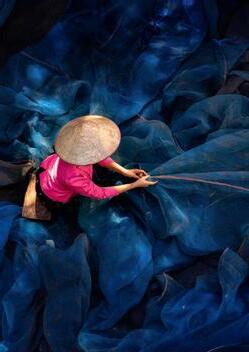

The latest edition of FAO’s flagship publication highlights the role of sustainable aquaculture in providing food, nutrition, and livelihoods for a growing world population.
production. Regarding capture production, Dr Barange warns that while 62 of sh stocks are sustainably harvested, 38 are not; these failures are systemic and can be mitigated by sharing analyses, political action, and infrastructural change. e next SOFIA report will be released in two years and will hopefully show further improvements in the sustainability of the aquaculture as well as the capture industries.
20-22 August 2024
Nor-Fishing
Trondheim, Norway
Tel.: +47 73 56 86 40 post@nor-fishing.no www.nor-fishing.no
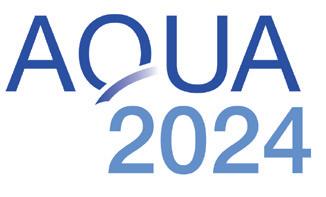
26-30 August 2024
AQUA2024 * Copenhagen, Denmark mario@marevent.com www.was.org

4-6 September 2024
Seafood Expo Asia
Singapore
Tel.: +1 207 8425504 customerservice@divcom.com www.seafoodexpo.com
11-13 September 2024
Polfish * Gdansk, Poland monika.pain@mtgsa.com.pl https://polfishtargi.pl/en/


18-20 September 2024
IceFish * Kópavogur, Iceland ttattum@mercatormedia.com

Tel.: +44 1329 825335 https://www.worldfishing.net/icelandicfisheries-exhibition








10 – 13 December 2024
AlgaEurope 2024
Athens, Grece info@dlg-benelux.com https://algaeurope.org/
1-3 October 2024
Conxemar Vigo, Spain conxemar@conxemar.com https://www.conxemar.com/en/exhibition/
8-10 October 2024
PolarExpo Fishing and Hunting Ilulissat, Greenland
Tel.: +45 99 35 55 55 info@akkc.dk
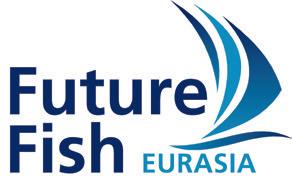
10-12 October 2024
Future Fish Eurasia * Izmir, Turkey
Tel.: +90 212 347 10 54 info@eurasiafairs.com www. eurasiafairs.com
30 October – 1 November 2024
China Fisheries and Seafood Expo (CFSE)
Quingdao, China
Tel.: +86 10 58672620 info@seafarechina.com www.seafarechina.com

12-13 February 2025
AquaFarm* Pordenone, Italy
Tel.: +39 0434 232261 pdeodorico@fierapordenone.it www.fierapordenone.it
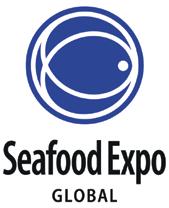
6-8 May 2025 *
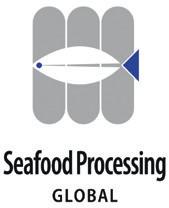
Seafood Expo Global/Seafood Processing Global * Barcelona, Spain
Tel.: +1 207 8425504 customerservice@divcom.com www.seafoodexpo.com
* Eurofish will be attending
Publisher Euro sh International Organisation
H.C. Andersens Boulevard 44-46 DK-1553 Copenhagen V Denmark
Tel.: +45 333 777 55, info@euro sh.dk euro sh.dk
Managing editor Marco Frederiksen
Editorial offices Behnan Thomas (bt) H.C. Andersens Boulevard 44-46 DK-1553 Copenhagen V Denmark
Tel.: +45 333 777 64 behnan.thomas@euro sh.dk
Dr. Manfred Klinkhardt (mk) Redaktionsbüro Delbrück Franz-Stock-Straße 23 D-33129 Delbrück Germany
Tel.: +49 5250 933416 manfred.klinkhardt@web.de
Technical layout Thomas Jensen
Advertising Aleksandra Petersen Euro sh Magazine
H.C. Andersens Boulevard 44-46 DK-1553 Copenhagen V Denmark
Tel.: +45 333 777 63 aleksandra.petersen@euro sh.dk
Frequency 6 issues per year
Circulation 2500 copies
Subscription details
Price: EUR 100,–To subscribe send an email to info@euro sh.dk
Unless otherwise stated, the copyright for articles in this magazine is vested in the publisher. Articles may not be reproduced without written permission from the copyright holders. An electronic copy is available on request to aleksandra.petersen@euro sh.dk
ISSN 1868-5943
Order your free trial info@eurofish.dk



Insulated containers
Polystyrene compressors
Thermal conditioning Margar stærðir og tegundir sem henta ólíkum þörfum
PIONEERS IN HIGH-QUALITY HIGHLY-INSULATED & HEAVY-DUTY FISH CONTAINERS
PROTECTING FRESHNESS AND QUALITY FOR DECADES MADE IN ICELAND
borgarplast.is/en

Pelagic fish processing

Nobbing machines and Auto-packers for sardine and mackerel
Vredenburg South Africa
Mobile: +27 83 2620362
E-mail: easycancc@gmail.com Website: www.easycan co za
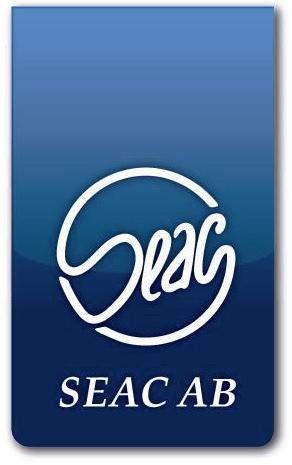
ONE OF THE MAIN MANUFACTURES OF PROCESSING MACHINES FOR BIG, SMALL AND VERY SMALL PELAGIC FISH
Nobbing down to 110 pcs/kg
Filleting down to 100 pcs/kg Up to 450 fish pockets per min
Slånbärsv 4, SE-386 90 Öland Sweden info@seac.se WWW. SEAC.SE
The specialist in fishbox compactors and recycling Tel. +45 97371799 runi@runi.dk www.runi.dk A/S
kettle of fish


Pick up your copy at AQUA24, Copenhagen, 26-30 August 2024


